- Marine Supplies
- Maintenance & Boating Guides

Catamaran vs Monohull: Pros, Cons & Main Differences
By: B.J. Porter Editor

The choice of catamaran vs monohull ultimately comes down to preference. What’s critical for one buyer may mean little to another. If your partner refuses to set foot on a boat which heels, that’s a deal-breaker for a monohull. But if you’re passionate about classic looks and styling, your quest for beauty may override other considerations and rule out catamarans.
We can’t tell you whether a catamaran or a monohull is right for you. But we can help you with the pros and cons of each for your search.
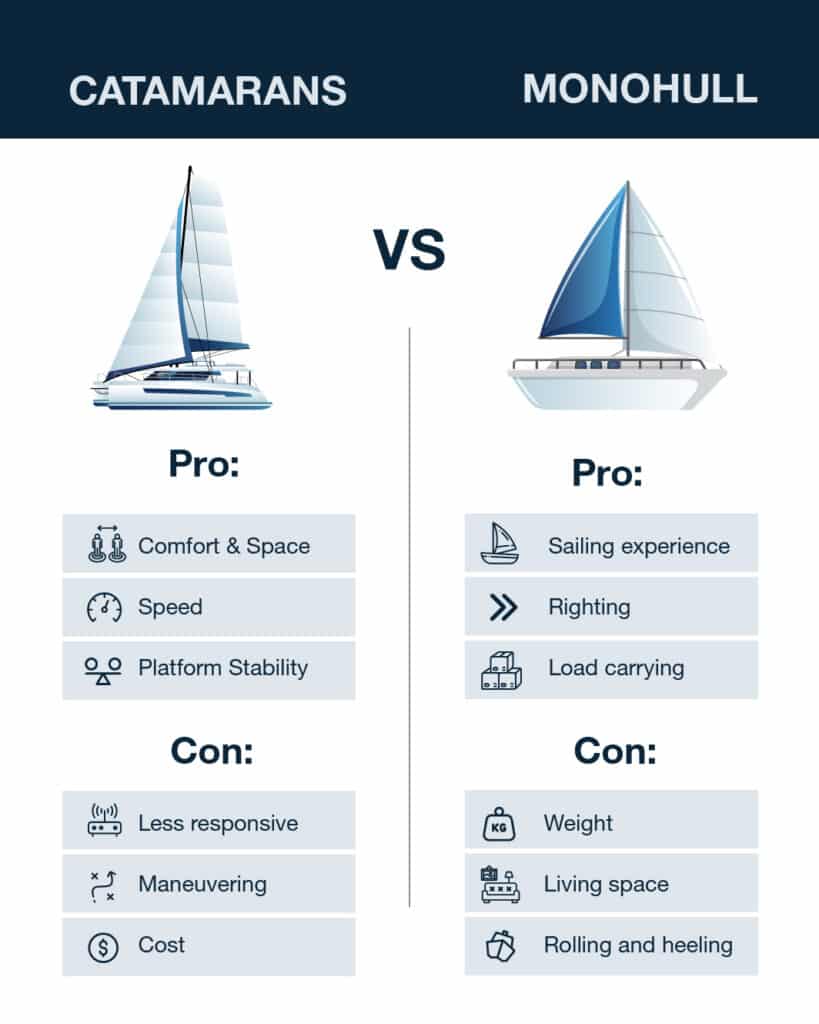
The Strengths and Pros
No matter your choice of monohull or catamaran, there are safe, comfortable, and excellent sailing boats of both types. Neither has an exclusive lock on any strength, and both sail safely and comfortably. But there’s a different emphasis on how they do it. No matter what you are trying to do – sail fast, cruise the world, or just host a crowd at the dock, there are monohulls and catamarans that can work for any requirement.
Catamaran advantages
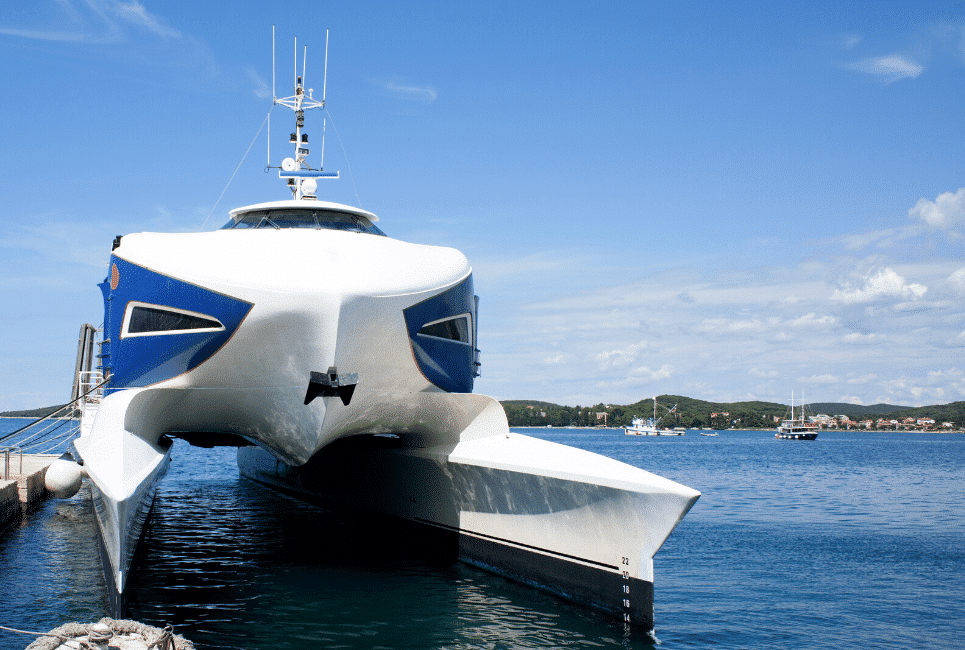
Space and comfort: Two hulls and a wide beam make a very stable platform with lots of volume in the saloon and cockpit. Most living space is above the waterline, with wonderful light and airflow. Cabins in the hulls offer better privacy and isolation, usually with standing headroom.
Straight line speed: Most catamarans are faster in straight-line sailing speed (1) that similar sized or even longer monohulls. Without a lead keel, they’re lighter, so more driving force from the sails converts to speed, and narrower hull forms may have less drag than wide hulls with deep keels. Some heavier cruising catamarans may not be faster, especially if they keep rig size small for ease of handling.
Stability : The beam of two hulls with a bridge deck leads to much higher stability and resistance to roll (2). Waves in an anchorage that induce violent roll in a monohull may make a catamaran bounce or bob. Under sail, catamarans do not heel appreciably even when powered up.
Twin engines. : With one engine in forward and balanced in reverse, most catamarans can spin in a circle in place and make sharp adjustments to the boat’s direction. If you have an engine failure, you also have a second engine, giving a safety edge when you can’t sail.
Monohull advantages

Upwind sailing performance: While catamarans have the edge at straight-line speed, monohulls sail closer to the wind. When you’re racing or you have to sail upwind to get to the next island, this can get you there faster.
Sailing feel and responsiveness : The “feel” of sailing a monohull is much better. With a single hull, you’ll feel wind pressure and trim adjustments immediately for a more responsive helm and a better ability to sail to the wind.
Maneuvering under sail: Monohulls are quite nimble tacking and turning under sail, and there’s less risk of slow or missed tacks.
Righting Moment: The primary offshore safety argument for monohulls is their ability to right when capsized. The heavy keel keeps the boat deck up when sailing, and most monohulls will come back upright even after a complete capsize.
Cargo and Loading: A higher displacement boat with thousands of pounds of lead hung from the bottom isn’t going to be as affected by loading as a relatively light multihull.
Aesthetics: This is subjective, as many catamaran enthusiasts love how they look. Classic sailboat styling, with swept sleek looks, springy sheer lines, and all the “right” proportions are more common on monohulls.
Also read: The 5 Best Electric Anchor Winches
Weaknesses and Cons
Like strengths, weaknesses are relative; just because one class has a strength doesn’t mean the other doesn’t. There are spacious monohulls and beautiful catamarans, just like there are cramped catamarans and unattractive monohulls. The differences have to be highlighted relative to each other, and the weaknesses of one are most apparent compared to the strengths of the other.
Catamaran Cons
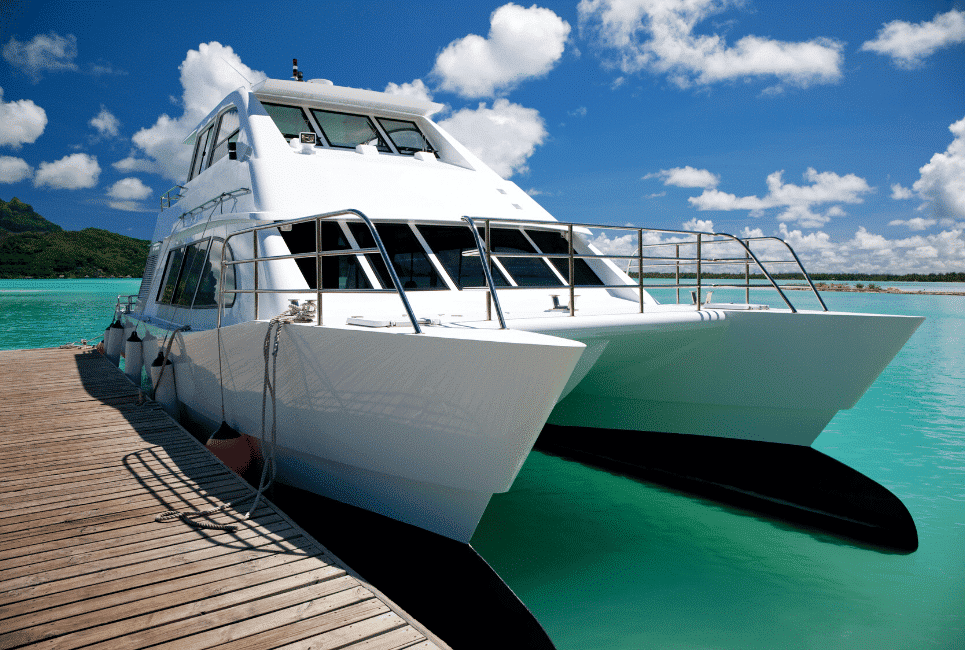
Upwind performance: Cats don’t sail as close to the wind, but they make up for it by sailing faster off the wind. You’ll sail a less direct course upwind. Even if you get in at the same time, you’ll have to sail farther.
Less responsive sailing: Two hulls with two rudders and a very broad platform reduce the helm feel when sailing, cutting responsiveness sailing in shifting wind and wave conditions. It also makes tacking slower.
No-flip zone: It is very difficult, but not impossible, to flip a large catamaran (3). But if a catamaran capsizes, it will not flip back over by itself.
Large in marina/close quarters: You have two problems in marinas. Beamy cats are tough to maneuver in tight spaces because they’re big and visibility is tough over the hulls. And many marinas charge extra because the wide beam extends into the next slip. The good news is that twin engines make tight maneuvering easier.
Price point: Catamarans are more difficult to build and need more materials. This is directly reflected in the cost of the boats.
Monohull Cons
They are heavier: Every large monohull needs a keel for stability (4). They can not sail or stay upright without thousands of pounds of ballast, and this makes them heavier and slows them down. Tiny monohulls can use a centerboard or daggerboard for stability, but most boats big enough to sleep on need ballast.
Darker interiors : Most monohull living space is lower in the boat, where you can’t put enormous windows for light and circulation. It’s very hard to get space as bright and airy as catamaran saloons.
Less living space: With one hull and no bridge deck saloon, most monohulls feel cramped compared to spacious catamarans.
More prone to rolling motions : Only one hull makes monohulls susceptible to rolling in waves, and the movement can be quite uncomfortable.
Heeling: Tipping is just part of sailing monohulls upwind and is unavoidable. It can be reduced on some other points of sail, but not eliminated. Many people, especially non-sailors and new sailors, find this movement uncomfortable or distressing.
You might also be interested in: How to Buff a Boat | A Detailed Guide by a Boating Expert

Troubleshooting Pontoon Boat Battery
Pontoon boats are a great way to enjoy the water and spend quality time with family and friends. But just like any other boat, they rely on a battery to power various systems, including navigation lights, trolling motors, and other…
Boat Accessories

Best Ice Fishing Fish Finders in 2023
In search of the best ice fishing fish finders in 2023? Not all fish finders are created equal, particularly when it comes to ice fishing. Specialized features are crucial to ensure successful outings in harsh winter conditions. You require a…

Best Side Imaging Fish Finders in 2023
Navigating the world of angling equipment can be challenging. That's especially true when it comes to side imaging fish finders, given the extensive range of options available in 2023. This post makes it easy for you to narrow down your…

How to Choose a Fishfinder for Your Boat: A Comprehensive Guide
Today, we embark on a journey to unravel the secrets of choosing the perfect fish finder for your boat. As we navigate through an ocean of options, we'll explore different types of fish finders, delve into their key features, and…
Accessories
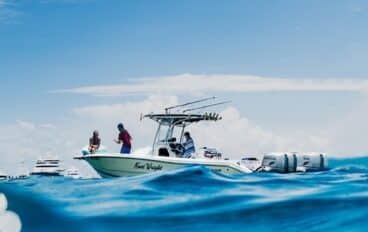
5 Best Portable Fish Finder in 2023
Looking for a portable fish finder for kayaking, ice fishing, or other activities? The good news is that there are a lot of solid products out there. The year 2023 has ushered in an array of advanced models, each brimming…
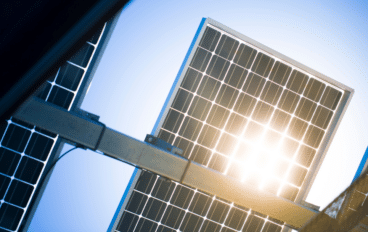
Charging Your Trolling Motor Battery with a Solar Panel
Charging your trolling motor battery with a solar panel is not just the right thing to do for the environment, it is extremely convenient. When you’re out on the boat, with any luck, you’ll have access to a good amount…
Don't miss out
Catamaran vs. Monohull: We Changed, Should You?
There are two schools of thought when it comes to monohull versus catamaran. We have done extensive cruising and lived aboard two monohulls and four catamarans over the past 25+ years . We experienced the good and the bad for both single hull and multihulls first hand. Quite honestly, the pluses for catamarans far outweigh the minuses. There are multiple benefits of catamarans. They are faster, more stable and spacious, and have shallower drafts allowing safer anchorage closer to shore. Being on a stable platform with no heeling cuts down on crew fatigue and seasickness leaving the crew more alert and in control of the vessel. Even novice sailors feel more confident on catamarans.
When we built our monohull Royal Salute in the early 90s, catamarans were not established and were looked upon with extreme suspicion by most cruisers, including ourselves. “Safety and the capsize” issue were always the first things to come up against sailing catamarans. It is a fact that monohulls can get rolled in heavy seas but will right themselves because of the heavy lead keel, and while crew and vessel will be battered, the roll is survivable.
However a catamaran once capsized, will remain upside down (jokingly referring to this state of the catamaran as “reaching its most stable position when upside down”). The inability of a catamaran to self-right was and still is a major bone of contention. However, what is not often discussed is that a monohull has about a 5,000 pound keel of lead that is constantly trying to drag the boat to the bottom of the ocean versus a catamaran that has no ballast and is in most cases with modern catamarans, unsinkable.
So the options are to either sail the world on a boat that, if it springs a leak, will sink like a stone or a vessel that cannot self-right in the event of a capsize but will not sink no matter what. So from a practical point of view, here are our observations over the last 25+ years of living aboard, on the advantages and disadvantages of a catamaran.
ADVANTAGES OF A CATAMARAN
1. speed equals safety.
The speed of a catamaran makes it possible to outrun bad weather. While catamarans do not point as high into the wind as a monohull (or if it does, it makes more leeway or slides sideways), it is about 20% faster than a monohull. This means that even if you sail upwind at a slightly wider angle to the wind than a monohull and have to cover more distance, you will still arrive at your destination long before a monohull.
A modern performance catamaran with daggerboards and good quality sails will point as high as a similar sized monohull. It will point the same as a comparable monohull and sail much faster and therefore arrive at an upwind position much sooner than a the monohull. It is important to note that most of the production catamarans on the market are under-powered and are equipped with standard smaller sails. In lighter breezes many of these designs perform poorly unless fitted with bigger headsails, a Code Zero and a square-top mainsail.
While we believe that more comfortable and safer in rough weather , we have to concede that when the weather gets really bad (60 knots of wind or more) we would personally prefer to be on a monohull from the standpoint of surviving. I would say that a monohull is preferable for serious offshore single-handed sailing because you can more easily hove-to in a monohull. We have been in some extreme weather on a number of catamarans and never really felt that we were in danger, although it takes some nifty seamanship.
A monohull could capsize in extreme weather or even roll in a storm, but they generally come back upright. A catamaran on the other hand, will not right itself. But the cat will generally stay afloat, offering a good place to survive while you wait out the storm or until help comes along. Well-designed modern catamarans are very hard to capsize though.
Having said all that, most catamarans can do 200 to 250 miles a day and with modern technology allowing one to pull down weather at will, there is no good reason why you should get caught in extreme weather. A faster boat is a safer boat as it will in many cases be able to outrun bad weather. With good weather routing information a catamaran can avoid most serious weather and, at worst, place itself in the most favorable position to avoid the brunt of a storm.
2. A Catamaran is a Stable, Safe Platform Underway
Catamarans have no ballast in the keels like monohulls do and therefor it relies on beam and buoyancy for stability. Typically cruising catamarans will have a beam to length ratio of roughly 50%, although many designs nowadays exceed the 50% rule of thumb. So, a 45-ft long catamaran will be about 22-ft wide, providing a very stable platform when sailing. Unlike catamarans, monohulls cannot overcome the rolling and pitching with their narrow beam and the lead ballast for stability.
This rolling and pitching makes the deck on a monohull very unsafe whereas on walking around on the deck of a catamaran while underway is far easier since the boat is much more stable, and it doesn’t heel. This makes sail changes and reefing much easier and a lot safer for the crew. Without the rolling and pitching motion, the danger of falling overboard on a catamaran is considerably less than on a monohull.
3. Crew Fatigue Reduces on a Catamaran
Because a catamaran does not heel over like a monohull, it offers far more comfort underway because the motion is mostly fore and aft pitching and very little beam-to-beam rolling. On all points of sail, a catamaran tracks upright and significantly reduces crew fatigue and seasickness. Seasickness is usually caused by things like anxiety, fatigue, hunger and cold, which all add to a sense of disorientation. This leads the crew to making bad decisions and seamanship errors that could be fatal to the crew and vessel. The more stable platform of the catamaran will hugely keep those issues at bay, making the crew more alert and energized.
Every action and chore including cooking is much easier on a catamaran when underway. It is much more pleasant to be on the deck level looking out rather than being stuck “down below.” It is also much nicer to sleep on a boat that doesn’t heel. I remember nights at sea in our monohull when I was rolling around in my bunk unless I was properly wedge in a little corner. That is simply not the case on catamarans.
All these factors ensure that your crew will not expend unnecessary energy to simply try and stay upright, onboard and safe on a long passage. Your crew on a catamaran will be well rested and alert and will be able to function well if a stressful situation arises.
4. Comfort at Anchor
Catamarans provide a wide platform and therefore offer lovely spaces to relax at anchor without the rolling motion that monohulls have a tendency to do in a swell. During our 15 years of cruising on a monohull, we have often had to leave anchorages that we really were not finished exploring because of a rolly, uncomfortable anchorage. Big rollers or swells coming into an anchorage can make conditions in an anchorage very uncomfortable and unsafe.
We were anchored off Funchal on the island of Madeira in our monohull Royal Salute once, when we were forced to leave our anchorage. The rolling became so bad, we were rolling from gunnel to gunnel. The anchorage became untenable to remain anchored, forcing us to go out to sea in foul weather in the middle of the night. This is an extreme case but believe me, we have left many an idyllic anchorage because of a rolling swell into the anchorage. Catamarans, on the other hand, do not roll from like monohulls have a tendency to do and are far more comfortable at anchor.
5. Anchor Bridal Setup
Catamarans are fitted with a bridle, attached to both bows and down to the anchor chain, resulting in a very stable position at anchor. What we found with our monohull was that because the bow acts as a sail (because of the high freeboard), the boat tended to sail at anchor in high winds. It sailed in one direction until the chain snatched and tacked over and sailed in the other direction, feeling like it might dislodge the anchor altogether. The catamaran on the other hand sits at anchor a lot more stable and doesn’t sail around as much.
6. Ease of Boarding on a Catamaran
Thank goodness we were much younger and more agile during our monohull days. Royal Salute and most monohulls of her generation or older, have high free-boards, making it quite a feat to get onto the boat from the dinghy. It was one of the most challenging things to do because unlike the more modern monohulls that have a scoop at the back, we had to climb up on the side of the boat to get on and off. We, of course rigged steps, etc. but it was always a hassle compared to the ease of getting on and off a catamaran from a dingy or from the water.
7. Shallow Draft Equals Better Anchorages
Catamarans have significantly shallower drafts than monohulls, allowing for safer anchorages closer to shore. Most catamarans in the 40-ft to 50-ft range draw between 3-ft to 4.5-ft, so they can anchor in places that a monohulls can not even consider. In the shallow waters of the Bahamas for example, the catamarans have a big advantage. We often anchor our own catamaran just a few feet away from a beach. It definitely allows one to be able to explore areas where the water is shallow without the fear of running aground.
The shallow draft also allows for emergency repairs in shallow water and even doing the bottom job when the tide goes out as we have done in places like Mtwapa Creek in Kenya, East Africa. The catamaran easily rests on her keels on the sand without help making it a breeze to do the “annual haul out” even in remote locations.
8. Dinghy Davits & Dinghy Size
All catamarans have a set of davits that make it very easy to raise and lower the dingy. Our monohull and most cruising monohulls do not have an efficient or easily accessible set of davits. This makes raising and lowering the dingy an elaborate production. Catamarans on the other hand, has davits systems easily accessible and some even have platforms to rest the dinghy on.
The lack of beam and difficulty of lifting the dinghy also limits the size and type of dingy that one can reasonably carry on a monohull. As we all know, the dingy is your transport to and from shore and diving or fishing spots, so the bigger and faster the dingy, the better off you are. A catamaran can carry both a heavier and bigger dinghy which makes the popular center consul dinghy so much more possible.
9. Interior Space and Comfort on a Catamaran
We sailed 32,000 NM on our 45-ft monohull, happy as clams, not realizing that sailing does not have to be done lying on your ear 24/7 while on passage or sitting knee-to-knee in the cockpit at anchor with your two other guests at the dinner table! One can liken sitting in a monohull cockpit to sitting in an empty Jacuzzi, you are always nice and close to the other folks.
Now that we are on our fourth catamaran, there are a few things that have become more evident to us than the incredible space and comfort of a catamaran, not only at anchor but also underway. The cockpit and living space in general are huge compared to a monohull, making for very comfortable and spacious living conditions. It feels more like you are at home, rather than just on a camping trip.
Knowing that one spends at least 90% of one’s cruising life at anchor, it’s important to have good open living space, which most modern cats nowadays offer. A lot of cats have walk around beds, lots of storage, every modern appliance including washer/dryer, etc. However, one has to fight the urge to fill the space if you want to keep the cat light and fast.
Sailing with guests onboard for extended periods of time, in close quarters can become claustrophobic but on a catamaran people are spread out and separated. With guests sleeping in one hull and the owners in another, catamarans offer much more privacy and separation. Some cats even have privacy doors that will close off the entire hull and has a separate entrance onto the deck, which really separates you from the guests completely.
There is very little heeling on a catamaran, so there is no need for hand grips and safety harnesses inside the boat. There is nothing better (and safer) than being able to walk from the cockpit into the living room (saloon) on one level or one step down at most. In a monohull, when heeling at a severe angle, you would have to claw your way from the companionway steps down to the living area, while fighting to stay upright, significantly tapping your energy.
Unless you hit extreme conditions, everything stays put on a catamaran reducing the anxiety before doing passages of having to stow and secure everything. This very issue makes a lot of cruisers reluctant to weigh anchor and explore more often. It is just too much effort to pack away all your stuff once comfortable in an anchorage!
One thing you will notice is that the stove on catamarans are not gimbaled like it is on monohulls and this should tell the story in itself. The stability and comfort on a catamaran is far superior. Cooking is easy and safer. I often open a nice cold beer, put it down to do something and forget about it only to find a warm beer later in the same place I left it. This is not something that happens on a monohull.
10. Redundancy on a Catamaran
Unlike monohulls, catamarans have a lot of critical redundancies. That of course means two hulls to clean and anti-foul, double the engine maintenance, etc. but having two of the critical equipment like engines for instance, outweighs the downside.
With two engines, if one fails you still have adequate propulsion to go anywhere. If by some fluke the second engine also fails, you have a full set of spares to fix at least one of them. Our friends once hit a sleeping whale off Tanzania, and when it dove, it hit the prop, bending it. They limped into the narrow channel on the one engine but at least they could make it to a safe harbor where we surveyed and repaired their damage.
We often only use one engine when motoring while making passage in order to conserve our fuel. The one engine is totally capable of moving the boat along at a good speed unless you are in heavy seas and you may need more power. Other than that we only use two engines to dock or maneuver the boat in close quarters.
Because there are two engines there are also two independent charging systems via the alternator on each engine. If one alternator goes out, there is still another complete charging system. There are two rudders and if one fails or falls off (as has happened to our friends on a monohull off Columbia, where they almost lost their boat) you have a second rudder that is completely capable of steering the boat by itself indefinitely. That holds true for several things on a catamaran!
11. Maneuverability
The engines are spaced far apart on a catamaran and it makes maneuvering much easier and more precise than monohulls, unless the monohull has a bow thruster. We did not have a bow thruster (not many monohulls do) and had to rely on prop-walk and using prop wash on the rudder. A modern catamaran can do a 360 turn on her own axis. A monohull cannot do this and have a bigger turning circle. However, a monohull under sail is much more maneuverable and certainly will tack a lot faster than a catamaran. The ease in maneuverability under engine on a catamaran in close quarters specifically, is vastly superior comparatively.
12. Rigging
Because of the beam on a catamaran the spinnaker pole has become unnecessary equipment. Hallelujah, I say. That pole on our monohull was a pain the behind and I always hated having to use it. On a catamaran, one can fly an asymmetrical cruising chute or spinnaker, using the bows to tack the clew or run a guy through a block so it is very much simplified, easier and safer.We also sail wing-on-wing with twin headsails when we sail downwind. We use our furling jib and furling Code Zero. It is as easy as one, two, three.
DISADVANTAGES OF A CATAMARAN
1. bridgedeck slamming.
One advantage most monohulls do have when underway is that they don’t slam. Catamarans with a low bridgedeck clearance can experience significant slamming in confused seas sailing upwind. This slamming can be quite disconcerting when you first experience it as we did on a Shuttleworth 44 design, our first ever catamaran experience, 20+ years ago. At times, it felt as though the boat was falling apart. Of course the boat was fine but nevertheless, the stress on the crew from the constant noise and discomfort was significant.
Monohulls don’t have a bridgedeck which means no slamming and are therefore a bit more comfortable than l ow bridgedeck catamarans when beating into severe confused conditions or “washing machine” conditions as we call it. Modern catamarans mostly have better bridgedeck clearance and the slamming is significantly less. However, not all cats have a good clear tunnel under the bridgedeck. Some manufacturers build beds into the bridge deck in order to make more space in the chest of the catamaran where the slamming occurs. These protuberances into the bridgedeck tunnel will likely increase slamming. So be mindful of that when selecting a catamaran. We currently own a Bali 5.4 and the bridgedeck clearance on this boat is more than adequate and the tunnel is clear. We therefor experience very little slamming compared to our Prout 45 that we previously owned (picture of sister ship below) with a much lower bridgedeck.
We Explain Bridgedeck Clearance
In the pictures below, the Bali 5.4 has very good clearance from the water to the bridgedeck and has a nice clean tunnel versus the very low bridgedeck of the Sunreef 50.
2. Sailing Downwind
Monohull spreaders are set at 90 degrees to the mast whereas a catamaran has to have backswept spreaders. The reason is that, on a monohull, there is a backstay and using this, plus the intermediates you can get a nice pre-bend in the mast (the pre-bend is to flatten out the main sail and allow for better performance).
On a catamaran with no back stay, you need to use the back swept spreaders and the diamonds to pre-bend the mast. The reason I point this out is because on a catamaran, if you want to broad reach or run, the mainsail cannot be let out all the way because the backswept spreader tips could punch holes in the fabric.
On a monohull, the spreaders are at 90 degrees so you can let the main and the boom out much further which is, of course, much more effective. This is one of the reasons it is better to broad reach and tack downwind on a catamaran.
Whether a monohull or multihull, sailing dead downwind doesn’t usually make great VMG. Therefor a regular cruising cat, much like a monohull, needs a lot of sail area and has to sail deep downwind if it is to achieve a decent speed made good (VMG). This video demonstrates how we achieve this by sailing wing-on-wing downwind.
It is more difficult to find a dock either as a transient or a permanent slip for a catamaran in general because of the wide beam. But this is changing fast and will soon not be too much of an issue. In the USA dockage is charged by the length of the boat in feet, so there is no disadvantage there but, in some places, (the Mediterranean for example), dockage is charged at length times one and a half because of the additional beam.
Since the catamaran is stable at anchor, we mostly anchor out. We have more privacy, a better breeze and usually a stunning view.We have a nice dinghy with a good outboard engine and is big and comfortable enough to get to shore fast and together with the modern conveniences like the generator, watermaker and washer/dryer, docking becomes a non-issue.
It is definitely more difficult to find a travel lift with enough beam for a catamaran for a haulout, while, for a monohull, there are absolutely no problems anywhere. The wide beam of cats also greatly limits the number of shipyards that can haul them out. Most catamarans over 40-ft must be hauled out with a 50-ton travel lift. This not only increases the cost of the haulout, but greatly limits the choice of the shipyards for repairs and maintenance. With limited choice, prices are high for shipyard services.
Catamarans do tend to have a lot more windage than monohulls. This can be an issue especially when maneuvering in close quarters with a strong wind. But I have found that, provided the engines are powerful enough for the size of catamaran, that twin engines negate this problem. Also, many modern large catamarans now have a bow thruster fitted. It is super easy to dock.
The cost of getting into a catamaran is much higher than that of monohulls. That could put a serious dent in your cruising kitty or require you to put your dream on hold a little longer. Pre-owned monohulls on the other hand are very cheap to buy comparatively, because the supply presently far outweighs the demand.
Catamarans are in high demand and they typically hold their value much better and longer and the trend is now heavily in favor of the catamaran market. When prospective buyers contact us for catamarans under $250,000 the choices are very limited and catamarans under $100,000 is near impossible to buy. In this case, your best bet is to go with a monohull unless you go with much older boats like the Prouts or the less expensive Geminis.
Our Own Catamarans & Monohulls
FYI: Royal Salute , a Bruce Roberts 45 monohull, was the first boat we owned and sailed approx. 30,000NM on. Mythral, a Seafarer 30, was our “toy boat” while we were waiting for our catamaran to be built. Even though this classic little monohull sailed around the world, it didn’t have much in modern conveniences like running water. Siyaya was an Island Spirit 40 catamaran that we sailed from Cape Town to Florida on and then taught live-aboard sailing classes for several years. Zuri I was a Prout 45, a beautifully crafted catamaran but by today’s standards is considered old technology. Our Lagoon 450 SporTop ( Zuri II ) is a fantastic live-aboard catamaran. We lived and taught aboard her for three years but sold her last year and we currently own a Bali 5.4 ( Zuri III or Z3 as we call her now). Read about our various boats .
CONCLUSION: CATAMARAN vs MONOHULL
We were dyed in the wool monohull sailors for 15+ years. We loved the pretty lines of monohulls, the sailing ability and what we believed at the time to be much safer vessels. However, now that we have been avid catamaran enthusiasts, we simply can never go back to monohulls. Catamarans have come of age and with modern technology have overcome most objections that sailors of old had against them. They are well designed and built, are safe, and we simply love that they sail fast and upright. There is not a whole lot to dislike about a catamaran when you live aboard. We have weighed all the pros and cons of catamarans and found that the pros far exceed the cons. We made the change to a catamaran and do not regret it one bit!
We hope that this article will clear things up for all the prospective catamaran owners out there.
Contact us if you have any questions regarding catamarans, Fractional Yacht Ownership or our Charter Management Programs .
Estelle Cockcroft
Join our community.
Get the latest on catamaran news, sailing events, buying and selling tips, community happenings, webinars & seminars, and much more!
4 thoughts on “Catamaran vs. Monohull: We Changed, Should You?”
I read that the engineering on the catamarans were improved over the years. Whats the oldest year would you recommend designwise?
Scott, my apologies for the late reply. We’ve been traveling in Africa. Anyway, catamarans have come a long way and improvements in technology is happening at lightning speed. I reckon that even the older model catamarans are good. It depends on what your needs are. If you want something a little better performance wise, I would go for something no older than 15 years.
After buying a catamaran what is the difference in expense of a catamaran vs a monohull. Many articles state that not only the initial cost of a catamaran is more it the operating cost as well.
Hi Todd, it is more expensive. The annual dockage and haul out as well as maintenance will be more expensive. You obviously have two engines to maintain and various other pieces of equipment to service in both hulls. While there is more equipment there is also more redundancy and of course you have the comfort factor. So, depending on your situation, it’s probably worth it.
Leave a Comment Cancel Reply
Your email address will not be published. Required fields are marked *
Save my name, email, and website in this browser for the next time I comment.
Recent Posts
First-annual virgin islands boating exhibition (vibe).
VIBE – It’s a Destination Boat Show! Join us May 10 – 12 at
BALI Catamarans Unveils The New Bali 5.8 Flagship
CATANA GROUP launches its 14th BALI CATAMARAN model, the BALI 5.8, for the brand’s
Love Stories At Sea…because it’s valentine’s day
Because it’s Valentine’s day, we wanted to celebrate all the couples that we helped
Your Go-To Resource for all your Catamaran Needs!
Check out our brochure to learn about all we have to offer and why
For more than 30 years, we have been a part of the catamaran community and created Catamaran Guru™ to encourage and educate all the aspiring sailing out there. We understand the dream of traveling the world by catamaran and created a one-stop-shop to make that dream a reality for you.
- Stephen & Estelle
- Testimonials
Get Started
- Yacht Sales
- Used Yachts
- Charter Management
- Boat as Business Programs
- Seminars & Events

Catamaran Vs Monohull

Last Updated by
Daniel Wade
August 30, 2022
Monohulls and traditional sailboats, once ubiquitous, are giving way to modern catamarans. But how do these designs differ?
Monohulls have a single hull, and catamarans have two hulls side-by-side. Catamarans are faster than monohulls of the same length and displacement, but monohulls are stronger and more spacious. Monohulls are also cheaper and easier to build than multi-hulls.
In this article, we’ll cover the differences between catamarans and monohulls, along with the benefits and drawbacks of each design. We’ll also cover the sailing characteristics of each and why catamarans so easily outrun equivalently-sized monohulls.
We sourced the information used in this article from trusted sailboat design resources, along with manufacturer specifications and boat market analysis.
Table of contents
What is a Catamaran?
Catamarans are a kind of multi-hull sailboat with two hulls joined together. They are often short and wide, resembling a square or rectangle from above.
Catamarans are colloquially distinct from outriggers, which are double-hulled vessels with one large primary hull and a small outboard stabilizing hull.
Catamarans usually have hulls that mirror each other, both in size and arrangement. Sometimes, the interior layouts are mirrored, too—but this varies between designs and manufacturers. Catamaran hulls are narrower and taller than most monohull designs of equal lengths.
Catamarans have limited commercial and military utility, as these applications favor space and ease-of-construction over handling characteristics. That said, there are some commercial uses for catamaran designs—most commonly passenger and car ferries.
What is a Monohull Sailboat?
A monohull is probably what you traditionally think of as a boat. Monohulls are longer than they are wide. It features a single hull—it’s that simple. Sailing monohull designs have evolved over the centuries into many distinct types, usually distinguished by keel type.
Monohulls come in many shapes and sizes . For example, sailing monohulls designed for offshore use have long keels that sometimes extend much further below the waterline than the freeboard and cabin extend above it.
Monohull sailboats are also designed for other purposes, such as inland sailing and racing. These vessels have more contemporary characteristics, such as rounded shallow ‘canoe’ bottoms, V-bottoms, and fin keels.
Monohulls aren’t just sailboats. Virtually every cargo and container ship, warship, and many passenger ships are monohulls due to their strength, ease of construction, and high cargo capacity.
Are Monohull Sailboats More Common?
Monohulls are more common in every application, though multi-hulls are becoming more common for ferries. Monohulls have numerous benefits over multi-hulls, and these benefits only increase with scale.
Monohulls are easy to construct. They’re also cheap. Large monohull ships, such as container ships, can be built with very little material and effort. This is because the vast majority of the length of a monohull is just a box, with a bow and stern welded onto the end.
Sailboat construction is more intricate, but the costs are still lower. Plus, monohull designs are robust, and cabin space is plentiful. There’s a lot more study in the field of monohull design, which was the universal truth until somewhat recently.
But all in all, the reason why monohull sailboats are more common is that they work just fine. Most sailboat owners aren’t interested in breaking speed records or hosting dozens of people aboard their boats. As a result, a standard, simple, and easy-to-control monohull are more than sufficient.
Are Catamarans Faster than Monohulls?
Catamarans are most certainly faster than monohulls. This is almost always the case. Even the fastest production monohulls can’t hold a candle to the average cruising catamaran.
But why is this the case? Aren’t catamarans restricted by the same hydrodynamic forces as monohulls? As it turns out, they aren’t. This has to do with the unusual way hull waves impact speed.
Hull Speed Limitations
Monohull speed is limited by something called hull speed. Hull speed is determined using a formula that calculates the maximum speed a displacement hull can travel under normal power and conditions.
When a displacement hull moves through the water, it kicks up a set of waves at the bow and stern. These waves travel along the side of the vessel and create drag, which slows down the boat. Normally, the power of the wind can overcome this drag—but only to a point.
At a certain speed, the waves kicked up by the bow will sync with the waves kicked up at the stern and begin ‘working together’ against the boat. The speed at which this occurs is the hull speed, which is calculated from the length of the boat.
Hull speed limitations for monohulls aren’t universally true all the time. Some vessels exceed it, and some don’t—but the number is a useful estimate of the limitations of monohull designs. Modern monohulls with clever hull shapes can defeat hull speed calculations.
Do Hull Speed Limitations Apply to Catamarans?
Surprisingly no—hull speed calculations don’t work for catamarans. This is because, for one, the hulls are shaped differently. Alone, catamaran hulls wouldn’t float correctly. But together, they create different hydrodynamic effects and cancel out the effects of hull speed.
This means that catamarans can easily exceed the speeds of even the fastest monohulls of equal length—and sometimes beat them by a margin of 50% or more. It’s not unheard of for 40-foot catamarans to exceed 20 knots, whereas 40-foot monohulls rarely get past 10.
Are Catamarans More Comfortable than Monohulls?
Catamarans can be much more comfortable than equivalently-sized monohulls—up to a point. This is because catamarans engage in ‘wave piercing’ and have a wider and more stable footprint on the water.
Catamaran hulls, when properly designed, can slice through parts of a wave instead of riding over every peak and trough. This effectively reduces the height of the weight, which reduces the amount the boat rolls.
Additionally, the wide footprint of a catamaran allows some waves to simply pass right under it, keeping the boat level for longer durations. Catamarans also don’t heel under sail—instead, they plane slightly, raising the bows out of the water and reducing bumps.
Monohull Benefits
Monohulls are proven in all conditions. A well-designed displacement monohull sailboat can ride out the strongest storms, and monohull workboats can support enormous loads and move them efficiently. They can be fast, comfortable, and also easy to sail (even for beginners).
Monohulls are cheap to build and forgiving, as precision doesn’t have to be microscopic to get them to sail right. They’re robust and strong, featuring a naturally stress-resistant hull shape. They’re also easy to modify and aren’t required to meet as strict of dimensional ratios to operate.
With a monohull sailboat, you have a lot of interior room to work with. This means that monohulls are available in numerous cabin layouts and are just as easy to modify as they are to build. Monohulls often have a center of gravity at or below the waterline, which enhances stability at steep heel angles.
On the water, displacement monohulls can weather extreme conditions with ease. They lack the initial stability of multi-hulls, but they can recover from knockdowns on their own, and they’re very difficult to push past their rollover point.
Why do Catamarans Cost More than Monohulls?
Catamarans cost more than monohulls because they’re more expensive to build, more complex to engineer, and require more material. This isn’t always the case, but the design of catamarans requires much more careful engineering and strength-of-materials analysis than comparatively simple monohulls.
There are several critical structural points on catamarans that monohulls lack. In fact, the very shape of a monohull is physically strong—so it has inherent durability. Catamaran hulls must be joined in the middle, and the mast must have a strong point far from the inherently sturdy hulls.
This requires stronger materials and more care during design or construction. This is why catamarans remain a premium part of the sailboat market and why they still aren’t the most popular sailboats despite their numerous performance and comfort benefits.
Catamaran Cabin Layout
Catamaran cabins are split between the two hulls, and there’s usually a large pilothouse in the center. Pilothouse catamarans can be quite spacious, primarily due to the large space between the hulls.
The pilothouse is usually where kitchen and sitting areas are located, along with cockpit access and the controls of the sailboat. The mast is also located in this area.
Catamaran cabins sometimes mirror each other. For example, each hull may contain two identical bedroom/bathroom combos, while the center console area contains the kitchen and living spaces.
The two identical hulls sometimes make for unusual design decisions (such as small catamarans with four master bedrooms), but owners say this gives their passengers a much better experience than a monohull cabin.
Monohull Cabin Layout
Monohull cabins, with the exception of split-cabin sailboats with a center cockpit, have only one large interior space to work with. It’s usually much wider than catamarans of equal length.
Monohull cabins are usually accessible from the bow (via a flush deck hatch) and the stern via a traditional companionway. They run the span of the hull between the bow and the cockpit and sometimes include spare berths under the cockpit seats.
These spare berths are often used as convenient sea cabins, as they offer quick access to controls in case of an emergency. Catamarans often have convertible berths in the center console for the same reason.
Monohull cabins are traditional and include everything that catamaran cabins do—albeit with slightly less room overall. That said, individual spaces are often much wider, and facilities are more appropriate.
Related Articles
I've personally had thousands of questions about sailing and sailboats over the years. As I learn and experience sailing, and the community, I share the answers that work and make sense to me, here on Life of Sailing.
by this author
Learn About Sailboats
Most Recent

What Does "Sailing By The Lee" Mean?
October 3, 2023

The Best Sailing Schools And Programs: Reviews & Ratings
September 26, 2023
Important Legal Info
Lifeofsailing.com is a participant in the Amazon Services LLC Associates Program, an affiliate advertising program designed to provide a means for sites to earn advertising fees by advertising and linking to Amazon. This site also participates in other affiliate programs and is compensated for referring traffic and business to these companies.
Similar Posts

Affordable Sailboats You Can Build at Home
September 13, 2023

Best Small Sailboat Ornaments
September 12, 2023

Discover the Magic of Hydrofoil Sailboats
December 11, 2023
Popular Posts

Best Liveaboard Catamaran Sailboats
December 28, 2023

Can a Novice Sail Around the World?
Elizabeth O'Malley
June 15, 2022

4 Best Electric Outboard Motors

How Long Did It Take The Vikings To Sail To England?

10 Best Sailboat Brands (And Why)
December 20, 2023

7 Best Places To Liveaboard A Sailboat
Get the best sailing content.
Top Rated Posts
Lifeofsailing.com is a participant in the Amazon Services LLC Associates Program, an affiliate advertising program designed to provide a means for sites to earn advertising fees by advertising and linking to Amazon. This site also participates in other affiliate programs and is compensated for referring traffic and business to these companies. (866) 342-SAIL
© 2024 Life of Sailing Email: [email protected] Address: 11816 Inwood Rd #3024 Dallas, TX 75244 Disclaimer Privacy Policy
- Catamaran vs. Monohull: What Type of Boat is Right for You?
- Sailing Hub
- Sailing Dilemmas
- Catamaran vs. Monohull - which one should you choose?
When you are planning a sailing holiday, you’ll be faced with a choice; catamaran vs. monohull. Each type has many benefits, but it’s important to think about what your needs are because that will tell you just which one to pick!
Let's dive right in!
Ease of sailing
Maneuverability, space/layout, holiday vibe.
You may also like: Sailing holiday destinations for your next boat trip
One of the top considerations you should have is what type of sailor you are because catamaran vs monohulls offer a distinctly different sailing experience. If you are a first time sailor and just want something incredibly easy to handle, then a catamaran will probably win out.
Catamarans have great control when it comes to maneuvering in tight places. Since they have twin engines and rudders, you get a lot of control and can turn pretty much 360 degrees with ease.
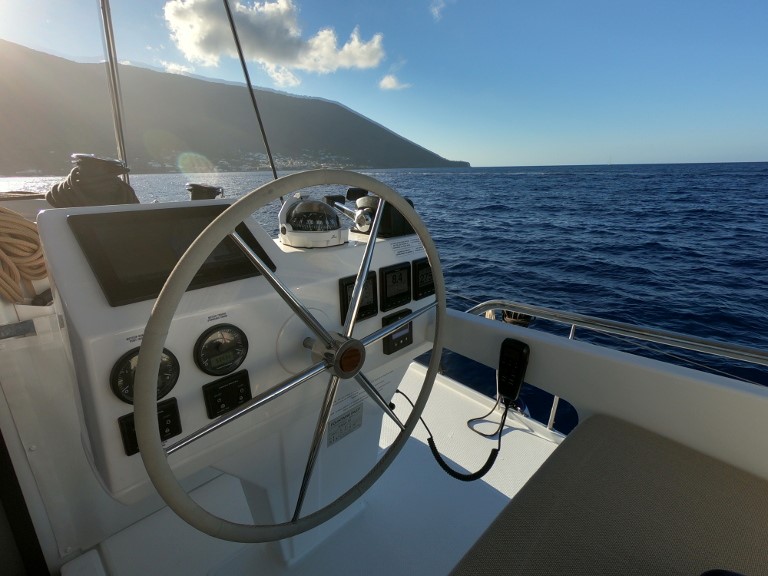
Catamarans also have a shallow draft, which will allow you to explore much closer to the shoreline than a monohull would be able to venture.
In the catamaran vs monohull speed debate, it might be more of a draw. Catamarans are typically 25-30% faster than a comparable monohull, but some argue that it comes at a price. When catamarans are sailing full speed you might experience a lot of slapping from the waves. Monohulls are designed to cut through the water. Also note that catamarans can be inefficient upwind and tack slowly.
When considering sailing conditions , a catamaran vs monohull in rough seas will perform very differently.
During rough sailing, you must be more vigilant when on a catamaran. The feedback from the wheel of a cat is not as obvious as that from a monohull. In high winds, you’ll need to know when to reduce sail.
However, monohulls tend to roll more in stormy weather, while catamarans stay pretty level even in rough seas.
When thinking about catamaran vs monohull stability, the stability that catamarans offer is a huge draw for many. Since cats bounce with the waves less, it is easier to walk around and enjoy the yacht while in motion. The increased stability is also great for children, or seniors, or anyone who might be prone to seasickness. When it comes to catamaran vs monohull seasickness, catamarans come out on top.
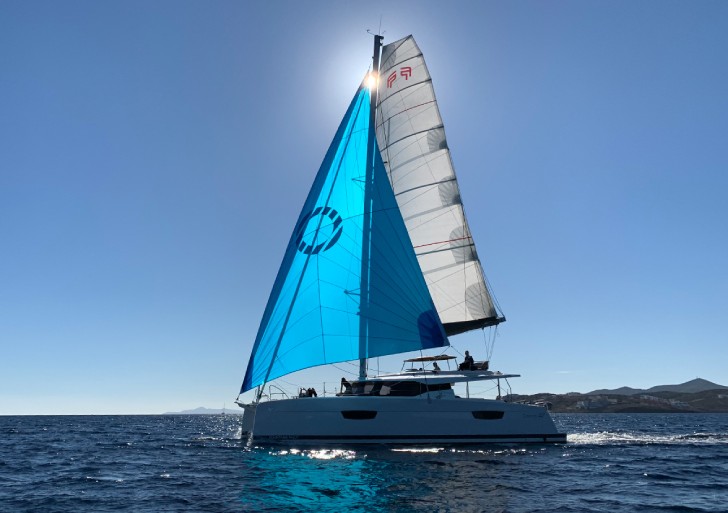
Although it is worth noting that monohulls swing less than catamarans if placed side by side in an anchorage.
If you’re deciding on a catamaran vs. monohull, you’ll have to think about what type of group you have. For family sailing holidays , maybe a catamaran is the best choice. Catamarans are very spacious, offering a large living space, and many cabin/head options. This makes them optimal for parties that want to spread out. Whether you’re a family, a big group of friends, or even couples looking for a 5 star, luxury experience who appreciate the extra space and comfort even if it’s not needed, a catamaran can fit your needs.
If thinking about catamaran vs monohull liveaboard readiness, the catamaran is a top contender. With far more living space and a much more spacious kitchen, Catamarans are great for people and groups that want to focus on entertainment and lounging.
Catamarans also typically have more spacious cabins and more privacy due to the layout with the cabins separate from the living area. This way you can send the kids to bed, and still enjoy the kitchen, dining, and living area.
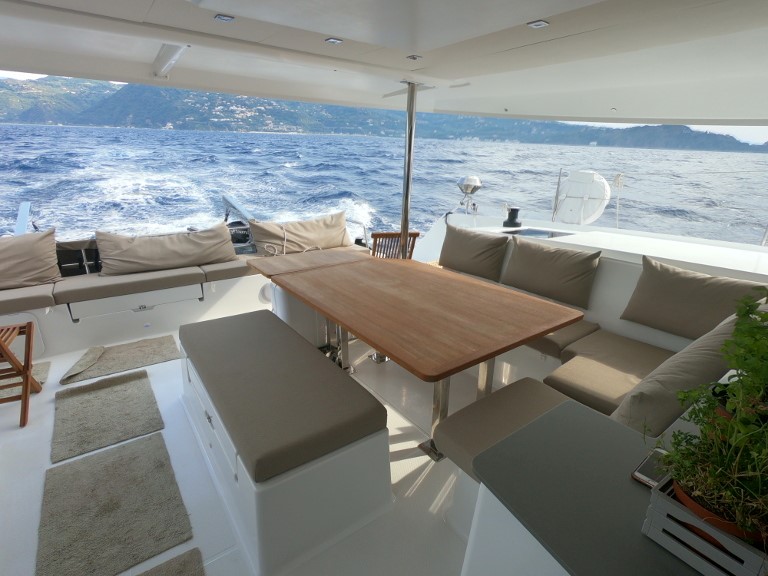
While catamarans are often touted for being roomy and luxurious, it’s worth nothing that monohull yachts can also be large and luxe. The Oceanis 62 and the Jeanneau 64 are top choices for those who want to live in the lap of luxury during their sailing holidays , while still getting that real sailing yacht experience.
In terms of catamarans vs monohull price , a monohull will definitely win. Charter prices for a catamaran can be 50-100% higher than that of a comparable sailing yacht. But that can be boiled down to the fact that you’re getting more space and more equipment with a catamaran!
A monohull, will only have one of everything - like it’s name suggests. It has one hull, one engine, one rudder, whereas a catamaran has twice the equipment and twice the living space of a monohull of the same length.
Another catamaran vs monohull cost to consider is the mooring costs. A catamaran, due to its twin hulls, might use two spots. Monohulls take less space to moor, and will be less expensive in that regard.
The cost of fuel should also be a consideration and in the question of catamaran vs monohull fuel efficiency, catamarans are the winner. With easy to drive hulls, and super light weight, they have great fuel efficiency.
Lastly, there is an abundant supply of monohull charters yachts, so the charter costs tend to be less to match the demand.
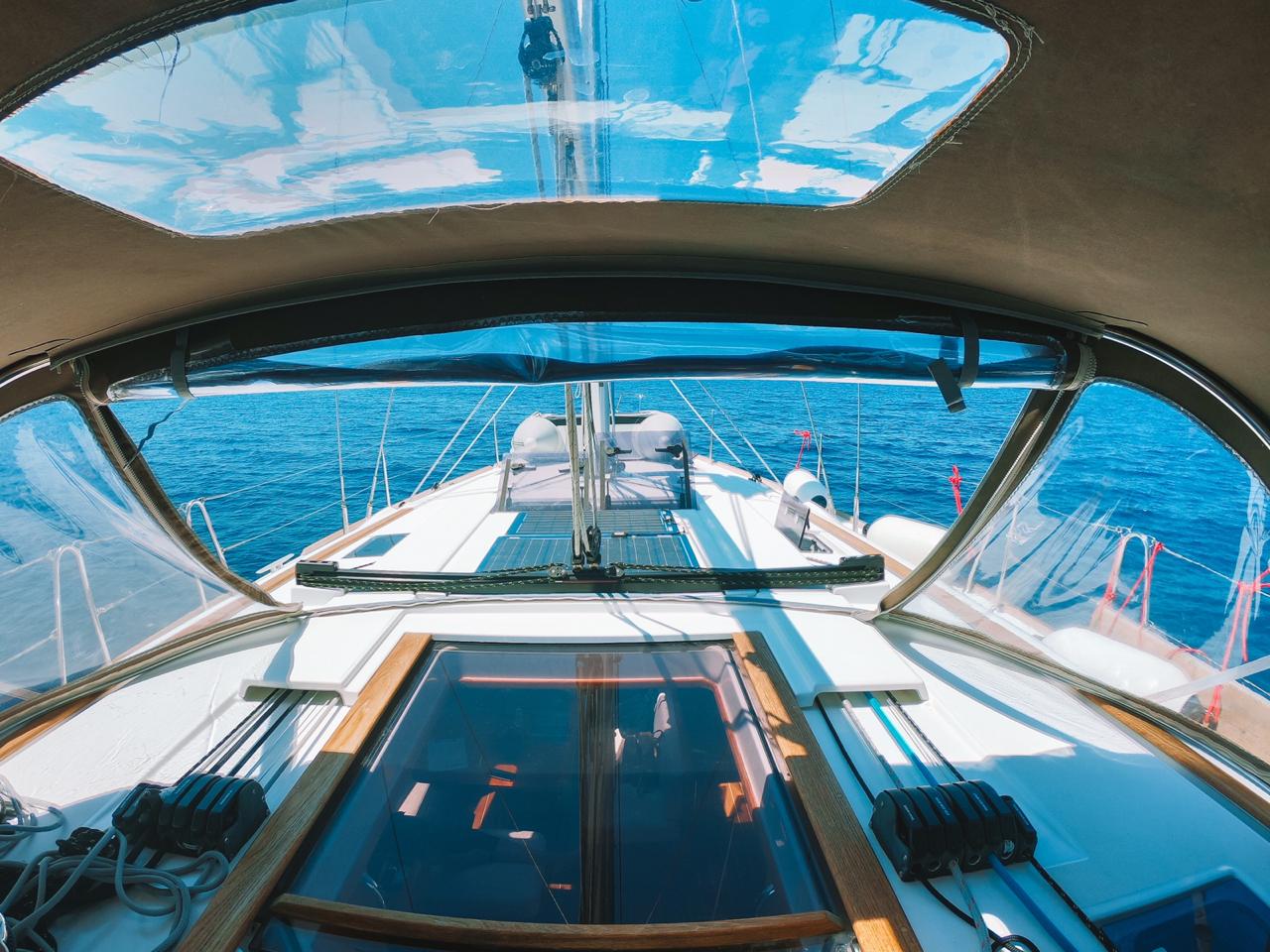
In the end, what it all comes down to is preference. In terms of performance, price, and comfort, catamarans and monohulls both have a lot going for them. You just need to decide what kind of holiday vibe you’re looking for, and Yacht4Less can help you with the rest!
At Yacht4Less we recommend fully crewed catamaran charters if you’re looking for top-of-the-line luxury and a super relaxing holiday where you don’t have to lift a finger. These boats will offer the space and comfort you’d expect from a 5-star hotel.
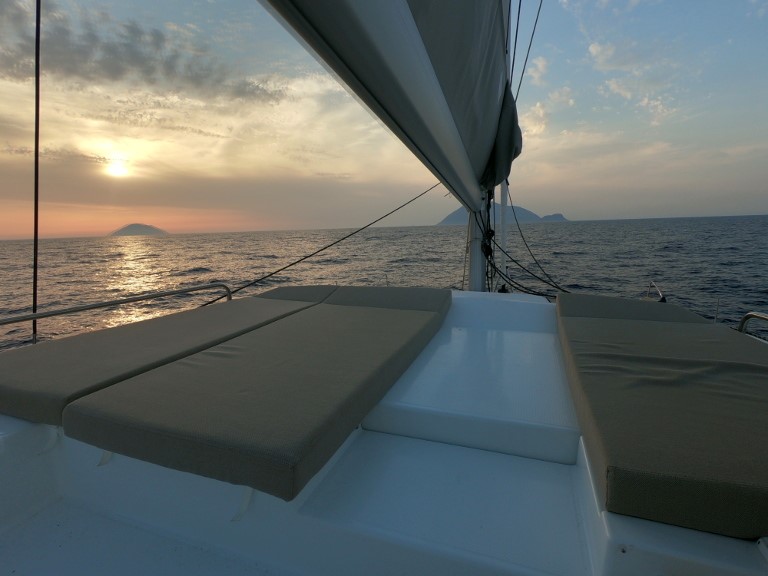
If you’re looking for a hands-on sailing adventure holiday, you might want to do a skippered charter with a monohull.. Your captain can show the ropes and help you learn how to sail. Or if you’re already an experienced sailor, go for a bareboat monohull charter . The exhilarating feeling of sailing a monohull is unmatched. It’s the classic romantic sailing experience, and makes for a thrilling holiday.
For those looking for a sailing experience somewhere in between extravagant luxury and exciting escapades, Yacht4Less is here to help you find the perfect boat for your needs. More sailing holiday dilemmas? We got you covered! Sailing Holidays vs. Land-Based Holidays » Party Sailing vs. Natural Wonders »
Get a free & non-binding quote

Monohulls vs. Catamarans: Which One is Best for You?
If you’re considering purchasing a sailboat, you might be wondering which type of vessel is best suited for your seafaring adventures. Fear not, for we’re here to help you weigh the differences between monohulls vs. catamarans to make an informed decision.
Now, before we dive into the nitty-gritty details of hull design, sail handling, and the like, let’s take a moment to appreciate the quirky personalities of these two boats. Sloop rigged monohulls are the classic, old-school sailboats with a single mast and a triangular sail. They’re like the wise old grandpa who’s been sailing the seas for decades and has plenty of stories to tell. On the other hand, catamarans are the younger, hipper cousins of the boating world. With their twin hulls and sleek designs, they’re like the trendy millennials who are always up for an adventure.
But enough with the stereotypes, let’s get down to business. In this article, we’ll explore the pros and cons of monohulls and catamarans across various factors such as stability, maneuverability, accommodations, and cost. By the end of it, you’ll have a better idea of which boat is best suited for your sailing style and preferences. So, hoist the anchor and let’s set sail!
What are classic monohulls?
Let’s start with the basics – what exactly are classic monohulls? Well, sloops. To put it simply, a sloop is a type of sailboat with a single mast and a fore-and-aft rigged mainsail. But there’s more to these boats than meets the eye.
Sloops are the OGs of the sailing world, tracing their roots back to the 17th century. They were the go-to boats for explorers, pirates, and adventurers alike, with their simple yet effective design making them perfect for long journeys at sea. Nowadays, they’re still a popular choice for sailing enthusiasts who appreciate the classic, traditional look and feel of a sloop.
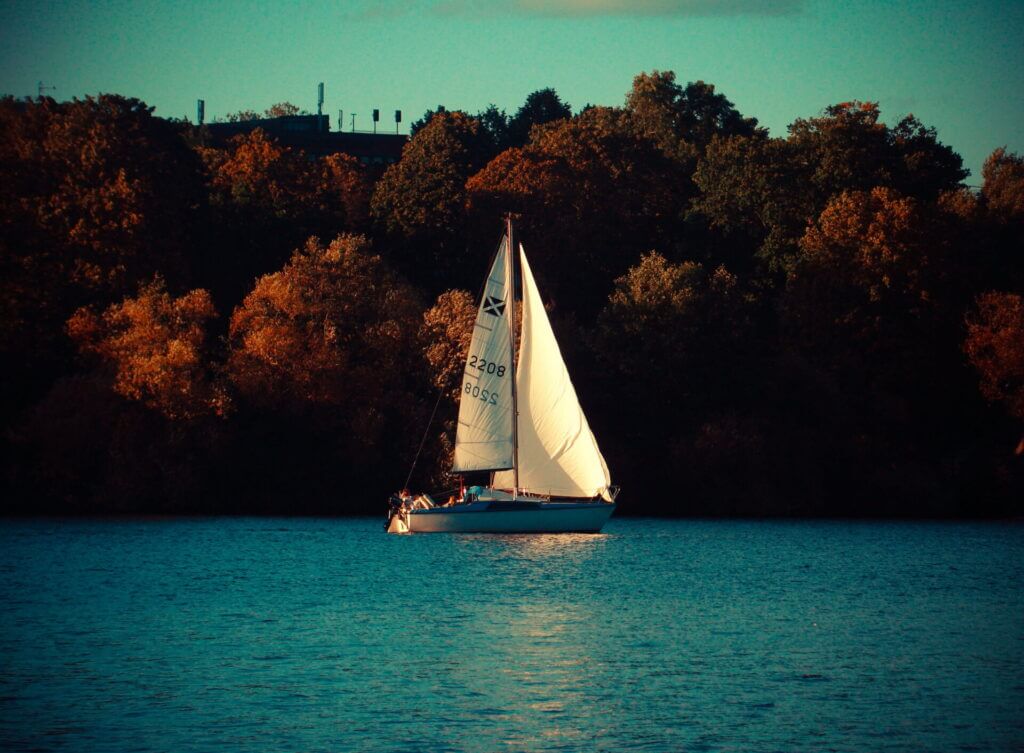
One of the defining characteristics of a sloop is its versatility. They come in a range of sizes, from small day sailers to larger offshore cruisers, and can be easily handled by a single sailor. Their rigging is relatively simple, making them a great option for beginners or those who prefer a less complicated sailing experience. But don’t let their simplicity fool you – sloops can pack a punch when it comes to speed and performance upwind.
Of course, there are some downsides to monohulls as well. Due to their single-hull design, they can be less stable in high winds or rough seas. They also tend to have less living space below deck compared to their bigger brothers. But if you’re looking for a classic, reliable, and versatile sailboat, a monohull might just be the vessel for you.
What are catamarans?
Now let’s talk about the other contender in this seafaring showdown – catamarans. These boats are a bit like the cool kids in high school – they’re sleek, modern, and always turning heads.
So, what exactly are catamarans? Well, to put it simply, they’re boats with twin hulls that are connected by a platform. But don’t let their basic design fool you – these boats are anything but ordinary. Catamarans come in a range of sizes, from small day boats to luxurious yachts, and offer a unique sailing experience that’s hard to beat.
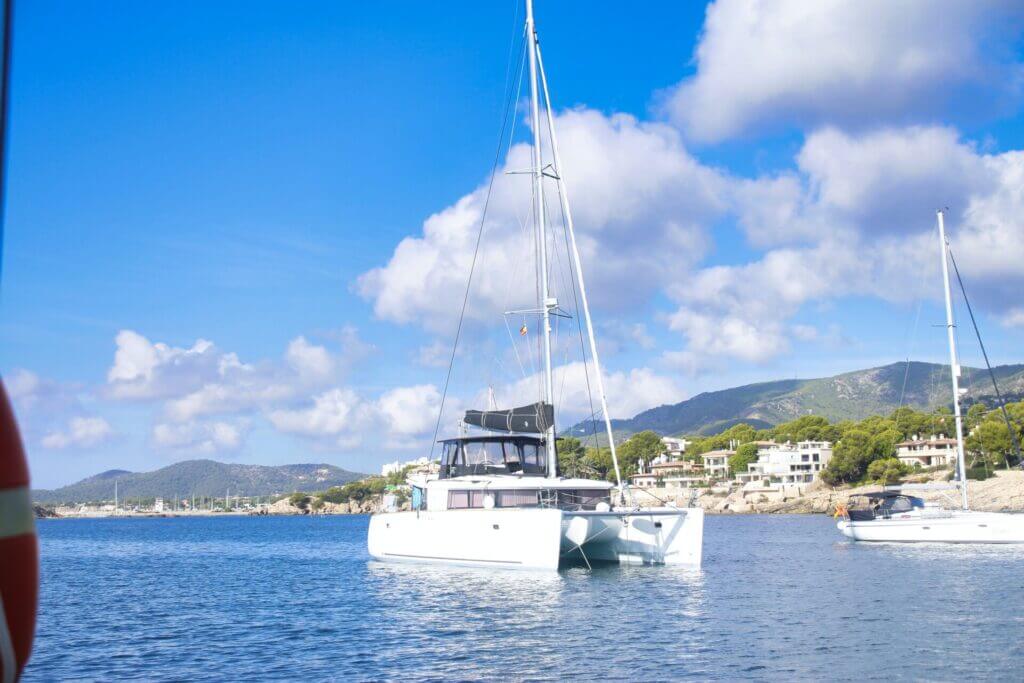
One of the biggest advantages of catamarans is their stability. With two hulls instead of one, they’re less likely to tip over or roll in rough waters. This makes them a popular choice for families or those who prefer a smoother sailing experience. They also have more living space above and below deck compared to monohulls, with spacious cabins, lounges, and kitchens that are perfect for extended trips.
But let’s not forget about performance – catamarans are no slouches when it comes to speed and agility. Their twin hulls create less drag in the water, allowing them to glide through the waves with ease. And with their sleek, aerodynamic designs, they can often outpace traditional monohull boats.
Of course, catamarans do have their downsides as well. They can be more complicated to handle compared to monohulls, and require more space to in marinas or docks. They also tend to be more expensive than other types of sailboats, but hey, you can’t put a price on luxury.
Hull design
Per definition, the hull design is the biggest differences between monohulls and catamarans.
Let’s start with monohulls. These boats typically have a single hull that’s shaped like a long, narrow tube. This design allows them to slice through the water with ease, making them great for speed and agility. The hull is usually rounded or V-shaped at the bow, which helps to cut through waves and reduce drag. At the stern, the hull flares out to create a wider, more stable base.
Now, onto catamarans. These boats have two hulls that are connected by a platform, giving them a unique look and feel. The hulls are usually wider and flatter than those of monohulls, which provides a greater amount of stability. This can be especially beneficial for those who are prone to seasickness or prefer a smoother sailing experience. The flat shape of the hulls also creates less drag in the water, allowing for higher speeds and better maneuverability.
When it comes to sailboats, stability is crucial for a comfortable and safe journey on the high seas. So, which type of boat – monohulls or catamarans – reigns supreme in this category?
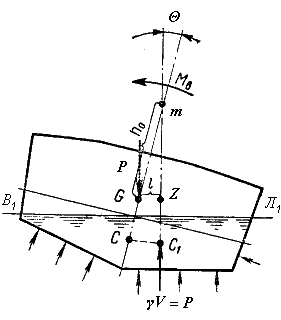
Well, let’s start with monohulls. These boats have a single hull, which means that their stability comes from the shape and weight distribution of the hull. Generally speaking, monohulls tend to be less stable than catamarans, especially in rough waters. This is because the single hull has to work harder to maintain balance, and can be more prone to tipping or rolling.
With two hulls connected by a platform, catamarans are the kings and queens of stability. The twin hulls provide a wider base and more buoyancy, making them less likely to tip over or roll in rough conditions. This can be especially beneficial for those who are new to sailing or prone to seasickness.
Maneuverability
Let’s talk about maneuverability – the art of smoothly navigating your vessel through the choppy waters. When it comes to monohulls vs. catamarans, the level of maneuverability can vary depending on the design and size of the boat.
Starting with monohulls, these boats are typically designed for speed and agility, which can translate to better maneuverability in certain situations. Their narrow hulls and single keels allow them to slice through the water and make quick turns, which can be useful in tight spots or when navigating through busy marinas.
Now, onto catamarans. With two hulls and a wider beam, these boats can be more challenging to maneuver in tight spaces. However, they do have some tricks up their sleeves. For example, many catamarans have engines that can rotate 360 degrees, allowing for greater control and maneuverability in tight spots.
Of course, when it comes to maneuverability, the skill and experience of the captain also plays a big role. A skilled sailor can make even the most unwieldy vessel dance through the water with ease, while a novice may struggle with even the most nimble of boats.
So, whether you’re piloting a monohull or a catamaran, it’s important to keep your wits about you and stay alert to your surroundings. And if all else fails, just remember the time-honored sailor’s adage – “When in doubt, let it out!”
Accommodations
Starting with monohulls, these boats typically have a more compact interior layout, with limited headroom and sleeping quarters. However, this can be a trade-off for a sleeker and more agile vessel that can slice through the waves with ease. Plus, with some creative packing and organization, a monohull can provide all the basic amenities you need for a comfortable voyage.
With their wider beam and spacious design, catamarans offer more room for living and sleeping quarters, as well as additional amenities like a galley kitchen and a bathroom. This can make for a more luxurious and comfortable sailing experience, especially for longer voyages. In addition, the two-hull design offers more space on deck for dinner parties or sunbathing in the trampolines

Of course, when it comes to accommodations, everyone’s preferences are different. Some sailors may prefer the cozy intimacy of a monohull, while others crave the roominess and luxury of a catamaran. It all depends on your personal style and needs as a sailor.
Performance
Let’s delve into the topic of performance, which is a critical factor when selecting a sailing vessel. Each sailor may have a different perspective on what constitutes optimal performance, but generally speaking, it comes down to speed and efficiency.
When it comes to speed, catamarans have an advantage in downwind performance. Their wider beam and twin hulls give them more sail area and a greater ability to surf down waves, resulting in faster speeds. However, monohulls are often faster when sailing upwind, as their pointed hull allows them to sail closer to the wind.
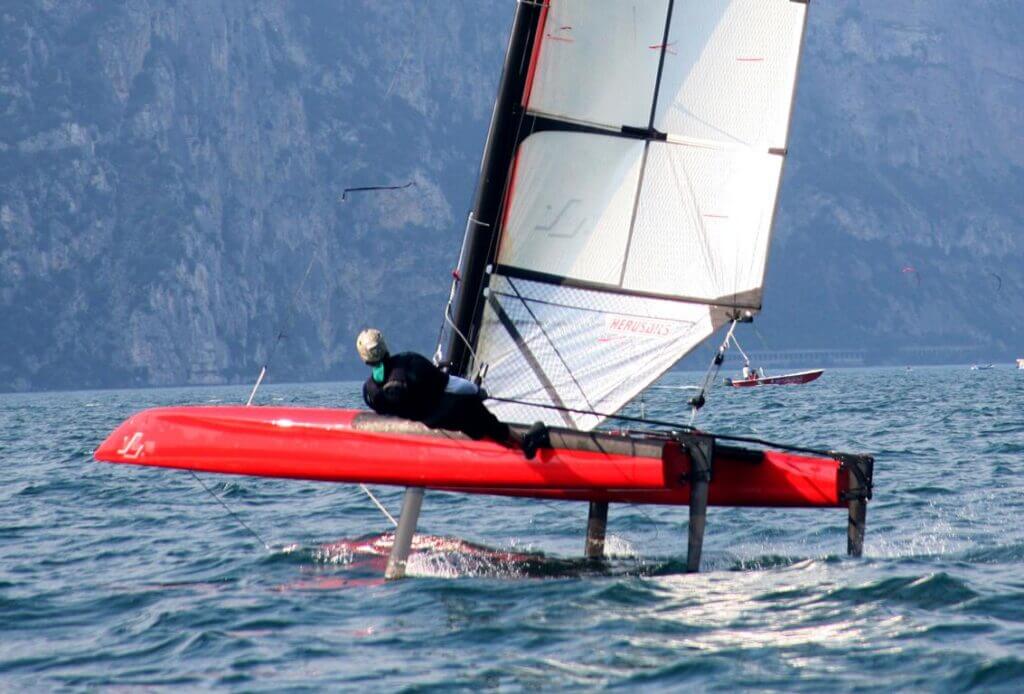
The upwind angle is an important consideration for sailors, as it affects how close to the wind they can sail. sloop rigged monohulls are known for their ability to sail at a higher angle upwind, which can be a major advantage when sailing in areas with narrow passages or limited space to maneuver. Catamarans, on the other hand, may need to tack more frequently in order to reach their destination when sailing upwind.
Maintenance
When it comes to sailing, we all know that proper maintenance is key to keeping your vessel in tip-top shape. So, when it comes to choosing between a monohull vs. a catamaran, it’s important to consider the maintenance requirements for each type of vessel.
Monohulls generally have simpler systems and structures, which can make maintenance a bit easier and more straightforward. However, the tradeoff is that they may require more frequent maintenance and repairs due to their smaller size and simpler design.
Catamarans, on the other hand, can be more complex and may require more maintenance in terms of their twin hulls, rigging, and systems. However many important systems like engines, bathrooms, or water tanks are in both hulls which give you redundancy and options. Also, their larger size can make accessing and maintaining these components a bit easier.
Regardless of which type of vessel you choose, regular maintenance is a must. From checking and maintaining the sails and rigging to ensuring the engines and electrical systems are in good working order, taking care of your vessel will ensure that you’re able to sail safely and confidently.
When it comes to the cost of a sailing vessel, there are many factors to consider. Let’s take a closer look at how monohulls vs. catamarans stack up.
First off, monohulls are generally considered to be more affordable than catamarans, both in terms of the initial purchase price and ongoing maintenance costs. This is due in part to their simpler design and smaller size, which requires less materials and labor to build and maintain.
On the other hand, catamarans can be quite costly to purchase and maintain, especially if you opt for a larger or more luxurious model. The wider beam and heavier construction of a catamaran can also mean higher slip fees and storage costs at marinas. But don’t let that deter you! If you have the means and the desire for a more spacious and comfortable sailing experience, a catamaran might be worth the investment.
Of course, the cost of a sailing vessel is just one piece of the puzzle. You’ll also need to consider other expenses like fuel, insurance, and ongoing maintenance and repairs. And let’s not forget the most important cost of all: the cost of living your best life on the open sea!

So weigh your options carefully, and remember that the true value of a sailing vessel goes far beyond the price tag. May the winds of fortune guide you to the vessel of your dreams, and may you sail with joy and a full wallet!
Resale value
Resale value is an important consideration when it comes to buying any type of vessel, and monohulls and catamarans are no exception. Generally speaking, catamarans tend to hold their value better than monohulls due to their popularity among sailors and their reputation for being spacious and comfortable. However, resale value can also depend on the specific make and model of the boat, as well as its age, condition, and location.
Of course, there are always exceptions to the rule. Some monohulls may have a cult following and fetch a higher price on the resale market, while some older catamarans may not hold their value as well as their newer counterparts. Additionally, factors such as maintenance, upgrades, and customization can also affect resale value.
In conclusion, when it comes to monohulls vs catamarans, there is no one-size-fits-all answer. Each boat has its own advantages and disadvantages, and the decision ultimately depends on your personal preferences, needs, and sailing goals. If you have the money, looking for a faster ride downwind and don’t mind sacrificing a bit of upwind performance, a catamaran might be the way to go.
Resale Value
On the other hand, if you want something cheaper, prioritize sailing close to the wind and want a boat that is more easily handled in a variety of conditions, a sloop rigged monohull might be the better choice. Of course, other factors such as accommodations, and maintenance also play a crucial role in the decision-making process.
So whether you prefer the sleekness of a monohull or the stability of a catamaran, make sure to consider all the options and weigh the pros and cons carefully before making your final choice. And as with any big decision, it never hurts to consult with experienced sailors, boat dealers, or brokers to get their expert opinions. Happy sailing!
Similar Posts

How do Boats Float? Exploring the Science Behind Buoyancy
Sailboats float because the average density of the boat is less than the density of water. When boats displace as much water as it weights, this is known as the buoyancy force generated by Archimedes’ principle. If you’ve ever wondered how do boats float and therefor enable us to embark on thrilling water adventures, you’ve…
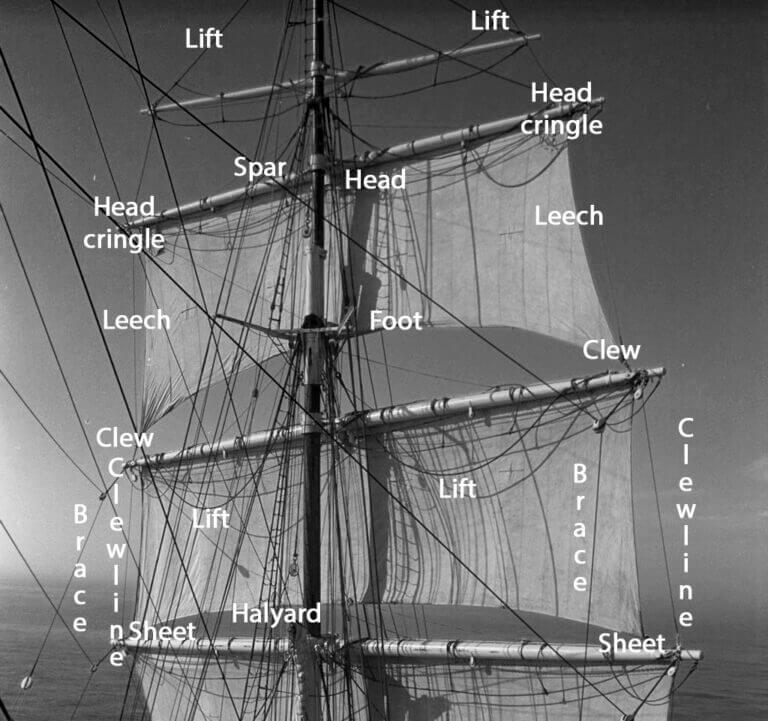
Whats the Difference between Standing Rigging and Running Rigging?
Running rigging refers to the movable lines and ropes used to control the position and shape of the sails on a sailboat. Standing rigging, on the other hand, refers to the fixed wires and cables that support the mast and keep it upright. As the sun rises on another day, we find ourselves immersed in…
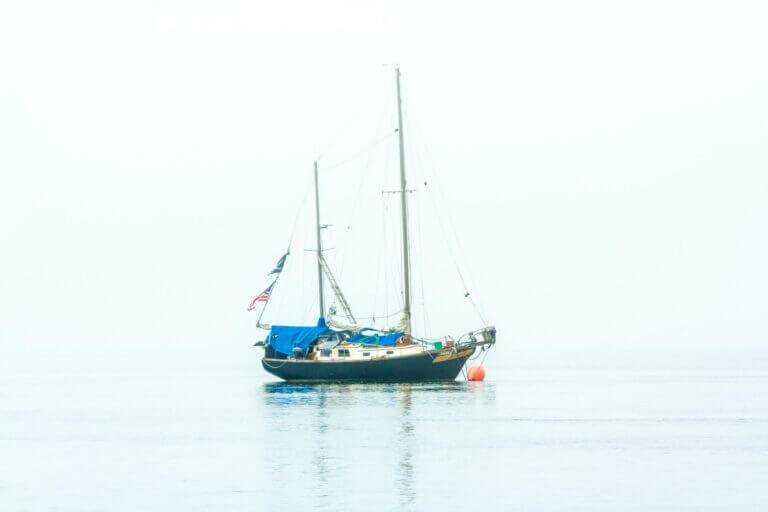
What is a Ketch Sailboat?
Ketch boats are frequently seen in certain regions and offer various advantages in terms of handling. However, what is a ketch and how does it stand out? A ketch is a sailboat with two masts. The mainmast is shorter than the mast on a sloop, and the mizzenmast aft is shorter than the mainmast. Ketches…

Basic Sailing Terminology: Sailboat Parts Explained
Sailing is a timeless activity that has captivated the hearts of adventurous souls for centuries. But, let’s face it, for beginners, sailing can be as intimidating as trying to navigate through a dark, labyrinthine maze with a blindfold on. The vast array of sailing terminology, sailboat parts and jargon can seem like a foreign language…

Mainsail Furling Systems – Which one is right for you?
With the variety of options of mainsail furling systems available, including slab, in-boom, and in-mast systems, it can be challenging to determine which one best suits your needs. In this comprehensive guide, we will explore the pros and cons of each system, enabling you to make an informed decision that aligns with your sailing requirements….

How Does a Marine Toilet Work?
Have you ever wondered how a marine toilet works? If you’re planning to embark on a boating adventure or just curious about the mechanism of a marine toilet, this article is for you. Marine toilets work similarly to the ones on land with a bowl, a seat, and a flushing mechanism that uses water. However,…
- Articles and Guides
Catamaran vs Monohull: The Great Sailboat Debate
16th jun 2023 by john burnham.

Do you love the natural sounds of water sliding past the boat’s hull and a breeze blowing across your rigging and sails while gliding ahead powered only by the force of the wind? If yes, you are well-suited to spending plenty of time on a sailboat, like so many generations of boat people before you.
But do you take your lead from the Egyptians who rigged sails on their boats built of reeds along the Nile River or follow the path of the Polynesians, who used an outrigger for extra stability and sailed from one Pacific island to the next in the earliest catamarans?
The question of which is better for sailing, one hull or two, has been a matter of debate over thousands of years. Today, let’s explore these two basic types of sailboat, and while we may not settle the argument once and for all, hopefully in the process you will begin to discover which option is better for you.
What Are the Differences Between Catamaran and Monohull Boats?
The monohull and the catamaran (often referred to as “cat”) are the two most common categories of sailboats, and of the two, the monohull far outnumbers the catamaran in popularity due to its simplicity and sturdiness. Advocates of the catamaran, however, are typically even more convinced than monohull sailors that their boats are best due to performance potential and overall spaciousness.
What are catamaran-style boats?
Catamarans are easily identified by their two-hull design. Two hulls sit side by side with an interconnecting deck or structural beams across the bap in the middle. Catamarans have been around since Pacific Islanders and other Austronesian people sailed them centuries ago, and they continue to gain popularity in a wide range of designs both as high-performance racing boats and ocean-cruising designs.
Although not part of this debate, a third sailboat type comparable to a catamaran is a trimaran. Trimaran sailboats are constructed similarly to catamarans but have three parallel hulls rather than two. Collectively, catamarans and trimarans are referred to as multihulls, and sailors of both types often refer lightheartedly to monohulls as “monomarans.”
What are monohull-style boats?
Monohull sailboats are the most common boat type because they feature a single hull, typically with a single mast and two sails. Rather than maintaining stability with a second hull creating a wider beam, monohull boats usually carry lead or other heavy ballast in their keel, or are stabilized by human weight as their crews lean out to counter the force of the wind. Monohulls can also be excellent racers and cruisers, depending on their size, volume, sail area, and displacement or weight.
Where Catamarans and Monohulls Excel
Each type of boat has its advantages, depending on what the owner wants in a boat. Here are the main advantages of each type.
Catamaran advantages
• More space . Catamarans have greater beam for a given length, which provides more space for the crew on a daysailer and larger living quarters on cruising designs, which are often laid out with berths in each hull and living quarters across the bridgedeck between hulls.
• Faster hull . If they are light enough, the sleeker shape and reduced wetted surface of two narrow, shallow hulls can produce quicker straight-line sailing speed than a single, deeper and wider hull.
• Comfort and stability . Two hulls provide better initial stability and generally heel less than monohulls, especially in light- or medium-strength winds and waves.
Monohull advantages
• Upwind sailing . When sailing against the wind, monohulls often sail at a closer angle to the wind and arrive more quickly at their destination.
• Easier motion . Heavier monohulls often have a slower, gentler motion in waves than a lighter catamaran.
• Load carrying capability . A monohull’s performance is reduced less than a catamaran’s when the boat is loaded heavily with cargo or crew.
• Righting characteristics . Larger monohulls have weighted keels that provide increased resistance to a capsize when the boat is heeled far over by wind or a wave and if capsized will return the boat to an upright position.

Catamaran vs. Monohull Sailing Speed
There are several reasons why a catamaran is often faster than a monohull boat. These include the fact that most catamaran hulls have less water resistance than monohulls, they are often lighter, and they can be more easily driven by a relatively small sailplan. At similar lengths, a catamaran can be dramatically faster than a monohull under similar sea conditions. However, weight is the enemy of a catamaran’s speed; a heavy or heavily loaded catamaran may be much slower than a lightweight monohull.
Catamaran vs. monohull power
A monohull under auxiliary power may be faster than a catamaran in certain conditions, like powering against a strong wind. In other wind and wave conditions, the catamaran is often faster. Also, with an engines on each hull, the cat is often much more maneuverable in close quarters or at the marina. While it may seem counter-intuitive, turning and controlling the boat is often less challenging than when sailing a monohull boat with the typical single engine. Monohull boats require more finesse when in tight quarters like berthing in a marina.
Catamaran vs. Monohull Efficiency
A sleek monohull may sail against the wind super efficiently, pointing close to the wind and making an excellent speed. However, the power-to-weight ratio of the catamaran allows it to make good use of whatever wind it has. Some fast, light catamarans can travel at speeds equal to or faster than the wind, something very few monohulls can achieve. When the wave action increases and you start sailing into the wind, the catamaran may lose its advantage, and in strong winds, the greater windage of the wide catamaran may have a pronounced slow-down effect compared to the sleeker monohull.
Catamaran vs. Monohull Stability
Despite not having a weighted keel, a catamaran design is able to avoid heeling over in strong winds or bad weather due to its greater width or beam. As a result, the multihull also tends to be more stable at anchor and any time in calmer seas. However, if the winds are strong and the waves are large, a monohull, with its keel weight and ability to sail against the wind while controlling the sails, is sometimes the steadier of the two types. While a monohull with weighted keel can be knocked down by strong gusts of wind, it will only capsize in extremely large waves. Likewise, a cruising catamaran can only capsize in large ocean waves, unless it is a fast, lightweight catamaran, that can more easily tip over in gusty winds and waves.
Catamaran vs. Monohull Safety
Power catamarans and power monohulls are relatively comparable in terms of safety. But depending on the size of the mast and sails, the weight of the boat, and the wind and wave conditions experienced, many sailors believe that a monohull configuration is safer than a catamaran for a sailboat. That’s mainly because while a monohull will initially heel over further in a strong gust of wind, the weight of its keel provides increasing stability as described above and if completely capsized, the keel typically helps the boat self rescue.
It should be clarified that many sailing catamaran designs are conservatively configured and difficult to capsize except in extreme ocean wave conditions—and the same can be said for larger power catamarans.
In terms of ultimate safety in the event of a capsize, however, the catamaran is considered safer because even should it turn once upside down, even if damaged, the catamaran with its two hulls and minimal ballast typically remains buoyant and provides a safer configuration in which to await rescue. By contrast, if a monohull’s hatches and port windows suffer damage in a knockdown, the boat can more quickly take on water and, weighed down by its keel or other ballast, be more difficult to keep afloat in extreme conditions.
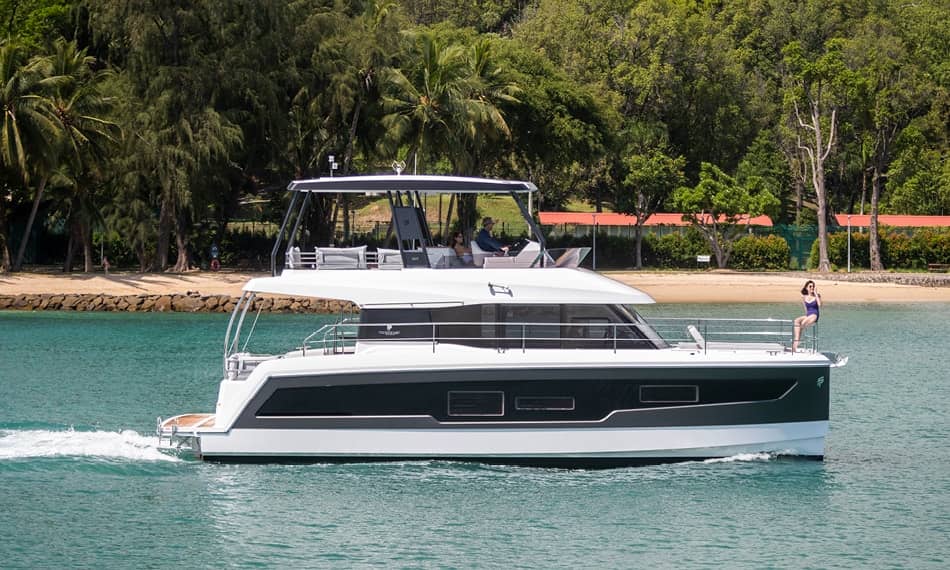
Photo credit: Fountaine Pajot
Monohull vs. Catamaran Maintenance
Depending on size, age, and type of hull construction, maintenance costs will vary, but when comparing two fiberglass sailboats of similar length, the catamaran typically costs more to maintain. That’s because there are two hulls to care for, two engines, connecting structures that align the two hulls, and an overall larger boat due to the catamaran’s greater beam. Hauling and launching a catamaran can be more expensive at many boatyards, as well.
However, smaller catamarans of about 20 feet in length or less are often more comparable and sometimes cheaper to maintain than a similar length monohull. That’s because cats are often lighter and suitable for keeping on a trailer rather than in a slip or on a mooring.
Catamaran vs. Monohull Cost
Compared to similar length monohulls, a catamaran will likely cost more than a monohull boat. That’s mainly because when you purchase a 40-foot catamaran, you are buying two hulls and two engines, but you are also buying a bigger boat that typically has much more volume. In the case of a 40-footer, you end up with a boat that has a large saloon and three or four private cabins, whereas in the monohull, the saloon is smaller and you’ll have three smaller sleeping cabins. Annual maintenance will also be greater, as described above.
Among smaller catamarans and monohulls, pricing will vary, and a lightweight beach cat may be less expensive than a heavier monohull keelboat of similar length.
Catamaran vs. Monohull, Pros and Cons
Depending on a variety of factors, there are plenty of catamaran and monohull pros and cons. These are some to keep in mind when comparing the two boat types.
Catamaran pros
• Comfort . On a cruising designed catamaran, two hulls with a wide beam create a stable and comfortable living environment with open spaces and plenty of standing room.
• Speed . Smaller, lighter catamarans are speed champions, especially in a moderate wind and modest waves. Cruising cats are often fast when sailing at reaching angles.
• Maneuverability . When equipped with two engines, a catamaran is highly maneuverable under power.
Monohull pros
• Upwind sailing . Although catamarans are often faster when sailing in a straight line, monohulls typically perform better against the wind.
• Self-righting . Except for unballasted monohulls that rely on crew weight for stability, the ballasted keel of a monohull prevents capsizing in most circumstances and the keel makes the boat self-righting.
• Maneuvering under sail . Monohulls turn more easily due to their shape, maneuvering in close quarters or tacking when sailing against the wind.
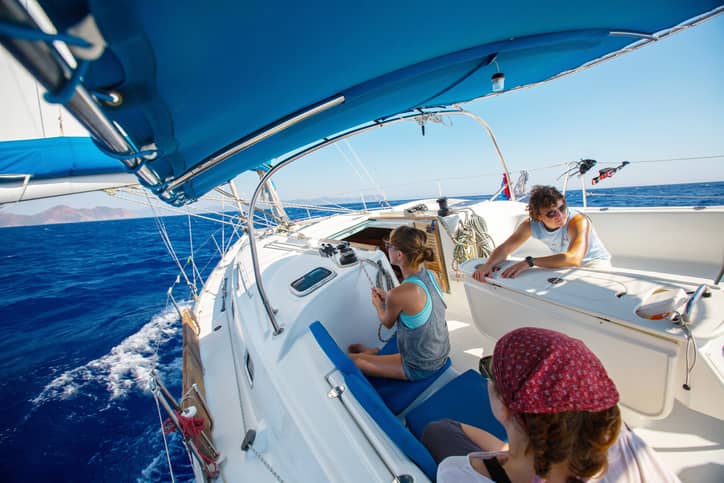
Catamaran cons
• Lack of feel when steering . Except in lighter, more performance-oriented catamarans, the broad platform with two rudders and two hulls sometimes isolates the sailor and provides little feedback through the helm when under sail.
• Sailing against the wind . Upwind sailing is generally not a catamaran’s best point of sail, but its straight-line speed can be such that it may arrive quickly at its destination, even though you will have traveled much farther than in a monohull.
• Pricing . Catamarans are typically more expensive than monohull boats due to their two hulls and other required build components and complexity.
• Not self-righting . Thanks to its wide beam and two-hull design, a catamaran is more difficult to flip, but it is not designed to right itself except for small beach cats where the crew can use their weight to re-right the boat.
Monohull cons
• Weight . Most monohulls have thousands of pounds of weight in the keel for ballast that is vital to its stability but can degrade performance.
• Wave motions . Monohull boats are much more susceptible to rolling wave motions.
• Cabin . With the monohull cruising design, you'll typically find a darker interior with smaller port windows and fewer space options.
• Heeling effect . Monohulls will heel over in a moderate wind, which is normal but often uncomfortable for newer sailors.
Written By: John Burnham
John Burnham is a marine editor and writer with decades of journalism experience as Chief Editor of boats.com, Sailing World, Cruising World, and other boating websites. As a competitive sailor, he has led teams to world and national titles in the International One-Design, Shields, and other classes. Based in Newport, Rhode Island, John is a PCC leadership coach, a member of the America’s Cup Hall of Fame Selection Committee, and a past board member of Sail America and US Sailing. For more, see johnsburnham.com .

More from: John Burnham
Related Articles and Guides
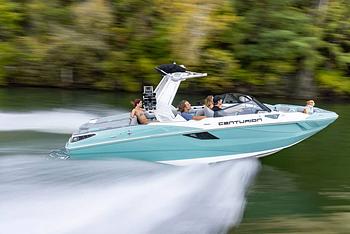
20th Mar 2024
Best Wakesurf Boat Brands
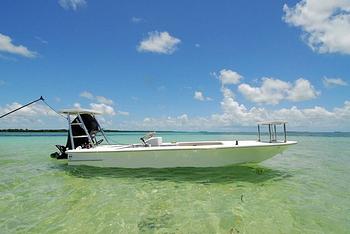
4th Mar 2024
The Best Flats Boats Brands, Special Boats for Skinny Waters
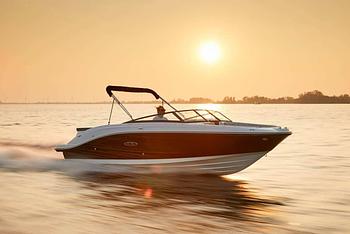
21st Feb 2024
Best Lake Boat Brands for Fishing, Cruising, and Watersports

15th Feb 2024
Best Aluminum Fishing Boat Brands: Tougher, Lighter and More Affordable
- Explore Rightboat
- Boats for Sale
- Boating Articles
- Buyers Guide
- About RightBoat
- Sell Your Boat
- Boat Selling Advice
Enter your email to keep up to date with the latest news
Join for free
Sign up now for free and discover how easy it is to keep up to date with THE latest boats for sale. Find your right boat, and tailor your voyage to finding your next boat.
Benefits of becoming a member:
- Set up tailored alerts
- Personalise your experience
- Download full specifications and broker details
- Keep tabs on your favourite boats
Are you a broker? Join as a Broker
Rightboat - join for free.
Do you have an account already? Login
Save this search
Save your search and receive new boats in your email..
You can unsubscribe from your alerts whenever you like. By pressing the button you accept the Legal Terms and conditions

Catamaran Vs. Monohull: Which Is Better?
When considering sailboats for cruising or liveaboard purposes, two primary options often come to mind: catamarans vs. monohulls. We know, because we’ve been there!
Having sailed full-time for four years on a monohull before swapping to a catamaran with the impending arrival of baby, we really understand the whole catamaran vs. monohull debate, and it isn’t clear cut.
Both types of vessels have their own unique characteristics, advantages, and considerations. Understanding the differences between catamarans and monohulls can help individuals make an informed decision based on their specific needs and preferences.
Catamarans are known for their spaciousness, stability, and comfort. With their twin-hull design and wide beam, catamarans offer generous living spaces, expansive decks, and increased privacy with separate hulls.
The stability provided by the twin hulls creates a smoother ride, reduced rolling motion, and enhanced comfort in a variety of sea conditions. Catamarans also tend to have better maneuverability, fuel efficiency, and shallow draft capabilities.
On the other hand, monohulls are characterized by their sailing performance and versatility. Their single-hull design, deep keel, and ballast provide excellent upwind performance and responsiveness.
Monohulls offer a traditional sailing experience with the sensation of heeling and a closer connection to the water.
They are often more cost-effective in terms of initial purchase price and maintenance expenses. Monohulls also provide more options for docking in marinas with narrower slips.
Choosing between a catamaran and a monohull ultimately depends on individual preferences, intended use, and priorities.
Factors to consider include space requirements, stability preferences, sailing performance, budget, cruising plans, and personal comfort levels. Spending time on both types of boats and seeking advice from experienced sailors can help in making a well-informed decision.
In the following sections, we will delve deeper into various aspects of catamarans and monohulls, exploring their advantages and considerations, including stability, speed, cost, maintenance, maneuverability, and more.
By examining these factors, individuals can gain a comprehensive understanding of which type of sailboat may be more suitable for their specific needs and aspirations.

As an Amazon Associate, we earn from qualifying purchases. We also earn from other affiliate programs. This means we may receive a small commission on products purchased through our links at no extra cost to you.
Table of Contents
Which is better catamaran vs. monohull, the advantages of catamarans, the advantages of monohulls, the disadvantages of catamarans, the disadvantages of monohulls, are monohulls safer than catamarans, maintenance, ability to maneuver.
- Fuel Efficiency
Which Is Better In Rough Seas?
- Which makes a better liveaboard Sailboat?

There are lots of advantages to both catamarans and monohulls. Both can be excellent sailing or power vessels and suit various different needs. There is always a big debate among sailors about which is actually better and honestly, we don’t have the answers!
There are so many plus and minus points for each that it’s hard to come to a logical conclusion without knowing a certain sailor’s needs first.
What advantages does one have over the other? Let’s explore that now to help you decide which one is right for your individual needs.

Catamarans offer several advantages that make them popular choices for various marine applications.
One key advantage is their superior stability. The two parallel hulls provide a wide base, which distributes the weight evenly and reduces the likelihood of tipping or rolling. This stability is especially beneficial in rough seas, making catamarans a preferred choice for cruising, offshore sailing, and passenger transportation.
Another advantage of catamarans is their speed performance. The twin hulls reduce drag and increase buoyancy, allowing them to achieve higher speeds with less power.
Catamarans are often faster than monohull boats of similar size, making them popular for racing, chartering, and personal use. The speed advantage of catamarans can be particularly appealing for those who enjoy thrilling water sports or need to reach their destinations quickly.
Catamarans are also known for their fuel efficiency. The design of catamarans minimizes drag and weight, enabling them to achieve higher speeds with less power and fuel consumption compared to monohull boats.
This advantage becomes especially significant during long-distance cruising, where fuel costs can be substantial. The fuel efficiency of catamarans not only saves money but also contributes to a more sustainable and environmentally friendly boating experience.
In addition to stability, speed, and fuel efficiency, catamarans offer other advantages as well. Their wide beam provides ample deck space, offering more room for socializing, entertaining, and enjoying outdoor activities.
Catamarans often feature spacious cabins, making them comfortable for extended periods on the water, whether for leisurely cruising or living aboard. The dual hulls also provide increased buoyancy, allowing for shallower drafts and access to more secluded anchorages and cruising grounds.
Furthermore, catamarans generally have shallower keels compared to monohulls, which allows them to navigate in shallower waters and access remote areas that might be inaccessible to deeper-draft vessels . This versatility opens up a broader range of exploration possibilities for catamaran owners.
Overall, the advantages of catamarans, including stability, speed, fuel efficiency, spaciousness, and versatility, make them attractive options for a variety of boating enthusiasts.
Whether for leisurely cruising, racing, chartering, or living aboard, catamarans offer a unique combination of features that enhance the boating experience.

Monohull boats offer several advantages that make them popular among sailors.
One of the key advantages is their excellent seaworthiness, particularly in challenging conditions. The deep, V-shaped hulls of monohulls provide stability and a smoother ride through waves and choppy waters.
This design allows monohulls to cut through the water efficiently, making them well-suited for offshore sailing and bluewater cruising.
When out in huge waves during an unexpected storm I found it hard to imagine how a catamaran would cope compared to our heavy bluewater monohull that just plowed through the waves as though they were butter.
Another advantage of monohulls is their superior upwind performance. The single hull design allows them to tack more effectively and maintain a higher pointing ability, making them ideal for sailors who frequently navigate against the wind. This advantage is particularly important for racing sailors and those who enjoy exploring areas where upwind sailing is common.
Monohull boats are typically more maneuverable than catamarans. The single hull allows for sharper turns and greater agility, which can be advantageous in tight spaces, marinas, or when docking.
The ability to maneuver easily makes monohulls more versatile in navigating narrow channels, entering small harbors, or handling in confined areas.
Additionally, monohulls offer a wide availability and variety of models, sizes, and configurations. They have been the traditional and widely available choice in the boating industry for a long time. This abundance of options allows boaters to select a monohull that suits their specific preferences, needs, and budget.
Monohull boats also often have a lower initial cost compared to catamarans of similar size and quality. The construction and design of a monohull are typically simpler, resulting in a more affordable purchase price.
This cost advantage can be significant for individuals or families entering the boating world on a limited budget.
Finally, monohull boats are generally easier to dock and berth in standard marina slips. Their single hull design allows for straightforward docking procedures and fitting into narrower slips designed for monohulls.
This advantage simplifies the process for boaters who frequently visit marinas or require regular docking facilities.
It’s important to note that the choice between a monohull and a catamaran ultimately depends on individual preferences, intended use, and specific requirements. Both types of vessels have their unique advantages and considerations, and it’s crucial to carefully evaluate these factors when selecting a boat that best suits your needs.

Catamarans, despite their advantages, also have some disadvantages that should be taken into consideration.
One notable disadvantage is the cost. Catamarans are generally more expensive than comparable monohull boats. The construction, materials, and design complexity of catamarans contribute to their higher price tag.
Additionally, maintenance, docking fees, and insurance costs can be higher due to the larger size and wider beam of catamarans. We’re only just starting to find out just how much more they cost, and it isn’t insignificant!
Another disadvantage of catamarans is the limited availability of berthing options. The wider beam of catamarans can pose challenges when it comes to finding suitable berths in marinas. Many marina slips are designed to accommodate monohull boats and may not have sufficient space for catamarans.
This limitation may require catamaran owners to seek specialized marinas or rely more frequently on anchoring.
The wider beam of catamarans can make maneuvering more challenging, especially in tight spaces, narrow channels, or crowded marinas. The increased width may require additional care and skill when docking or navigating in confined areas. Catamarans may also require specialized docking arrangements or wider slips to accommodate their size.
In heavy weather conditions, catamarans may experience some performance limitations. While they generally provide excellent stability, their wider beam can make them more susceptible to windage and slamming.
The larger surface area exposed to the wind can result in more resistance and difficulties maintaining course in strong winds. Skillful handling and careful sail management are necessary to optimize performance in challenging weather conditions.
Additionally, some sailors enjoy the heeling sensation experienced on monohulls when sailing close to the wind. Catamarans, with their stable platform, lack this sensation since they do not heel to the same degree.
This absence of heeling can be seen as a disadvantage for sailors who enjoy the dynamic experience of monohull sailing.

Monohull boats also have their own unique set of disadvantages.
One of the main disadvantages is their stability compared to catamarans. Monohulls typically have a narrower beam and a single hull, which can make them less stable in certain conditions, particularly in rough seas.
This may result in more rolling and pitching motions, which can be uncomfortable for some passengers.
Another disadvantage of monohulls is their potential for heeling. When sailing close to the wind, monohulls have a tendency to heel or lean to one side. While this is a characteristic appreciated by many sailors, it can be a disadvantage for those who prefer a more stable and level sailing experience.
Monohulls also tend to have limitations when it comes to living space and interior layout. The narrow beam of monohulls can result in smaller cabins and reduced interior space compared to catamarans. This can be a consideration for individuals or families looking for more spacious accommodations on their boat.
Additionally, monohull boats may have more limited access to shallow or restricted areas due to their deeper draft. The single keel design of monohulls often requires a deeper depth requirement, which can limit their ability to explore certain cruising grounds or navigate shallow waterways.
Lastly, monohull boats generally have a lower initial stability when at rest compared to catamarans. This means that while they may have better stability underway, monohulls can feel less stable and more susceptible to rolling when anchored or at the dock.
This may require additional measures such as stabilizers or careful weight distribution to enhance stability at rest.
Comparing Catamarans Vs. Monohulls

We’ve compared some of the most important factors to consider when choosing a boat.
Ultimately, I don’t think either a monohull or a catamaran is superior to the other, but simply superior to the individual sailors’ needs. Before you decide which is right for you it’s a good idea to spend some time on both and work out what your priorities are when it comes to choosing a vessel.
Hopefully these comparisons will help a little!
The safety of monohulls vs. catamarans is a topic that can vary depending on several factors. It is important to note that both types of vessels have their own safety considerations, and the overall safety can depend on various factors, including design, construction, maintenance, and the skill of the captain and crew.
One aspect to consider is stability. Catamarans generally offer better initial stability due to their wide beam and twin hulls.
This stability can provide a more stable platform for passengers and crew, reducing the likelihood of rolling or heeling in rough seas. However, it’s important to note that catamarans can still capsize if pushed beyond their design limits or operated improperly.
Monohulls, on the other hand, have a narrower beam and a single hull, which can result in a higher tendency to heel or roll. However, monohulls are designed to recover from heeling due to their deep keel and ballast system.
They generally have a higher risk of capsizing compared to catamarans but will right themselves if this happens. This is a big thing to consider. Do you want a boat that is less likely to capsize but will be far more catastrophic if it does, or a boat that is designed to capsize and then right itself again?
Seaworthiness is another consideration. Both monohulls and catamarans can be designed and built to be seaworthy.
The quality of construction, design integrity, and adherence to safety standards play a significant role in the seaworthiness of any vessel. A well-maintained and properly equipped boat, regardless of its type, can handle a wide range of sea conditions safely.
Another aspect to evaluate is motion comfort. This can be subjective and may vary depending on individual preferences.
Some people may find the gentle rocking motion of a monohull more comfortable, while others may prefer the stability and reduced motion of a catamaran. It’s essential to consider personal comfort levels and any potential motion-related concerns when choosing a boat.
Lastly, it’s important to emphasize that the safety of any vessel depends on factors beyond the boat itself, such as the skill and experience of the captain and crew, adherence to safety protocols, and proper maintenance.
Regular inspections, safety equipment, and knowledge of emergency procedures are crucial for ensuring safety on any type of vessel.
In conclusion, the safety of monohulls versus catamarans is not a straightforward comparison. Both types of boats can be safe when used appropriately and in accordance with good seamanship practices.
It’s essential to consider the specific design characteristics, maintenance standards, and individual preferences when assessing the safety of a particular vessel.

When comparing the stability of catamarans vs. monohulls, it’s important to consider their inherent design characteristics.
Catamarans, with their twin hulls and wide beam, generally offer better initial stability than monohulls. The separation of the hulls provides a larger base and increased resistance to rolling.
This stability advantage is particularly noticeable at rest and in calm or moderate sea conditions. Catamarans tend to have a more level sailing experience and minimal heeling, which can be appealing to those who prefer a stable platform.
On the other hand, monohulls have a single hull and a narrower beam. This design makes them more prone to heeling, especially when sailing close to the wind or in stronger gusts.
However, monohulls are designed with deep keels and ballast systems to provide stability and the ability to recover from heeling. The combination of their keel and ballast works to counterbalance the forces acting on the sails, enhancing stability and minimizing excessive rolling.
It’s important to note that the stability of both catamarans and monohulls can be influenced by factors such as weight distribution, sail plan, and sea conditions. Improper loading or sail handling can affect the stability of any vessel, regardless of its design.
In terms of overall stability, catamarans often provide a more initial stable platform due to their wider beam and twin hulls. However, monohulls can offer a different kind of stability through their ability to recover from heeling and their long-established track record of safe offshore passages.
We would advise you to experience both types of boats firsthand, if possible, to get a better sense of their stability characteristics and determine which suits your needs and preferences best.
Speed: Catamarans vs. Monohulls

When it comes to speed, catamarans and monohulls have distinct characteristics and performance capabilities.
Catamarans are generally known for their high-speed potential. The design of a catamaran, with its two hulls separated by a wide beam, offers reduced drag and increased stability, allowing them to sail at higher speeds.
The wide beam also provides a larger surface area for sail plans, enabling catamarans to harness more wind power.
Due to their lightweight construction and reduced resistance in the water, catamarans can often achieve faster speeds, especially in reaching and downwind conditions.
Monohulls, on the other hand, have a single hull and a narrower beam. Their design may result in increased drag and slower speeds compared to catamarans, particularly in light wind conditions.
However, monohulls are well-suited for upwind sailing, thanks to their ability to heel and make use of the lift generated by their sails. This characteristic allows monohulls to excel in close-hauled or beating angles, which can be advantageous when sailing against the wind.
It’s important to note that the specific design, size, and rigging of a catamaran or a monohull can greatly influence their speed potential.
Different models, materials, and sailing configurations will have varying performance characteristics. Additionally, the skill of the captain and crew in optimizing sail trim and harnessing the wind’s power also plays a significant role in achieving maximum speed.

The cost of catamarans and monohulls can vary significantly based on several factors, including the size, age, brand, construction materials, and overall condition of the vessel.
It is essential to consider both the initial purchase price and the ongoing costs associated with owning and maintaining the boat.
Catamarans, in general, tend to be more expensive than monohulls of similar size and condition. The construction, materials, and design complexity of catamarans often contribute to their higher price tag.
The wider beam, twin hulls, and larger deck spaces of catamarans require more materials and labor during the construction process, leading to increased costs. Additionally, the popularity and demand for catamarans can also impact their pricing.
Maintenance costs can be higher for catamarans compared to monohulls. Catamarans typically have more deck space, more systems and equipment, and two hulls to maintain, which can result in increased maintenance and repair expenses.
Furthermore, the cost of haul-outs, bottom paint, and other services may be higher for catamarans due to their wider beam and potentially larger size.
Docking fees in marinas can also be higher for catamarans. Many marinas charge slip fees based on the length overall (LOA) and beam of the vessel. Catamarans, with their wider beam, may require larger slips, resulting in higher docking fees compared to monohulls.
However, it’s worth noting that docking fees can vary between marinas and regions, so it’s important to research and compare the costs in the specific areas where you plan to moor your boat.
Insurance costs for catamarans are typically higher than for monohulls. Insurance premiums are influenced by various factors such as the value of the boat, its size, cruising area, and the owner’s experience.
Catamarans often have higher values, and their wider beam may result in higher insurance premiums compared to monohulls. It is crucial to obtain insurance quotes specific to the vessel you are considering to understand the potential costs involved.
It’s important to keep in mind that these cost considerations are general observations, and individual circumstances may vary. Factors such as age, condition, location, and market trends can all influence the actual costs of catamarans and monohulls.
You can definitely buy an older catamaran in bad condition for less than a newer, ready to sail monohull as we did! Or opt for a small catamaran for cruising instead of a larger monohull.
Conducting thorough research, consulting with experts, and obtaining specific quotes and estimates are advisable when evaluating the cost implications of owning either type of vessel.
In conclusion, while catamarans generally tend to be more expensive to purchase, maintain, and insure compared to monohulls, the actual costs can vary significantly based on individual factors.
It’s crucial to assess your budget, intended use, and long-term financial considerations when deciding between a catamaran vs. a monohull.

The maintenance requirements for catamarans and monohulls can vary based on factors such as size, age, construction materials, and the specific equipment and systems onboard.
Catamarans typically have more deck space and systems to maintain compared to monohulls. With two hulls, there are generally more areas to clean, inspect, and maintain.
This includes the hulls, decks, and various components such as trampolines, rigging, and bridge decks. The larger deck areas and additional systems, such as two engines, may require more time and effort for cleaning, maintenance, and routine checks.
The hulls of catamarans often require regular cleaning and antifouling to prevent the growth of marine organisms and maintain optimal performance. Due to their wider beam, catamarans may have a larger underwater surface area, which can result in increased costs for haul-outs, bottom paint, and related services.
Monohulls typically have a single hull and a more streamlined shape, which may make certain maintenance tasks more straightforward. The single-hull design can simplify tasks like hull cleaning, inspection, and maintenance.
However, monohulls may have deeper keels and other appendages that require attention and occasional maintenance, such as keel bolts, rudders, and through-hull fittings.
Both catamarans and monohulls have various onboard systems and equipment that require regular maintenance, such as engines, generators, plumbing, electrical systems, and navigation equipment.
The maintenance requirements for these systems can be similar regardless of the hull type, as they depend on the quality of the equipment, usage patterns, and adherence to recommended maintenance schedules. On a catamaran though, remember you’ll have double of most things!
It’s important to note that maintenance needs can also be influenced by the quality of construction, materials used, and overall condition of the vessel. A well-maintained and properly cared-for boat, whether a catamaran or a monohull, is likely to require less maintenance and be more reliable in the long run.
Regular inspections, maintenance checklists, and adherence to manufacturer guidelines and recommendations are crucial for ensuring the safety and longevity of any vessel.
In conclusion, while catamarans may have more deck space and systems to maintain, the specific maintenance requirements can vary depending on individual factors. Regular cleaning, inspection, and upkeep of hulls, systems, and equipment are essential for both catamarans and monohulls to ensure their safe and reliable operation.
When comparing the ability to maneuver, catamarans and monohulls have some differences based on their design characteristics.
Catamarans generally have better maneuverability in certain aspects. Due to their twin-hull design, catamarans typically have a smaller turning radius, allowing them to make tighter turns compared to monohulls. This can be advantageous when navigating in tight spaces, such as marinas or narrow channels.
The wide beam of catamarans provides inherent stability, which can contribute to a more predictable and controlled maneuvering experience. They have a reduced tendency to heel, allowing them to maintain a more level sailing platform while executing maneuvers. This stability can be particularly beneficial when sailing in challenging conditions or when performing quick maneuvers.
Monohulls, on the other hand, have different maneuvering characteristics. Their single-hull design allows them to tack more efficiently when sailing upwind, taking advantage of the lift generated by their sails. Monohulls can often point closer to the wind compared to catamarans, making them more effective in beating angles.
Monohulls with deep keels and rudders may have better tracking ability and may be more responsive to helm inputs compared to catamarans. This can make monohulls more agile and responsive during maneuvers such as jibing or changing course.
However, it’s important to note that the maneuverability of any boat depends not only on its design but also on factors such as size, weight, sail plan (how many sailboat masts ), rigging, and the skill of the captain and crew. The performance and maneuverability of a vessel can be influenced by the specific model, its handling characteristics, and the experience of those operating it.
Ultimately, the ability to maneuver a boat effectively depends on the individual’s familiarity with the vessel, understanding of sailing principles, and proficiency in handling various sailing maneuvers.
Practice, training, and experience are key factors in mastering the maneuvering capabilities of any sailboat, whether it’s a catamaran or a monohull.
It’s worth noting that modern catamarans and monohulls often incorporate advanced sail handling systems, such as electric winches and bow thrusters, which can enhance maneuverability and make handling the boat easier in certain situations.
In conclusion, catamarans and monohulls have their own maneuvering characteristics based on their design features. Catamarans generally offer tighter turning radius and better stability, while monohulls may excel in upwind sailing and responsiveness.
However, individual experience, skill, and familiarity with the vessel play significant roles in maximizing maneuverability for either type of boat. I’m terrified of docking the new catamaran considering how much bigger it is, but with practice you can get used to any vessel.
Fuel Efficiency: Catamarans vs. Monohulls

When comparing the fuel efficiency of catamarans vs. monohulls, there are several factors to consider that can impact their respective fuel consumption.
Catamarans, with their wide beam and twin-hull design, generally offer better fuel efficiency compared to monohulls of similar size.
The reduced hull drag and increased stability of catamarans contribute to improved fuel economy. The efficient hull shape and reduced resistance in the water allow catamarans to glide through the water more easily, requiring less power to maintain a given speed.
Monohulls, with their single hull and narrower beam, typically have higher hull drag and may require more power to maintain similar speeds compared to catamarans.
However, modern monohull designs incorporate advancements in hydrodynamics and sail technology, which can help optimize fuel efficiency. Efficient hull shapes, bulbous bows, and streamlined appendages can all contribute to improved fuel economy in monohulls.
The specific speed and conditions of sailing can significantly impact fuel efficiency for both catamarans and monohulls.
Generally, sailing at lower speeds or utilizing downwind conditions can improve fuel efficiency, as it reduces resistance and minimizes the need for engine power. On the other hand, pushing a vessel to its maximum speed or sailing against strong headwinds can increase fuel consumption.
Other factors that can influence fuel efficiency include the size and weight of the vessel, the engine type and power, the sail plan, and the cruising habits of the captain and crew.
Efficient propulsion systems, such as modern diesel engines or hybrid electric systems, can further enhance fuel efficiency for both catamarans and monohulls.
It’s important to note that the fuel efficiency of any boat is also influenced by factors such as maintenance, proper hull cleaning, and overall vessel condition. Fouled hulls, dirty propellers, and inefficient systems can increase drag and reduce fuel efficiency.
Ultimately, the fuel efficiency of a catamaran or a monohull can vary depending on multiple factors, and it’s challenging to make broad generalizations. When considering the fuel consumption of a particular vessel, it’s essential to evaluate the specific design, size, engine setup, and cruising habits to obtain a more accurate understanding of its fuel efficiency capabilities.
In conclusion, catamarans generally offer better fuel efficiency compared to monohulls of similar size, thanks to their reduced hull drag and increased stability.
However, advancements in monohull design and technology have narrowed the gap, and modern monohulls can also achieve respectable fuel efficiency. The specific vessel, its design, engine setup, and cruising habits will ultimately determine the fuel efficiency of a catamaran or a monohull.

When it comes to determining which is better in rough seas, whether a catamaran vs. a monohull, it depends on various factors and personal preferences.
Both types of vessels have their own strengths and considerations in rough conditions and it took us a lot of research to work out that really there isn’t a ‘better vessel’, just different preferences.
Catamarans, with their wide beam and twin-hull design, generally offer better stability and reduced rolling motion in rough seas. The separation of the hulls provides a larger base and increased resistance to rolling, resulting in a more stable platform.
This can contribute to a smoother and more comfortable ride, particularly in waves or when the sea state is challenging.
The inherent stability of catamarans can also be advantageous when sailing in rough seas, as it reduces the tendency to heel excessively and maintains a more level deck. This can enhance safety and comfort for crew and passengers, as well as provide better accessibility to onboard amenities and reduce the risk of items shifting or falling.
Adam and I have always found that the constant rolling on our monohull caused lots of opportunities for accidents, and even sometimes prevented us from checking things on deck because we felt too unsafe to move around up there in heavy seas.
On the other hand, monohulls are known for their ability to handle rough seas and heavy weather conditions effectively.
Their single hull design, with a deep keel and ballast, allows them to slice through waves and provide a more predictable motion in challenging sea states. The weight and ballasting of monohulls contribute to their ability to maintain course stability and resist being pushed around by waves and wind.
Monohulls also have a reputation for their ability to “self-right” in extreme situations, where their inherent stability helps them recover from a knockdown or capsize. This characteristic can provide added safety and reassurance in rough seas.
It’s worth noting that the specific design, size, construction, and condition of a vessel can significantly influence its performance in rough seas.
Heavy weather sailing often requires proper preparation, including reefing sails, securing loose items, and ensuring the boat is seaworthy and equipped with appropriate safety gear.
Additionally, the skill and experience of the captain and crew play a crucial role in handling a boat in rough seas. Understanding the vessel’s limitations, practicing good seamanship, and making sound decisions based on prevailing conditions are vital regardless of the type of boat.
Which Makes A Better Liveaboard Sailboat?
Determining which sailboat makes a better liveaboard depends on individual preferences, lifestyle, and specific needs. Both catamarans and monohulls can offer advantages and considerations for liveaboard sailing.
Catamarans are often preferred as liveaboard sailboats for several reasons:
- Space and Comfort: Catamarans generally offer more interior space and living area compared to monohulls of similar size. The wide beam allows for spacious cabins, larger saloons, and generous deck space , providing a more open and comfortable living environment.
- Stability: Catamarans’ twin-hull design provides inherent stability, minimizing rocking and rolling motion. This stability can contribute to a more comfortable living experience, especially for those prone to seasickness or families with young children.
- Privacy: Catamarans often have separate hulls with cabins located in each hull. This layout can provide increased privacy, making them suitable for couples, families, or individuals who value their own space.
- Accessibility: The level decks of catamarans make it easier to move around the boat, especially for those with mobility challenges or families with young children. The absence of heeling allows for a more stable and safer environment while underway or at anchor.
Monohulls also offer advantages for liveaboard sailing:
- Sailing Performance: Monohulls are known for their sailing performance, particularly upwind. They typically have better windward ability and can handle a wider range of sailing conditions. If sailing and performance are priorities, a monohull may be preferred.
- Cost: Monohulls generally have a lower purchase price and maintenance costs compared to catamarans of similar size and condition. This can be advantageous for those on a tighter budget or looking to minimize expenses.
- Traditional Experience: Many sailors appreciate the traditional experience of sailing a monohull. The heeling sensation and close connection to the water can provide a sense of adventure and immersion in the sailing lifestyle. We have to say, we loved the romance that living on board our monohull gave.
- Docking and Marinas: Monohulls generally require narrower slips, making them more suitable for certain marinas and docking situations where space may be limited. This can provide more flexibility in choosing berthing options (and cheaper too!)
Ultimately, the choice between a catamaran and a monohull as a liveaboard sailboat depends on individual preferences for space, comfort, stability, performance, budget, and intended use. Check out the best shallow draft liveaboard sailboats .
We would recommended you spend time on both types of boats, perhaps through charters or boat shows, to experience firsthand their layout, handling, and suitability for living aboard.
If you can’t do this, then we would suggest you buy a cheap boat to start with and spend six months living aboard to work out what you really want and need from a liveaboard boat.
Consulting with experienced liveaboard sailors can also provide valuable insights and perspectives based on their own experiences, and watching sailing YouTube channels can also help you form an idea of what you might need.
Conclusion: Catamaran Vs. Monohull

In conclusion, the choice between a catamaran and a monohull depends on various factors and personal preferences. Both types of sailboats offer distinct advantages and considerations.
Catamarans excel in areas such as spaciousness, stability, and comfort. Their wide beam provides ample living space, and their twin-hull design offers inherent stability, making them popular choices for liveaboard sailors seeking a comfortable and roomy living environment.
Catamarans also have advantages in terms of maneuverability, fuel efficiency, and shallow draft capabilities.
Monohulls, on the other hand, are known for their sailing performance, particularly upwind. They offer a traditional sailing experience with a heeling sensation and a closer connection to the water.
Monohulls generally have lower purchase and maintenance costs compared to catamarans, making them more budget-friendly options. They can also be advantageous in certain docking situations and marinas that have narrower slips.
It is important to consider factors such as space requirements, stability preferences, sailing performance, budget, and specific cruising plans. It is advisable to spend time on both types of boats to gain firsthand experience and insights into their handling, comfort, and suitability for specific needs.
Consulting with experienced sailors, attending boat shows, and seeking professional advice can also provide valuable guidance in making an informed decision.
Ultimately, selecting the right sailboat, whether a catamaran or a monohull, is about finding the vessel that aligns with your preferences, lifestyle, and goals for the sailing experience.
Similar Posts
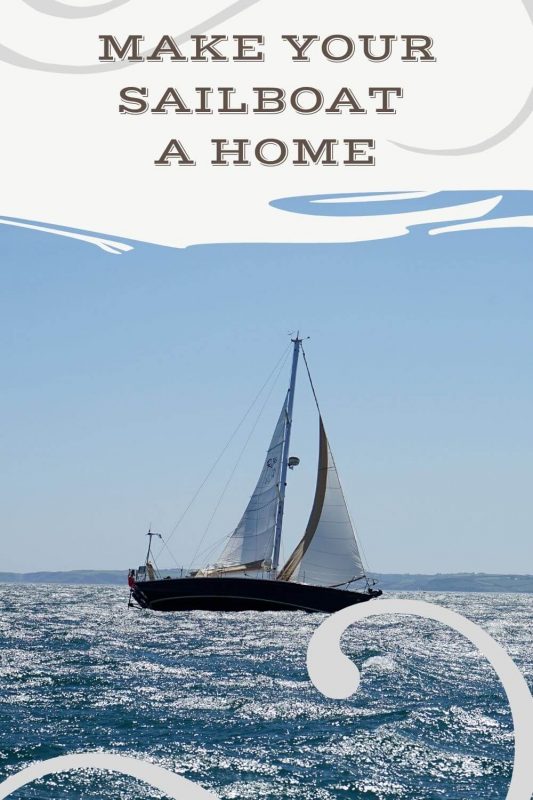
Making Your Sailboat Feel Like Home: Must Have Home Comforts

Storm Sails: The Ultimate Guide
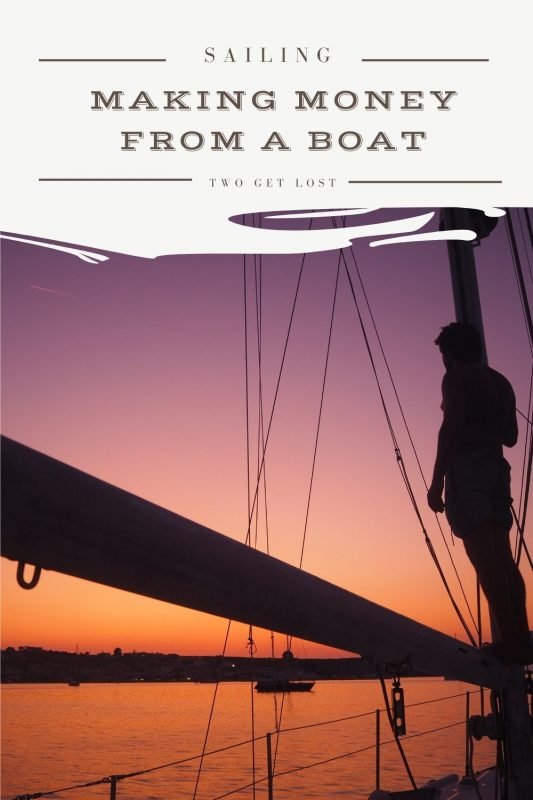
How to Make Money While Living on a Sailboat

Sailing Close To The Wind: How And Why You Should

How To Start A Life At Sea


Can You Live On A Boat On Land And What’s It Really Like?
- Search Search Hi! We’re Emily, Adam and Tiny Cat, liveaboard sailors travelling the world on our 38ft sailboat and writing about it as we go. We hope we can inspire you to live the life you’ve always dreamed, whether that’s exploring the world or living a more simple way of life in a tiny home. Find out more. Patreon
- Privacy Policy

Cat vs Mono – Price & Performance
This might be one of the greatest debates of all time. To be quite honest we had no desire to add our opinion into the already mile high pile.
But back when we were still in the dreaming phase of moving aboard a sailboat , it was the first big question we had. Catamaran or Monohull?
We must have read a few dozen articles but the one we found most insightful wasn’t from a sailing expert. It was written by cruiser who had sailed a catamaran around the world and a monohull around the west coast of the USA and Mexico. It was a well-rounded perspective from someone who wasn’t firmly rooted in one camp or the other.
The article: Cat vs Mono – The Great Debate , was written by our friend Pat and if you really want to have your feathers ruffled, check out his Trawler vs Sail piece.
So, when we saw that our friends Nick and Terysa were considering the switch from Monohull to Catamaran we invited them to come crew with us for a week. With each sundowner we shared, the conversation seemed to circle round to the benefits and downsides of life on a catamaran compared to their monohull. We tried to fight it…but it seemed crazy not to share our thoughts on The Great Sailboat Debate: Catamaran vs Monohull .
There really is no such thing as a perfect boat. We all agree that the best boat is the one you can afford, maintain and get out cruising in. If you have the cash to purchase a small monohull now, then don’t try and wait till you have that 5 million saved up for the latest HH. At the end of the day we’re all anchored in the same beautiful bay with the same million dollar view…its just some of us get knocked around a little more while enjoying that cocktail. 😉
It’s your birthday!
Ok, perhaps not. Unless it is, and in that case, Happy Birthday. But around here your opinions are special, and we want to hear them. Did you find this insightful? Would you like to see more off the cuff chats? Do you have some thoughts you want to share on the great catamaran vs monohull debate? Let us know in the comment box below!
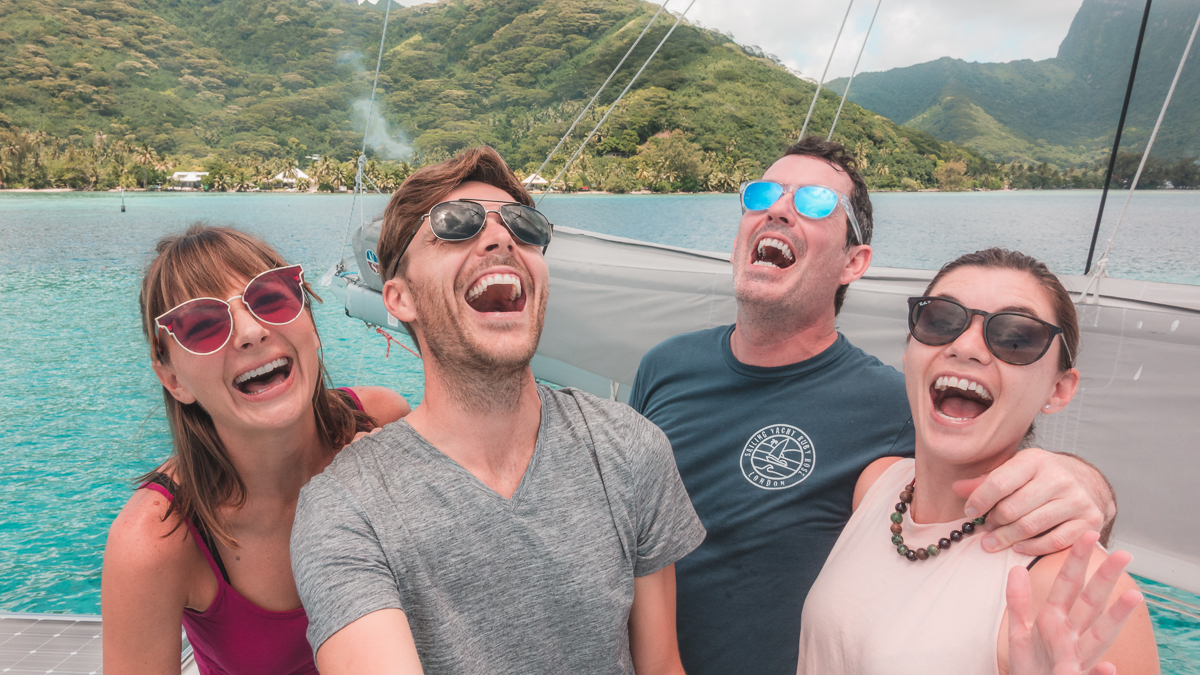
Nick and Terysa documented the week of sailing and shenanigans over on their channel. So, if you want to see what life aboard Curiosity is like from a couple of monohull loving but catamaran considering sailors, here is a binge ready playlist:
Monohull for sale! Ruby Rose (the Southerly 38) is indeed looking for new owners. Full Deets Here: http://yachtrubyrose.com/southerly-38-for-sale/
🙏 THANK YOU!
Sharing our lives and what we learn along the way is possible because of viewers like you . If you like what you see, there are lots of FREE ways you can show your support . Thank you for being a part of the journey.

Hello there! I honestly don’t know what to say, so I am going to tell you a bunch of random facts instead. I'm a fish eating vegetarian who hates spiders and loves snakes. I almost never took vacations growing up. I wanted to be Pippi Longstocking (still do). I misspell about every other word I write and still struggle with grammar. I love splurging on a good high tea (which is really hard to find these days). And whatever you do, don’t tell me I can’t do something, because then I'll HAVE to do it!
Comments (56)
Hi there, love the vids. I am new scribe. Please let me know when a new vid comes. Cheers.
Jeffrey Stork
I haven’t seen Cleo on your You Tube channel this year (2021.) So you still have the cat?
Curious Minion
You must have missed this vid: https://www.gonewiththewynns.com/sailing-pets-goodbye 😥 You can see regular posts on Mr. Singa from his new family @TalesFromTheMutiny on IG or FB. Curious Minion
Clive Mercer
Hi Nikki and Jason Thank you so much for all the videos you post, i love them as they are so informative and educational and funny with them, you are such a great couple who compliment each other. Keep safe and well and please keep the videos etc coming.
Kindest Regards and Best Wishes Clive Mercer (Calne, United Kingdom)
Just found your site a few weeks ago. Great keep it up.
Ernie Gremillion
Really like the personality of your crew. I have viewed perhaps 15 or more and you guys are some of the most fun and interesting. Keep up the cruses and posting
Griffin W Holland
Love your video. This is the first one I have viewed. Hope to see many more. Thank you for sharing.
Randall D Case
Great stuff.. Always enjoy your video..
Laurie Rodriguez
I found you Wynns a few months ago and I must tell you, you brighten my day! I’m obsessed with watching your videos and I find you guys so real, fun and inspiring. I’m presently taking care of my amazing parents in Florida. Both are in their later 80’s and still very active and doing great, but they need help, so watching your adventures has been a wonderful break from the day to day. Someday my husband and I want to get in an RV and travel so I’m also learning a lot too!! Thank you for sharing your experiences, keep up the joy and stay safe! ❤️
John yarbrough
Love your videos, most of all I like your positive energy and attitudes. Please keep making the videos and I will always enjoy your shows.stay safe and have clear weather an safe passage.
Kathy McGroarty
I have so enjoyed sailing the world with you. I lived in a boat for 3 years in my younger days Had a baby while on the boat, that baby is 43 and she and her husband have a 47 ft .monohul that they just moved and plan to start sailing in year or so. Still chasing the dollar, though she works remotely now from the boat. Keep sailing and enjoy your time on the sea. Life is very short! We now live in Texas and it is hot 103 Today.
They say long days and hardships bring a loving couple even closer together. In the last few videos it is apparent to me that you two have done just that. Really fun to watch your adventures. So nice to see two people enjoy each other as much as you two do. Best Wishes And Following Winds.
I appreciate your content. I suggest getting an SSL Certificate for your site so it doesn’t appear as Not Secure. AND, most of all, based on your comment “don’t tell me I can’t do something…” I wonder if you are a Virgo? I know two Virgos very well and that statement matches them both.
Hey Jeff. Our site is secure as our address is https. Not sure what made you think it wasn’t secure? Did you get a warning or something? As for me, I am an Aquarius and Jason is a Cancer.
the website is showing as not secure
Not sure where you are seeing that it is not secure but I will contact our host. Thanks for the info!
Nikki, I’m on your website and it says not secure, however, this will not stop me from visiting. I’ve been a faithful follower since you started in your RV and I love your travels. Your kindness, compassion and dedication is so refreshing.
Yes, I’m getting the Not Secure notice as well. By the way, love your devotion to traveling by the high seas and documenting all. Amazing work at keeping us informed as if apart of your journey. Love.
Nathan Wilmot
main site showing not secure but the swag shop is showing secure.. I’m thinking they only paid for the ssl secure in the location where money was involved.. All good..
All of our sites are secure https. 🙂
Interesting situation – I clicked over from your ‘surrounded by sharks, let’s go swim video (which was AMAZING!), using the on-screen click-box to go to your website, which landed me in this catamaran vs monohull discussion, and these comments about the site not being secure piqued my curiosity. I am not an expert, but tried a few variations, and this is what I found (am using Firefox, in case it is important): First thing I did was note that the URL was simply reading as ‘gonewiththewynns.com/cat-mono-price-performance’ and wasn’t showing an https… so I clicked on the beginning of the URL and added in the ‘https://’ and viola, the site security changed to secure! Next I opened a fresh tab and typed in simply ‘gonewiththewynns.com’ and your main page came up with Firefox having prefixed it with the ‘https://’ and thus it was automatically resolved as a secure connection. So I think the issue lies in the coding of the little re-direct box on the youtube video. I checked one other youtube video with a similar redirect, and that one worked properly (target site loaded as secure), so it doesn’t seem to be across the board issue with youtube, but as I said, I think the coding of that tab-opening-target should be checked. All the Best, LOVE your videos!
I am not too sure about an electric pump setting on a fuel can.
Gasoline – totally agree Pilot – Diesel, you have to work at it to make fire. Alternate plan B – Squeeze Bulb siphon – really cheap, non-flammable have several (they are so costly – JK) no wiring etc
Doing the mobile living that you guys left – enjoy the time and keep the vids coming THANX for the adventures
Hi Nikki and Jason, Tank you for another awesome video. Your video included a clip of you fridge seals dried and cracking. The same problem I have in Oh! My 40’ Leopard. After a long search I finally found a great solution though. New seals from Alberta Custom Gaskets. I just received mine and they are very affordable and ready to install. Just send them the outside dimensions of the gaskets and you will probably need profile 2319, but check to make sure. Their website is http://www.albertacustomgaskets.ca . Cheers Rod Morris SV Oh!
King cowdin
I can’t sail anymore and back problems so I live what I always wanted threw you guys I love your videos.I can’t wait to see where you go next
Simply beautiful pictures and video.
Love all the chatter!
Mary McCorquodale
Absolutely love watching Gone With The Wynns on YouTube. The video is fantastic, the best I’ve seen. Love your catamaran. Most importantly; what a beautiful couple. Keep smiling, you guys are awesome.
Kerri McHale
I honestly don’t get a chance to watch many of your videos, but had to make time for this one out of pure curiosity. Not that I have any passionate opinion on the topic — we just always knew what was right *for us* — but it’s really interesting to hear the perspective of monohull sailors’ experience on a catamaran. One thing I observed during all of the discussion of pros/cons was how vastly different the sailing characteristics of one monohull vs. another can be, even ones purpose-built for cruising. I don’t know much about catamarans, but I assume they’re built/shaped/weighted to sail in a much more uniform manner than monohulls? We have a 40-year-old 35′ full-keel, heavy-displacement double-ender cruiser, and in hearing some of the “stats” discussed for Ruby Rose, I actually often found more similarities between your two boats than Ruby Rose and our monohull. And some things that were *way* different (for example, comfortable top speed: we’ve sailed speeds much higher than those in complete comfort — and we’re still scared n00bs that don’t ever try to push any limits! — likely because the weight/ballast and shapes of our boats are so different), even if we’re both in “half boats” *and* cruiser boats, I didn’t find a whole lot of commonalities in sailing characteristics (I love that “half boat” term, btw — first time I’ve ever heard it; guess no one will say it to our faces!).
Curious Minion here, pinch-hitting while the Wynns are sailing between islands and thus, WiFi. Yes, your double-ended cruiser relies on its weight for stability and is made to just sort of slice through anything, whereas Ruby Rose is dependent more on her width and won’t be as smooth a ride because she doesn’t ride as low in the water. Not sure what you mean about catamarans sailing in a more uniform manner than monohulls? I’m not really a sailor so the finer points of sailing are lost on me.
BUT, good for you for finding your boat and getting out there! As they said in the video, the best boat is for where you are right now and how you’re sailing right now. Fair winds! Curious Minion
Hey, miss minion. 😉 “The best boat is for where you are right now and how you’re sailing right now.” Exactly! I don’t know a darn thing about catamarans, so this is purely my assumption (based on nothing), but I just meant that I assume the shapes and sailing characteristics of catamarans as a group are a lot less varied as opposed to to monohulls (like the huge differences between a performance cruiser like Ruby Rose and a heavy displacement cruiser like Meriwether) — e.g. catamarans ride the water much more similarly due to the keels, shapes, displacements, etc being a lot less varied even amongst different sizes). But for all I know, that could be totally untrue!
Aah, I see and I think you’re on the right track there. There’s probably more variability in cats meant for racing, but less so for cruising cats I would think. I’m sure someone will correct us if we’re wrong.
Fair winds! Curious Minion
Molly age 11
Hey Nicky, So have you thought about the bloops! Ref my post on your last vid!
BLOOPER VIDEO PLEASE!! A blooper video would be hilarious and so great to watch! We agree Molly! Everyone in this life needs to laugh more, laughter really is the best medicine. We bet Jason and Nikki would put together a fabulous blooper video, it would be epic. If more of us write about nicely requesting a blooper video, maybe it will put a bee in their bonnet! Please, please, Jason and Nikki, make a blooper video!! Pretty please, with sugar on top…as our kids would say. Love you! Kudo’s to Molly, for starting this thread!
David Burnett
Great balanced discussion guys. Certainly there are pros and cons for any boat – mono or multi. I don’t think anyone could argue that a mono wins hands down as far as grace and aesthetics are concerned. A cat wins on space and the great advantage of having one hull for the owners, and one for guest, or children etc. However the load carrying is an issue – it seems the forward section of those hulls is usually fairly empty due to weight issues, whereas it is not unusual to have a tonne or more of anchor and chain right up in the bow of a mono. Nice to have a back-up engine too on a cat – the consideration of two sets of impellors, two sets of exhaust elbows, and double the time for an engine service is in my view worth that back-up. Also of course great for manoeuvrability, but then monos have bow thrusters that do a pretty good job.
Liveability on a cat- up there in the breeze, rather than being down there in the heat is another factor. Then there is the sailing – well for the ultimate sailing experience, then at the helm of a nice mono, heeled into a nice breeze is pretty hard to beat (but then others would argue they don’t like heeling – they just want a flat ride). On that, there is stability – a cat is stable, and more comfortable in a swell. That stability applies however whether it is right way up or not (sorry, but those hatches in the bottoms are not for looking at the fish!) This ‘argument is never going to be won – for some, a mono is right, for others a cat. For some a mono is right in some places, a cat in others, and so it goes on. Mention was made regarding antifouling – the issue of two hulls to do. Well, with a cat, you can beach and give the hulls a scrub, with a mono, you have to go over the side, or haul. On that, I continually shake my head when people talk about antifouling – we don’t. Since out boat was new in 2012, we have not touched the hull (yes, there’s the giveaway guys – we have a mono :).). We just scrub or pressure wash from time to time, but do not paint the hull. Our Coppercoat is going strong eight seasons in, and looks like going for another eight at least, so that’s one expense that can be avoided – mono or cat.
There are plenty of other factors to consider, and of course there are the exceptions too – mono or multi.
We look forward to part two of your discussion – great stuff!
Thank you. David SY Te Anau Sharing Life
Jason Dorsey
Absolutely love watching your video’s. Wife an I and our 2 kids are within a year from moving onto a boat for good. Agree totally with buying a boat for what your doing now. Sold our sailboat for a Hatteras powerboat as we use it only on the East coast, and the Chesapeake bay currently. Plan is to get a bigger boat next year to voyage further. Most likely a sailboat again. We are also torn between Cat or Mono. I feel reading all the comparisons the one thing everyone is missing is comparing apples to apples. The great equalizer is money. I think if you have 350K to spend you have to compare a 350k catamaran to a 350K mono. So in reality it is a 40-44′ Cat vs a 50-60′ Mono. I think operating costs of the two would likely be equal. Space would be closer, certainly could still argue about usable space but the extra 10′ of waterline length changes a lot of the comfort, speed, and safety comparisons. Another big issue we have seen when you compare a 50’ish Mono to a 40’ish Cat is storage space, refrigeration/freezer size and such. Seems there is almost double the storage space on the Mono. Cat is the easy winner when you compare two equal length boats. Gets a lot tougher when you compare say a Leopard 43-44 to a Oyster 53 / Hylas 54 as these would be the approx same price used. Just my two cents as my hair gets grayer searching for our almost perfect boat! Keep up the great work.
Keith Moser
Whatever you choose is the right one. My/our first boat was a monohull. I never ever had a boat to be on a boat powered by wind was the most wonderful experience of my life. If I wasn’t so crippled my boat would be xquisite without a dought or a second hesitation. Learning to sail is easy it’s like walking just do it.
I really enjoyed your informative video with the comparisons between the two types of hulls and their advantages and disadvantages. Those are the pieces of information that I absorb as that’s the way my mind functions. Yes, I would enjoy seeing more of this type of video. Very entertaining for me.
I keep meaning to ask; You and Jason are always walking but at one time you had bikes aboard though you weren’t sure if they would earn their keep. Do you still have them or were they repurposed as anchors?
Haha – almost anchors! They sold them in Ft. Lauderdale after their first trip to the Bahamas. Although they were handy to have, they were really difficult to get in & out of storage & load on the dinghy, and sometimes they were almost impossible to get off the dinghy onto the dock. So walking & public transport it is! Curious Minion
Gary Church
Great discussion. I have sailed and motored a variety of boats (makes and sizes) and your observations and comments are right on target based on my 50 years of boating.
Currently my wife and I are spending the hurricane season in Grenada on our 64’ Grand Banks Aleutian Trawler. We are fortunate to have a boat virtually without compromise. It is surprising however to see 95 percent of the boats in the Caribbean south of the Bahamas are sailboats, half monohulls and half cats. Personal trawlers and motor yachts are few and far between.
Jonathan (and family) in Canada 🇨🇦
Another informative and beautiful video! Our family looks forward to watching your videos every Sunday, without fail, here in chilly Canada! We have sailed on both mono’s and cat’s many times, for many years, during many different stages of our lives as a family. Honestly, we can say from our experiences, that a cat is the way to travel on the seas. It is far superior for comfort during rough seas, space-wise to keep a family somewhat sane together, and with the double engines, getting to where you want to go is never an issue. Also, if one engine fails, you have the other to use. Our kids adore the “sugar scoops,” they favour them for great fun, all the time. It is their hang-out area with friends etc. Cost is the biggest issue, we have found, both with us and our friends, in being able to afford the cat lifestyle. But, boy is it worth it! Once a cat owner, always a cat owner! We have never, ever, encountered a sailing family saying they are going back to a mono after living on a cat. Never. And I am in my 60’s and have sailed virtually my whole life, in one capacity or another. Thank you again for your beautiful videos.
Part 2-Jonathan again! From Canada 🇨🇦
Please, if I may add, as I can’t stress enough, the huge importance of everyone on board being certified in First Aid. And to take refresher courses often. Even children; there are classes geared for children too. Medical emergencies on boats especially, happen more often than most might at first realize. Remember to update and revamp your on-board first aid kits often, and teach everyone where they are located, this goes for the EPIRB’S too. —Our rule is: as soon as guests get on our boat before we leave for a sail, and to refresh the ‘regulars,’ we, as a group, go through what to do in case of emergencies. The Captain and Helms-woman/man must be told of all medical conditions of all boat guests, PRIOR to departure. We have been approached by other boaters needing medical supplies and requiring life-saving assistance, quite a few times. I have been so proud of my family for going to their stations and following through quickly with pre-learned procedures, during hair-raising situations. Practice every possible scenario, because, we guarantee, it WILL sometime in your boating history…happen. We have been shocked at how little, if any, supply-stocks, some other boaters carry on board for emergencies.
Excellent reminders, Jonathan! Never feel bad for speaking up about boat safety anytime. We feel Nikki and Jason won’t hesitate to print good reminders on safety, like you wrote about on their blog. They seem like very safety-conscious sailors! We too have had to hand over supplies, especially med supplies, to other boaters in an emergency. We agree it is disappointing and shocking that so many boaters are out there without proper supplies on board. ;)…Maybe Nikki and Jason could do a video on what kinds of emergency supplies a boating family should have on board at all times?? (Hint, hint!) We too have to vote in favour of owning a cat. As mono’s look beautiful in races, so streamlined and elegant, a cat is perfect for families wanting to sail without losing their minds…aka, try boating with teenagers in a mono…not much fun. We did it many times and my wife and I almost jumped ship!!! Then we got a cat…and it has been smooth-sailing, raging hormones and all.
Interesting – we have. They sailed for years on a cat up in the tropics and Asian areas. now back in Australia they have gone back to a mono. Horses for courses.
We hear you David and we too have sailed on a mono with teenagers. When the opportunity to buy a Leopard 48 Cat came up, we couldn’t turn it down, it is just too spacious, has the ever popular trampolines and sugar scoops, etc. Gorgeous views from the huge windows, big front loading fridges too. My wife got sick of trying to dig out food from the mono’s top-loading fridge/freezer all the time and cook in that tiny galley. The amenities list is massive on this cat. We feel more a part of the outside now, whereas in our old mono, we were kind of cutoff from the outside, down in the saloon. Plus my wife is a Chef and is so much happier cooking/baking in a cat kitchen, which is all level with the outside entertaining area/tables. Her going up and down the tiny ladder to get out of the mono, laden with plates and serving trays, made for an unhappy wife. We were constantly cleaning up spills when everyone had to maneuver that ladder, laden with food and drinks. Try doing that with a young grand-baby in your arms too! And I love her cooking, boating seems to make us all extra hungry. Something about being in the ocean air, we surmise. Don’t you find that too? The cat is just so family adaptable (for us and our brood) and easier to sail for long periods of time without wanting to jump ship. But, you are so right…to each his own! Maybe we are spoiled but we came to the conclusion, that life is short, so why not enjoy ourselves and get a boat that makes us happy and isn’t such a chore to just get through each day.
Pam McClure
Wow. Very informative especially to a non sailor like myself. Learned a lot. Thanks to all of you.
I loved Jason’s “half-boat” comment. It can roll eyes many old salts. It is funny though. The discussion is very informative and spotted on – thank to Nikki moderating. A cat definitely will double one’s survival chances in resources and capabilities to face the challenges Mother Nature throws at them.
Unless it falls over !
anil vijay madgavkar
very nice and sensible discussion.
As we get older ( I am 67 ) our balance is no longer as good as earlier, and CATS are most definitely a better bet because they are far more stable.
I love CATS so maybe I am a bit biased !!
Happy sailing.
Kevin Peronard
Thought it was really good discussion you had, and I like to see your thoughts and others on this debate. Also a lot of the things I had also heard and found around the net. As I am looking in to getting a boat of my own. But really enjoy your channel
Did you manage to get the Watermaker sitiation resolved before your guests arrived?
We did! Picked up the new pump, installed and working like a champ again. 🙂
Nancy Fernandez
Great to hear you got it running again. Clean fresh water!
That’s good to hear. It must have been such a boring event, there wasn’t any reason to report… which is really how you want to have events like that.
Post a Comment cancel reply
Save my name, email, and website in this browser for the next time I comment.
YOU MAY ALSO LIKE
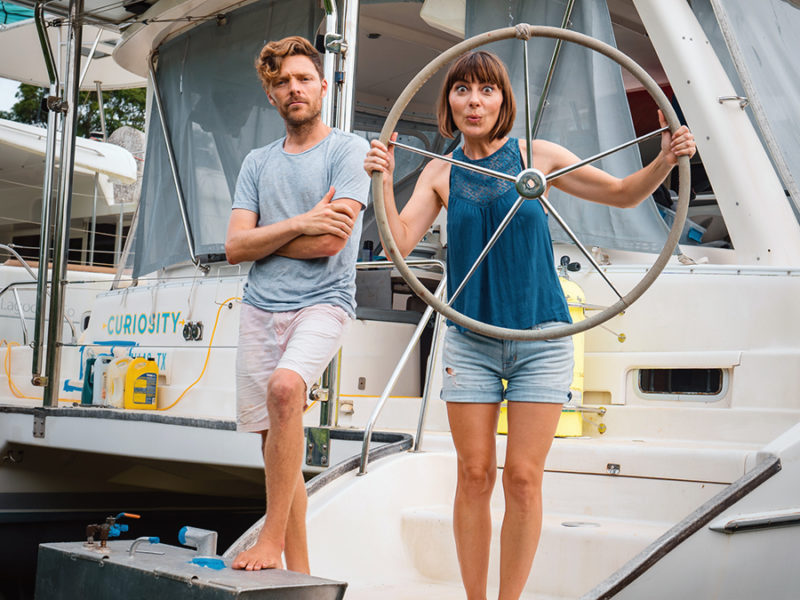
Knocking Out Boat Projects. So Close To SAILING!
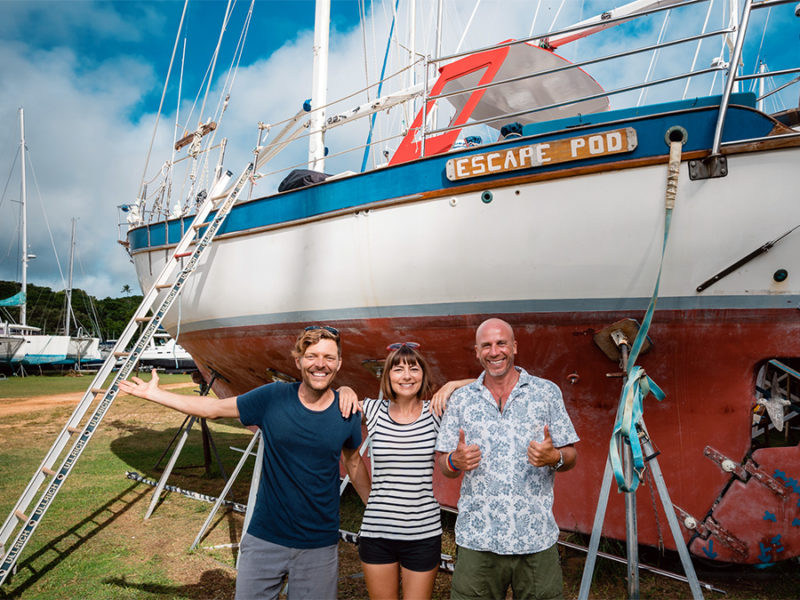
BOAT TOUR: The Irishman & His Electric Escape Pod

Scammed On Anchor Chain, What You Need To know.
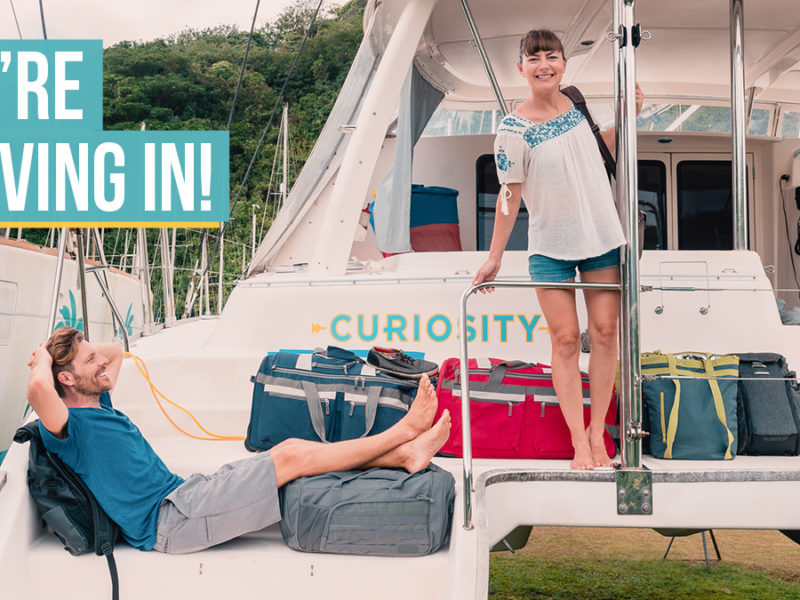
Living on a boat OUT OF THE WATER
Call Us (561) 445-5664
Catamaran vs. Monohulls: Pros and Cons
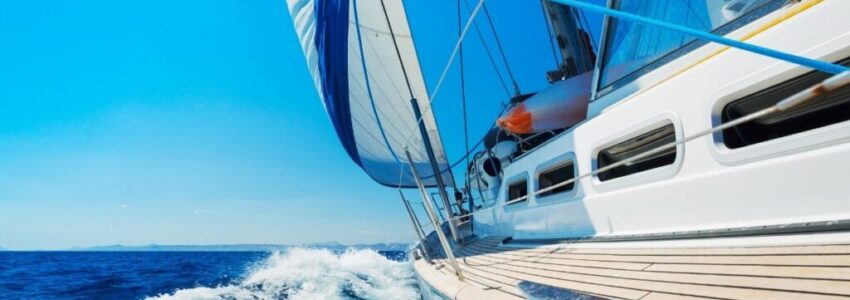
Published Aug 30, 2021
Going on a trip but don’t know what boat to use? If you have been eyeing Catamaran and Monohull boats, you are in the right place. If you can’t choose between the two, knowing their pros and cons should help you decide. In this article, we will be battling catamaran vs. monohulls to determine which one is more suitable for you.
What is Catamaran?
A catamaran is a sailboat with multihulls that features two parallel hulls of equal size. This type of boat has been popular ever since because of its stability and size. In addition, vacationers tend to sail with catamaran boats because of their space above and below.
What are Monohulls?
Unlike catamaran boats, a monohull is a boat that comes with only one hull. Monohull boats are the most widely used form of waterborne vessel. Sailing in a monohull may satisfy a person’s inner sailor self and give them the whole sailing experience. In addition, this type of boat is cheaper than other boats since it only caters to one hull.
Since catamaran and monohulls are completely different boats, we should compare and contrast their characteristics.
Spaciousness
The multihulls of catamarans give the boat additional space for the galley, cockpit, and more rooms when it comes to space. Catamaran boats also feature shallower draft, smaller displacement, and less hull volume than monohull boats. Therefore, this boat is more spacious than a monohull boat. It should be what you’re looking for if you’re sailing with family or friends.
On the other hand, monohull boats provide limited space, and most spaces are below the waterline. This might be concerning, especially for non-sailors, like vacationers. However, long-time sailors are most likely used to this situation. In addition, a monohull is smaller than most catamarans since it only consists of one hull.
Stability and Comfort
Another advantage of having multi-hulls is inheriting more stability than a one-hull boat. Catamarans are less prone to rocking and heeling, which makes them an ideal boat for family vacations. Large families usually include kids or seniors that get out of balance easily. Sailing in a catamaran boat would surely be more comfortable for you. Catamaran also features a separated skipper cabin that separates the crew and boat guests. Some larger skipper cabins provide full equipment like an isolated shower, sink, and toilet. In catamaran boats, you can sunbathe, lounge, or even jump on a trampoline while onboard.
Monohull boats are obviously less stable than multi-hull catamarans. From the word “mono,” monohulls only have one hull, which makes it prone to being rocky than a multihull boat. A rocking boat might not be an ideal vacation boat for families.
Here are the advantages and disadvantages of sailing for both boats:
Catamaran boats are often faster than monohulls when sailing downwind, reaches, and broad. Moreover, they have low bridge decks likely to slap on the undercarriage when the boat is sailing upwind. That is what slows the speed of the catamaran boats.
Monohulls sail through water without any slapping or pounding that may slow down the boat. They tend to be faster than catamaran boats when going upwind since the slapping slows down the multihull.
Pounding and slapping
Multihulls are made so that guests and sailors can get the most out of their vacation. That is why producers of catamarans try their best to add as much platform in the boat as the low bridge deck. Unfortunately, the low bridge deck of a catamaran tends to pound and slap the undercarriage of the boat, especially when sailing upwind. Some people find the pounding and slapping sound annoying.
Monohulls don’t have a low bridge deck, so sailing comes smoothly for monohull boats. Monohull guests wouldn’t have a problem with the noise at all.
Maneuvering and docking
Multihulls are powered by two engines. Having two engines can be extremely helpful when it comes to an emergency. These engines make it possible for the boat to rotate to a full 360 degrees. Catamarans also have two rudders which makes it easier to dock the boat.
Monohulls are easier to maneuver because of their size. However, the monohull only consists of one engine for the whole boat. The engine of the monohull can be combined with a front bow thruster so the yacht/boat can move sideways, which is helpful for tight spaces. This function makes it easier for the sailor to dock the boat.
Catamaran boats are more expensive than most monohulls because of their features. They are known as a high-quality boat that reassures sailor’s guests that it’s safer than most boats and costs a lot of building materials as catamaran boats are more spacious. Catamaran boats may cost more because it’s a high demand boat. The cost for docking for this type of boat also costs double the price of a monohull since it’s bigger.
Monohulls usually cost cheaper than most catamaran boats because of the monohull’s building materials. Multihull boats typically need to double the building materials required for a catamaran. Therefore, monohull boats with the same sleeping capacity and equipment as the catamaran may cost cheaper than buying a catamaran.

Catamaran vs. Monohulls: What to Choose?
Catamarans are more expensive, but it’s a family vacation-friendly boat that offers a lot of advantages. On the other hand, monohull boats are cheaper, simpler, and perfect for aspiring sailors. In the end, it all comes down to the person’s preference, budget, and what suits their needs. So I will ask you, catamaran vs. monohulls? (Related: What to Know Before Renting a Catamaran Charter )
Experience Yacht Charters With Seafari In Boca Raton Florida
Looking for a great time on the water in Boca Raton Florida? Seafari Yacht Charters is number choice for yacht rentals in Boca Raton . Book our yachts for parties , exciting day trips to the Bahamas, romantic yacht dinner cruises , and much more. Come experience all South Florida has to offer with us.
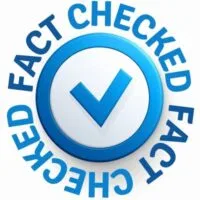
Fact Checked By Experts
Our team of internal experts has conducted rigorous fact-checking on this content. Explore the editorial standard for our website to dive deeper into our commitment to excellence.

About The Author
Krizzia Paolyn has a bachelors degree in Psychology and a passion for yachting in South Florida. She has a desire to be heard and to encourage others to make their voices heard as well.
Related Posts
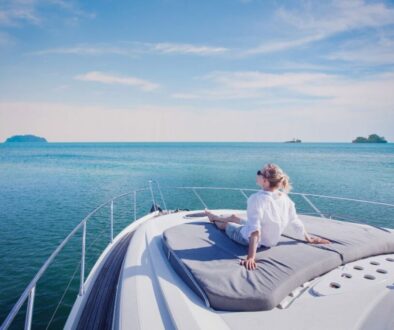
Yachting Benefits You Might Not Know
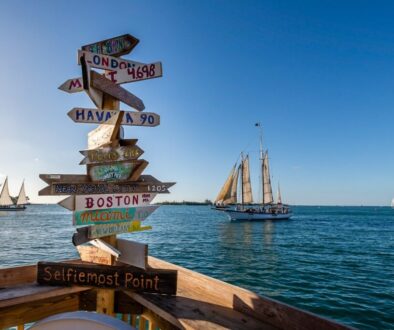
Most Popular , Yachting
How To Charter A Boat From Miami To Key West
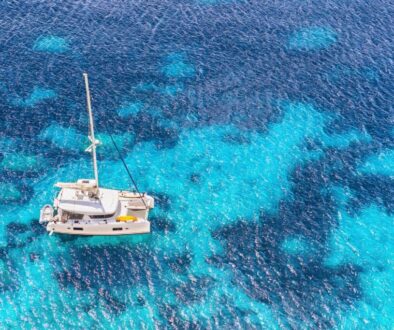
What To Know Before Renting A Catamaran Charter
Find us on social media.

© SeafariYachtCharters.com 2024
View Our Privacy Policy
Website design by Correct Digital
Catamaran vs Monohull – Which is Better?
Which is better a catamaran or a monohull.
I’m often asked by my students why one would choose a sailing monohull or a sailing catamaran for their adventures. The simple answer is: There is no simple answer — it depends on a lot of things, perhaps the most important one is your preference. “Yeah, well, this is my first week sailing ever, so how do I have a preference?” Let’s explore the differences and discuss the ins and outs of sailing, chartering, performance, and living aboard either vessel.
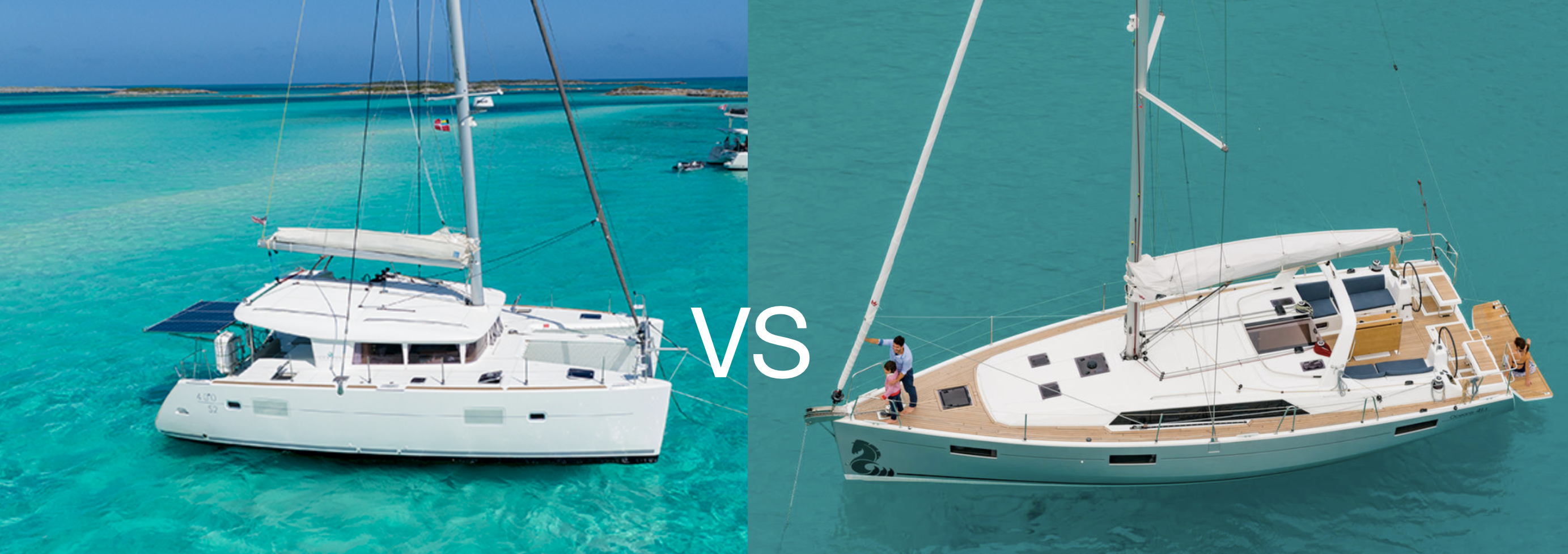
Notice that I don’t say “pros” and “cons” when considering the differences between the two vessels. To some, the gentle rocking of the monohull elicits nostalgia for a bygone youth spent sailing dinghies in the bay. To others, it represents sleepless nights, banging kitchenware, and angry spouses.
Short Summary – Catamaran vs Monohull
Generally, I describe my preference as follows: If I want to invite guests that are not frequently on the water, have less tolerance for “bumpy” nights, or expect a more “luxury” experience (you’ll see why I put it in quotes shortly) then I select a sailing catamaran. There is more room to spread out (vs the same length mono), rocking at anchor/mooring is minimized, and the kids love playing on the trampoline. Or perhaps phrased differently, “If you want to drink from beach to beach…”
DO NOT DRINK ALCOHOL WHILE OPERATING ANY VESSEL. EVER.
If, however, you want to put some miles down sailing from port to port in the Med (or wherever you have variable wind direction), then the mono is probably the better option. It has better upwind performance and costs less in marinas.
Let’s get into the details. We’re going to compare a suitable, common charter catamaran ( Lagoon, 40 ’) with a good, common charter monohull (Beneteau, 41’).
Sailing and Performance
The monohull total tacking angle is about 90-100 degrees apparent wind angle (AWA). This means that the closest close-haul sailing angle achievable is approximately 45-50 degrees off the wind. The comparable catamaran has a total tacking angle of about 110-120 degrees (55-60 degrees AWA off the wind). This loss is due to the extra leeway experienced in the catamaran. This is a significant difference when trying to beat to windward and can mean the difference between sailing the entire distance vs putting the sails up for show only. For those interested in math, the progress into the wind is determined by the cosine of the close haul sailing angle (angle of the wind) times the length of the leg on that tack.
windward distance = cosine(𝜶) x leg length
Where α is the close haul sailing of the vessel. Table 1 compares the windward distance achieved of 3 sailing angles over a leg length of 1 unit (nautical mile, km, etc). For example, if the leg length is 1 nm, and 7 legs are sailed, a total distance of 7 nm is covered. However, the progress to windward is not 7 nm, but
cosine(𝜶) x leg length = cos(45°) x 7 nm = 0.71 x 7 nm = 5.0nm
for a monohull sailing 45° to the wind, and 4.0 nm for a catamaran sailing 55° to the wind. The final difference after 7 tacks each is 1.0 nm, which would take the catamaran an additional 2 tacks (and just shy of 2 nm distance sailed) to make up the difference.
Table 1. Sailing Angle and Distance Comparison Sailing Angle (off the wind) Windward Distance Achieved % loss from 45°
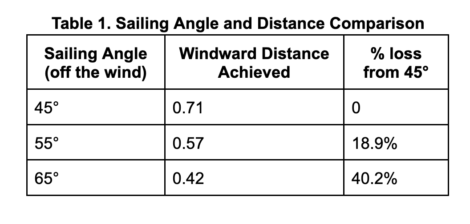
Figure 1. Sailing Angle Mono vs Cat
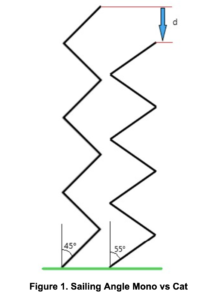
A real-life example
Sailing from Mallorca on a new Lagoon 40. We needed to sail directly upwind in about 20 knots of wind, 3 miles from Cala Mondragó to Cala D’Or. It took over 2 hours and we sailed over 7 nm. As you can see, the tacking angle is far from 90º typical to a monohull.
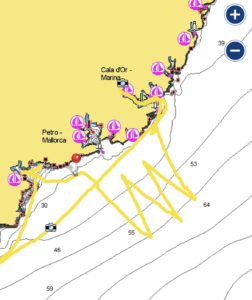
Additionally, the loss to each tack must be considered. Speed and headway is lost with each tack – the mono carries its momentum much better (minimal speed loss) through the tack and has minimal leeway loss compared to the catamaran. The cat loses a tremendous amount of its momentum and experiences significant leeway loss. And it has to take more tacks to make the same windward distance, rendering the loss greater than that just lost to having to sail a greater distance due to the tacking angle.
Daggerboards greatly reduce leeway and give catamarans excellent upwind performance on par with monohulls. There are reasons why all cats don’t just have daggerboards. Especially on charter boats, one mistake, leaving the boards down, in shallow water can destroy the boat.
Across the wind (most reaching situations), the catamaran is faster. Upwind, the mono makes better progress due to the tacking/sailing angle. Downwind is a competition.
Downwind is where catamarans really shine. The stability and smooth ride is no comparison to a monohull. We sailed Never Say Never, our Lagoon 400S2 from Hilton Head SC to Ft Lauderdale, we had a NE wind of 20-25 knots. For us to stay inshore of the Gulf Stream to avoid rough conditions, we were wing-on-wing for over 24 hours, surfing down gently at over 7 knots. We covered over 160 miles in 24 hours. Escorted by dolphins, this was one for the books —non-stop 3-day delivery.
Comfort & Stability
The catamaran doesn’t heel (well, it shouldn’t. I guess if that’s the case we’re having another conversation ). No heeling can mean easier walking about while underway: we’re all familiar with walking on level ground; walking with the ground at an angle is a less-common experience. However, there is an oft-missed discussion about the mono’s stability on a heel. Waves tend to roll under the mono’s hull. Once sea legs are found, the motion of the hull on the water is predictable and smooth.
The cat’s motion on waves tends to bounce between two “stable” states: one resting on the starboard hull, the other resting on the port hull. You get a slight, but sudden rock to starboard when the wave passes under the port pontoon, then a sudden return to port as the wave passes under the starboard hull. This tends to be a jarring motion all day. So while some argue that mono heeling is tiring, others will argue that this cat phenomenon is tiring. A sarcastic captain often says:
“One benefit of a cat, you get each wave twice!”
Each vessel has its own quirks for sail trim, so that is a wash. I can read a mono’s sails much easier than a cat’s, but I sailed monos for 20+ years before trying cats so I may be biased.
Catamaran vs Monohull Safety
The mono gives lots of feedback about being overpowered long before it becomes a problem: heel angle and weather helm are the loudest. The cat is much more subtle: mast and boom groans, light windward pontoon, lack of steerability. Experiment with the main traveller position and reefing on a schedule per the owners manual to find the optimum sail configuration on a cat.
When the seas pick up, catamarans do much better downwind. Monohulls tend to roll, yaw and wallow in the troughs and round up on the face of the waves. Catamaran’s tend to surf straight down the waves. A force 7-8 blow can be enjoyable. Stow your main and run with just the jib downwind on a cat and you’ll see the beauty and ease to steer this configuration.
“When the seas pick up, catamarans do much better downwind. Monohull’s tend to roll, yaw and wallow in the troughs”
Chartering and Living Aboard Considerations
Charter cost – cats are 30-60% more expensive than the equivalent mono.
In marinas, the cat rate is usually 50% greater than the mono rate. And, unless you get a reservation long in advance, they might not have room for you.
On moorings, depending on the bow cleat location, the mooring lines can run over or along portions of the hull of the cat. This leads to line stretch-and-relaxation noise all night long. For anyone in the forward cabins, this is a nightmare. Or worse since you can’t even get to sleep to have a nightmare.
Cats tend to have shallower draft and therefore can anchor closer to the beach. If wind and swell are from the same direction, cats tend to weather it better at anchor. Due to the bridle, cats do not swing on anchor. Older monos used to swing a lot, modern designs have reduced this swing tremendously.
There is lots more room on a cat to house the luxury amenities like A/C, water makers, and generators. Though, modern design is allowing for clever locations for these items in the mono, so there will probably be more monos becoming available with these options.
Cats tend to carry more potable water than the mono. They also carry more fuel. And burn more. Our weekly mono fuel bill ranges from $80-150 USD. Our weekly cat fuel bill ranges from $180-300 USD. (1.) Though you pay more for a catamaran, most systems are redundant. Two engines are better than one.
Catamaran vs Monohull Maneuverability
Cats are far easier to maneuver under power due to the two engines being separated by such a great distance. This makes picking up moorings, dropping and weighing anchor, and docking a breeze.
I would argue that monos are easier to manoeuvre under sail due to large rudders and heavy keels. The heavy keel maintains its momentum through manoeuvres much better than the cat. The large rudder means a small helm adjustment is quickly experienced in the respective heading. This large rudder also reduces steerage way to about 0.75-1.0 kts, whereas the cat is about 2.5 kts. While I doubt we’ll see cheaters , I mean bow thrusters, on 40’ monos, I have seen them on 44’ monos before. This added amenity makes up for greatly increased manoeuvrability while docking or weighing anchor.
Dinghy Storage
Storing the dinghy on the davits is a wonderful location for passages of any length. The reduced drag from not towing it is immediately seen in increased sailing speed. Monos must carry theirs on the bow or tow it astern. And you have to take the engine off too. Usually by hand, so you are not going to see a 20HP electric start engine on a dinghy for a 40’ mono. Not that you’d see that size for a 40’ cat either, but a 9.9 – 15 HP isn’t out of the question.
Ultimately, it boils down to what your preferences are. Do you like the extra space and amenities the cat provides? Do you like the sailing performance of the mono? Again, I choose a cat to sail from island to island in the Caribbean, where having a water maker or A/C is nice, fairly flat water is expected at all times, and anchoring close to the beach is a cool experience for everyone on board. I choose a mono to sail greater distances, go offshore, or hop from one marina to another in the Med.
1. This article was written in the spring of 2022, just before the crazy increase in fuel prices. As of publication date, these numbers need to be adjusted higher by about 50-100%

Ben Martin is a long-standing instructor at Nautilus Sailing. ASA 201, 203, 204, 205, 214 Certified Instructor, RYA Yachmaster Offshore, USCG 100 Ton Captain. Ben grew up in Northern Maine sailing dinghies on a lake. He graduated from University of Maine with a Master’s in Electrical Engineering. After working for the US Navy for a few years, he decided to pursue his passion on the water and worked as a charter yacht captain for several years in the Caribbean and the Mediterranean. Eventually, his career led to sailing instruction and he hasn’t looked back since.
- ← Prev Post
- Next Post →
HOW IT WORKS
Connect With Us
Plan Your Trip
START YOUR SAILING JOURNEY NOW
As featured in.

EXCLUSIVE EVENTS
The only way to join our tribe is to learn to sail with Nautilus.
We’re really careful to make sure that we know and trust anyone coming on one of our special trips.
Join us on flotillas, offshore deliveries, free webinars and unforgettable sailing adventures around the world. Join the Tribe.
- TERMS OF USE
- Privacy Policy
Catamaran vs Monohull
below An Outremer 50S tuning before the start of the famous La Route du Rhum.
In order for us to appreciate the advantages of a catamaran it is important to be aware of their different attributes as compared to their ballasted counterparts. Although both types of vessels rely on watertight hulls to safely separate seawater from precious cargo on the inside, their stability is achieved via totally different means. Data of a typical 45' monohull will be compared to a 45' cruising catamaran, illustrating the

diverse characteristics of both types of boats. Why are multihulls generally faster and do people really get less seasick sailing them? In this chapter we objectively investigate advantages of catamarans such as their stable and spacious environment, low draft and the fact that beginner sailors feel more confident. But be aware, not everything is all roses. Although the well-designed and -built cruising multihull provides many rewards in terms of safety and handling, we will also investigate some of their drawbacks.
Higher maximum and average speeds are what multihulls are all about and this is maybe the most important characteristic which lures monohull sailors to catamarans. L. Francis Herreshoff, a legendary American designer once said: "The fun of sailing is proportional to the speed of sailing." Let's be honest. Isn't it true that every single time we sail and see another boat heeling in the breeze, we want to catch it? Mostly we do it quite inconspicuously so that no one realizes that we are actually trying to overtake a competitor, but in the back of our minds we are always racing. Speed is more than just fun. There are times when we are actually participating in a race and by having a fast boat our chances to win are obviously higher. And what a joy it is to win!
In an incident at the Annapolis Demo Days 3 years ago, I sailed on an Outremer 45 on the Chesapeake Bay with 10 clients aboard, in about 12 knots of breeze. We were heavily loaded, had cruising sails and were certainly not in racing trim. My guests on board were in absolute awe, as we sailed faster, pointed higher and at
Copyright © 2006, 2008 by Gregor Tarjan. Click here for terms of use.

the end overtook a J-40 monohull with Kevlar sails, a boat that is considered by most to be one of the ultimate monohull cruiser/racers. The definitive speed comparison between monohulls and multihulls is most apparent at the annual Around Long Island Race (ALIR), which takes a fleet of ca.150 monohulls and a dozen multihulls past New York City, in a 220-mile offshore race around Long Island. The multihulls usually start about one hour after the leaders and it is not uncommon for us to have overtaken the entire fleet within the first 40 miles of the course. I have participated in 5 ALIRs and every single year we have an upwind start into strong headwinds. Many proponents of monohulls will say that sailing upwind is not the strength of catamarans, yet it is always on that first leg sailing to weather, where we pass almost the entire fleet. It is interesting to see monohull crews in their full foul-weather gear acting as "rail meat" taking spray, while we blast by on the level with cocktails on the cockpit table discussing sail trim.
Speed has won wars, turned commercial fisherman into wealthy business entrepreneurs and has been also a contributor to safety. In battle, a fast warship could outmaneuver its adversary or even run away from a boat with more firepower. Higher performance meant that Gloucester schooners , 100 years ago, could race against each other back to port and offer the freshest catch at the highest price. Just as in history, speed of a sailing yacht is important and gives a faster yacht more options.
above The new, all infusion-built, Fountaine Pajot - Lavezzi 40, powering along under asymmetric spinnaker.
True Wind Direction
Polar Diagram degrees
Beat Speed degrees

120 degrees
150 degrees
45' CATAMARAN
20 knots with gennaker 20 knots True Wind 14-16 knols True Wind
45' MONOHULL — 14-16 knois True Wind —. 20 knots with spinnaker
The polar diagram illustrates the varying speeds attained by a multihull, especially off the wind, where performance differences can be as high as 50% as compared to monohulls.
Personally, the most important benefit of speed of a multihull is the ability to outrun bad weather. Being able to average 11 knots on a catamaran, rather than 8 knots as on a monohull, will give you more options in your strategy of avoiding bad weather. Getting to your destination quicker and shaving off days on a transatlantic voyage will simply mean that you have mathematically less chance of getting the toilet clogged, running into a submerged container or falling overboard. Thanks to advances in radar, satellite and computer technology, a five-day forecast today is as accurate as a two-day forecast was in 1980. A multihull's higher speed will greatly contribute to easier and safer planning of ocean passages around weather windows, since exposure time will be less and meteorological prediction for shorter periods more accurate. Being able to sail faster will also introduce the concept of apparent wind to the strategy of efficient sailing.
Sailing upwind, the multihull will usually experience more apparent wind across the deck since she is sailing faster, hence the sails will feel more pressure, making the boat perform even better. The concept of apparent wind will greatly contribute to the joy of sailing, as it adds another dimension. When sailing towards a downwind destination, fast multihulls will be able to sail at smaller wind angles, often bringing the apparent wind forward of the beam, optimizing the angle of attack on the sails. Whereas multihulls will fly gennakers, Code-Zeros or asymmetric spinnakers, monohulls in contrast will set symmetric spinnakers off clumsy poles. Their boat speed will often cancel out the true wind, reducing the apparent wind and performance. The faster the multihull is the more she will be able to take advantage of the apparent wind and tack downwind towards her destination. Although she might be sailing twice the distance, she will arrive at the downwind mark quicker because her Velocity Made Good (VMG) will be faster.
Continue reading here: Draft
Was this article helpful?
Recommended Programs

Myboatplans 518 Boat Plans

Boat Alert Hull ID History Search

3D Boat Design Software Package
Related Posts
- Decision Parameters - Catamarans Guide
- Catamaran Design Guide - Catamarans Guide
- Catamaran Sailboat Wide Bodied Hulls
- Hull - Catamarans Guide
- Sailhandling Monohull vs Multihull
- Asymmetrical Racing Hulls Catamaran
Readers' Questions
Are catamarans faster than monohulls?
Yes, catamarans are generally faster than monohulls. Catamarans are known for their excellent speed, often achieving speeds rivaling those of much larger monohulls. Additionally, the two hulls provide a greater stability, meaning they cut through the water more easily and without the drag experienced in a single-hull vessel. This makes them ideal for racing, and they are often used in competitive sailing events.
Do monohull boats go faster than multihull boats?
In general, monohull boats are faster than multihull boats, especially in open water. Monohull boats are generally propelled by a single hull and have less drag, allowing them to reach higher speeds more easily. Multihull boats are typically propelled by two or more hulls and tend to experience more drag, making them slower. However, multihull boats can be very fast in light winds and calm waters, as the additional hulls allow them to leverage light wind power more efficiently.
Which are safer catamarans or monohulls?
Catamarans are generally considered to be safer than monohulls when it comes to stability and capsize risk. The more shallow and wide hulls of a catamaran create more stability than the deeper and narrower hull of a monohull. Additionally, catamarans have greater buoyancy and floatation, making them less likely to sink in the event of an accident.

Matt Weidert
Catamaran vs Monohull: Why the Cat is Better for Your Sailing
- We enjoy the extra lounge space a cat provides, especially a flybridge if available - that's where we'll spend most of our time during the day
- We like the common areas being above the waterline and the better stability
- We care less about sailing performance - we are the type of crew that is OK dropping sails if the winds are light or it's more convenient to motor
- As the captain, I appreciate the maneuverability twin engines provide for docking - it keeps some stress out of the equation
- Most tend to come with generators, AC, and water makers: all features we enjoy on these trips
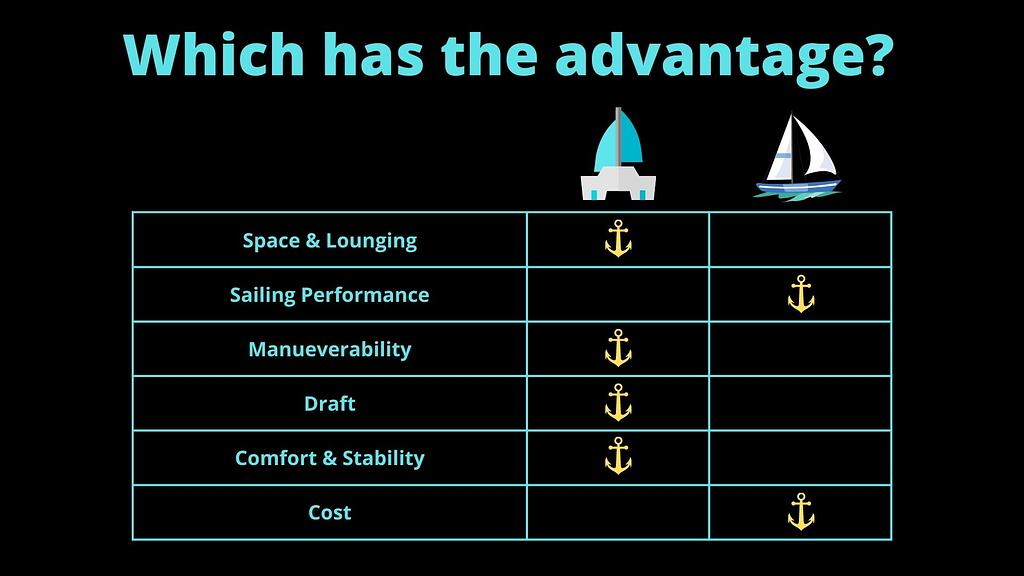
Space & lounging
Sailing performance, maneuverability.
- Comfort & Stability
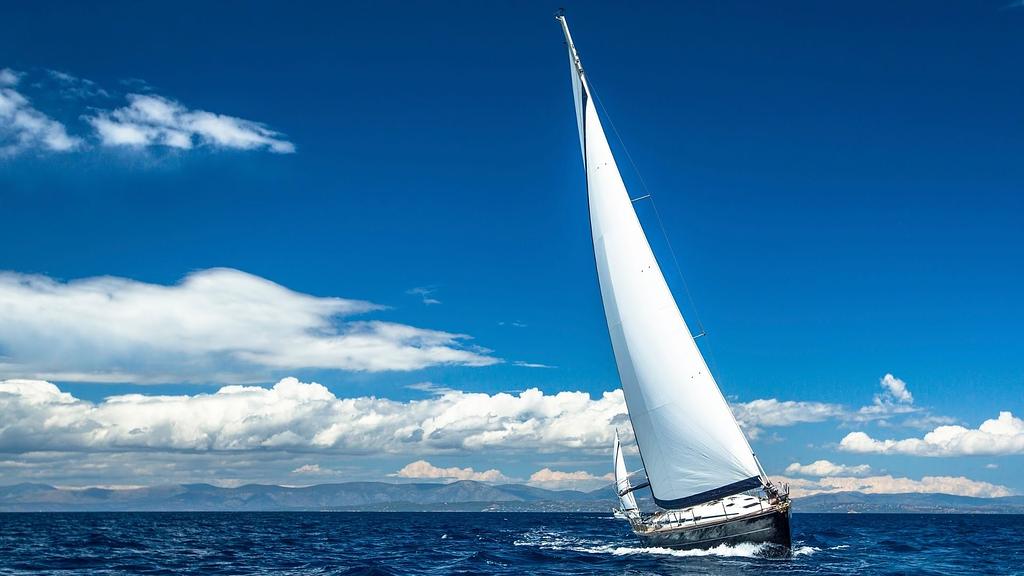
- Catamaran draft: ~4-5 feet
- Monohull draft: ~5-6 feet
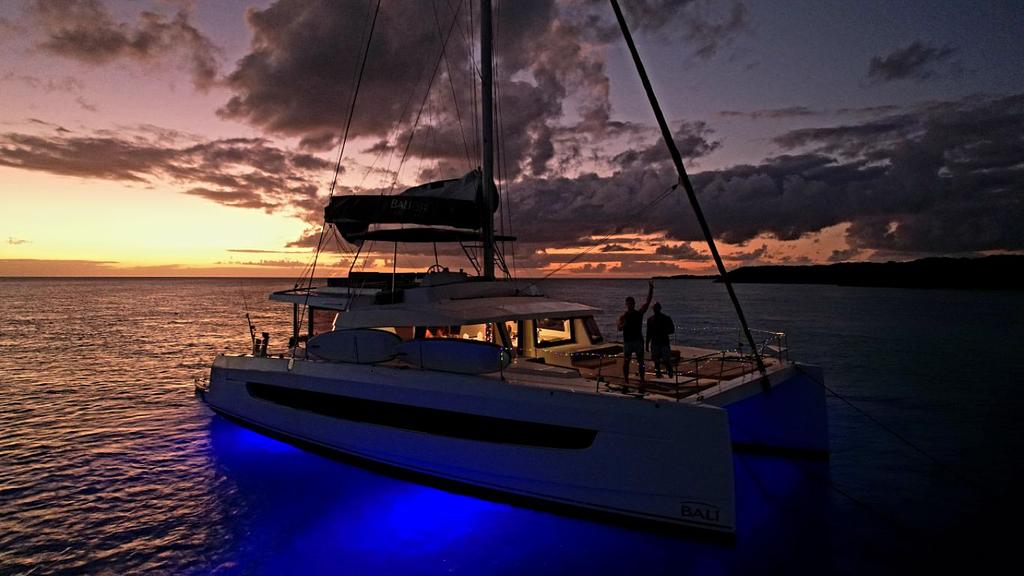
Comfort & stability
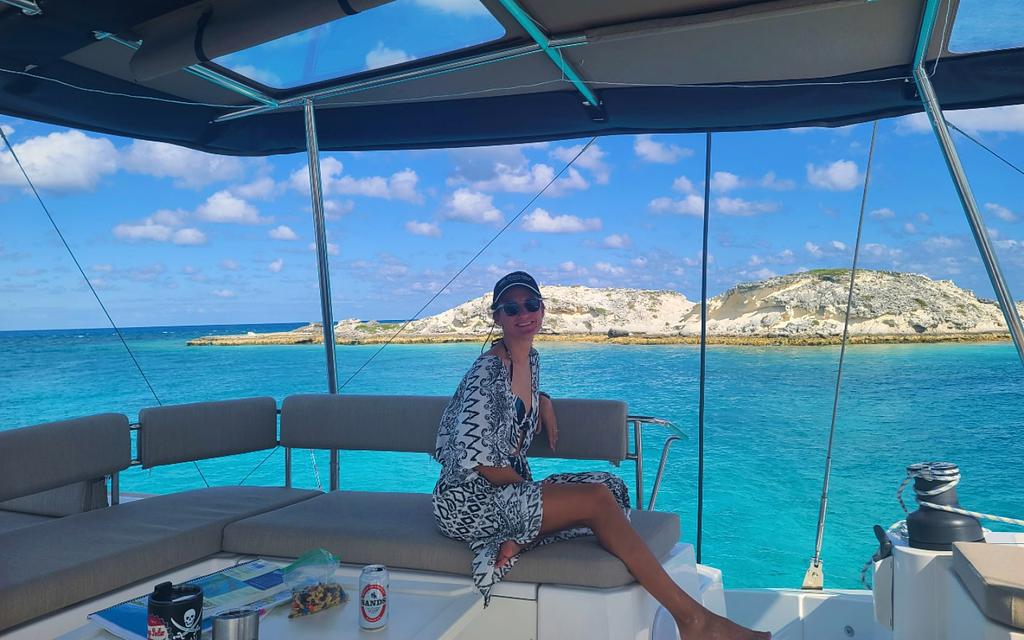
Explore these related articles from the Yacht Warriors
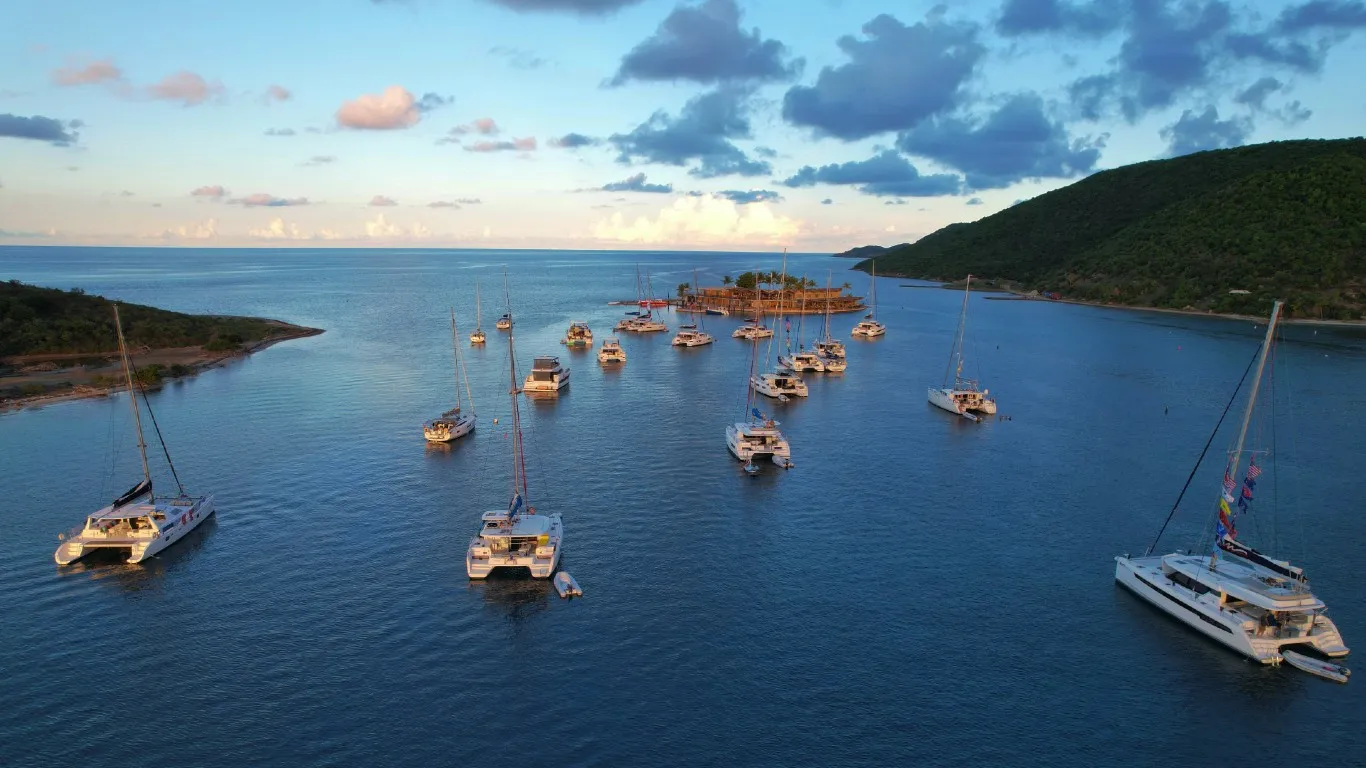
The complete sailing trip packing list- Here’s What to Pack
We've perfected our sailing trip packing list over the years. Here's what to pack on your next trip - the obvious, and maybe not so-obvious.
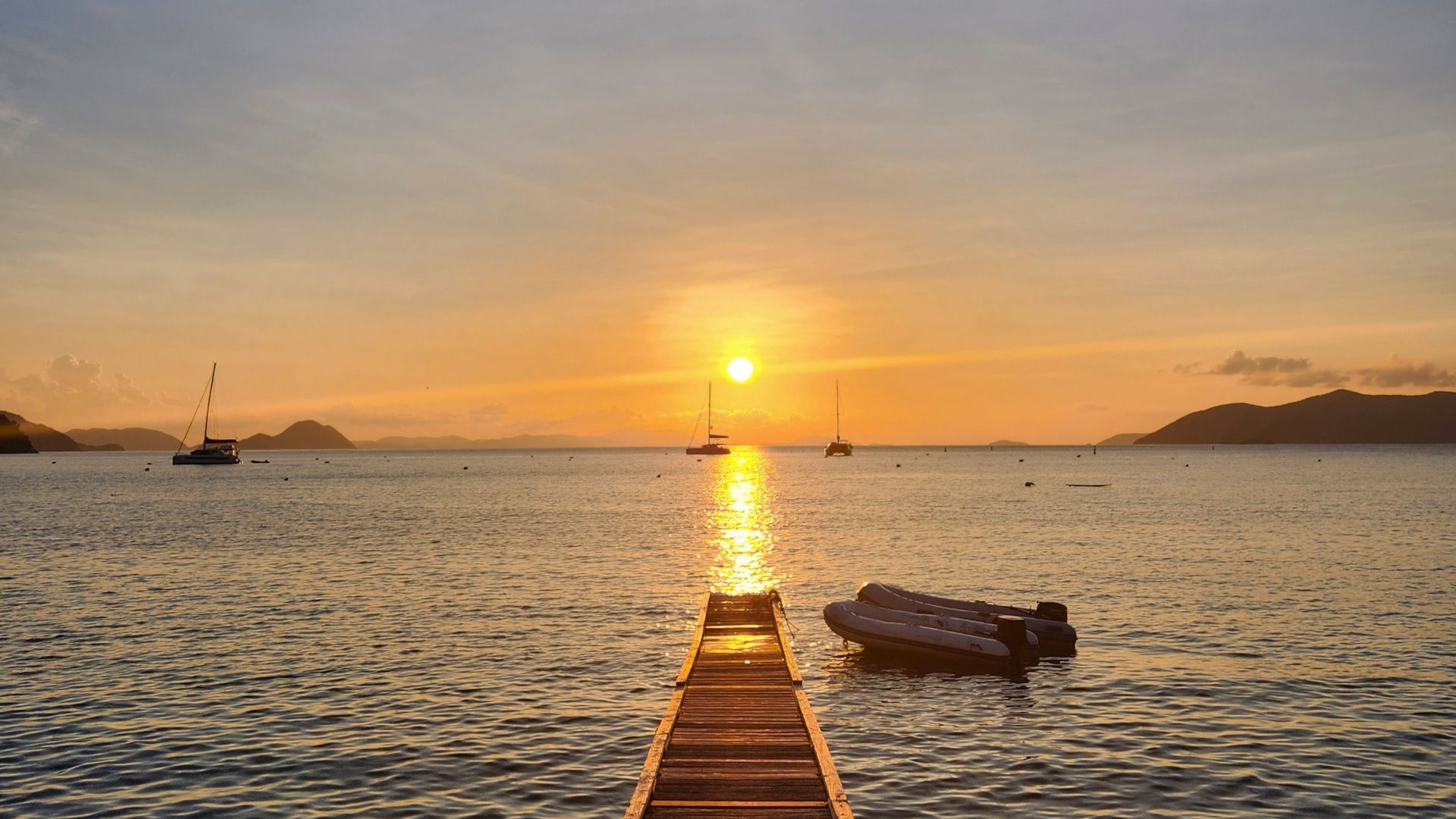
2024 BVI Charter Season Preview
Find out what's new for the 2024 BVI charter season including new catamaran additions and the latest need-to-know charter developments.
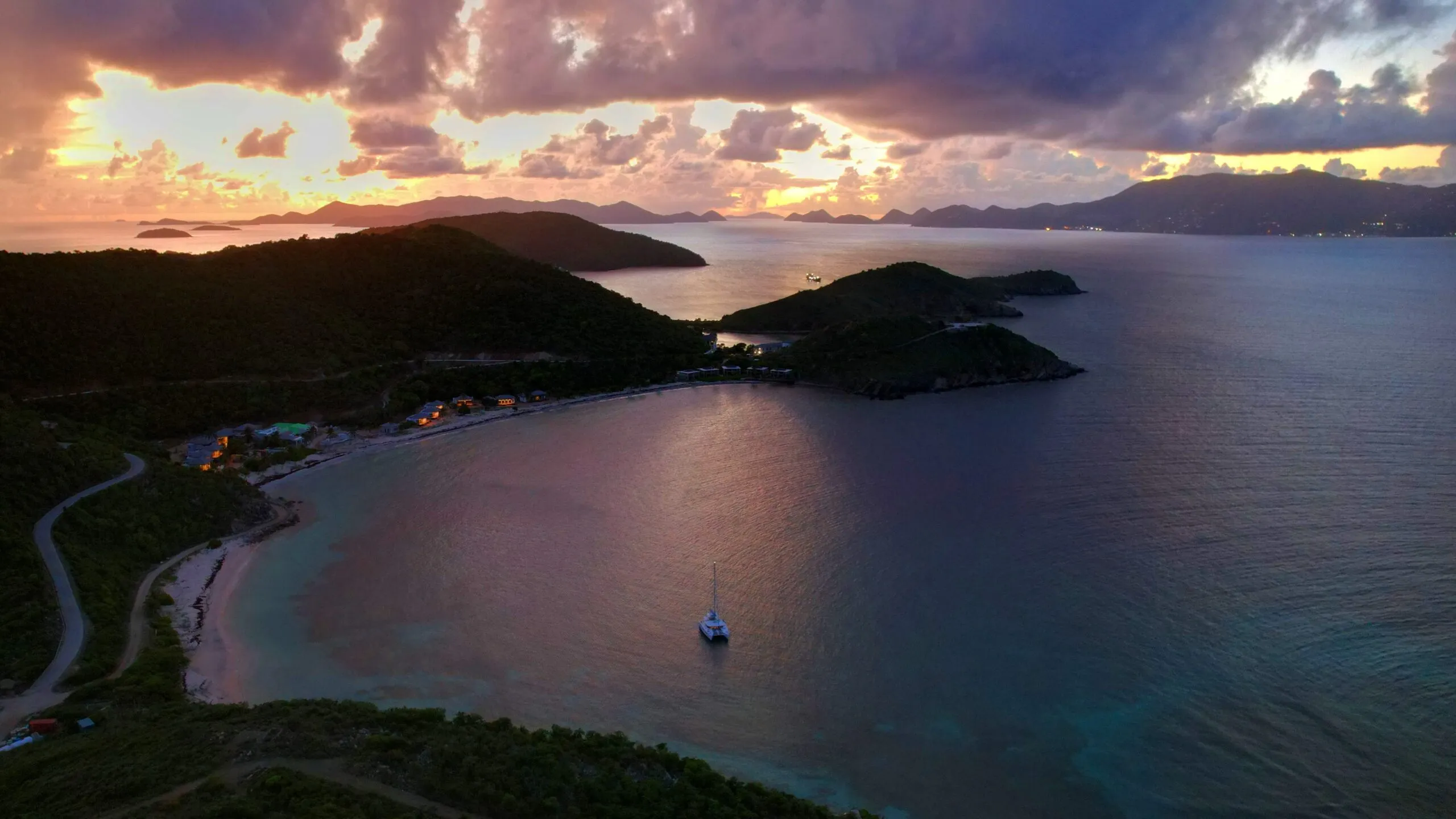
BVI Sailing Itinerary: The Perfect Week in the BVI
There is no better place for a sailing trip than the British Virgin Islands. Check out my perfect week-long BVI sailing itinerary.
When is your next yacht charter? Consider booking with the Yacht Warriors.
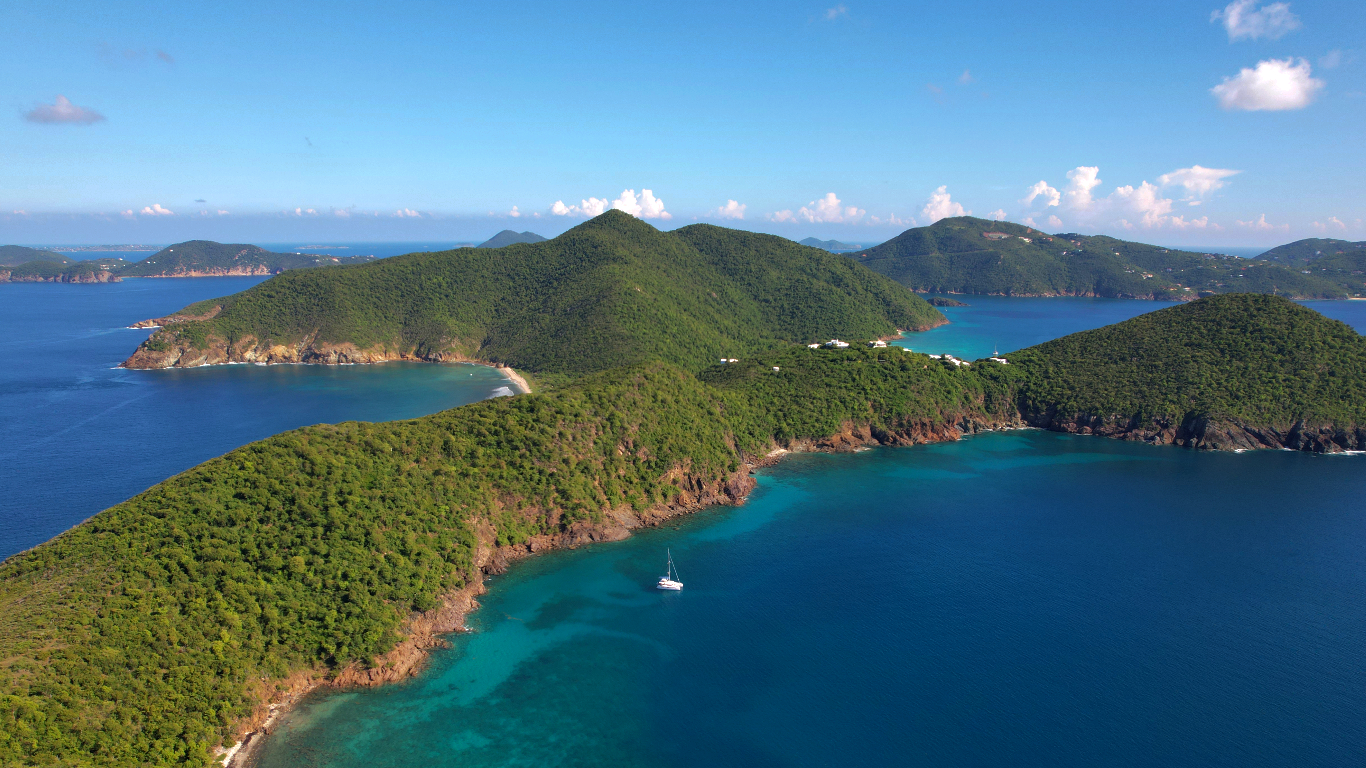
Charter. Beyond.
Get fresh ideas for your next yacht charter trip - insider guides, sailing itineraries, planning tips, and more. Subscribe and receive my free BVI Trip Planning Document.

MONOHULL VS CATAMARAN: A GUIDE TO SELECTING THE RIGHT HULL DESIGN
When it comes to selecting the perfect yacht design for motorboat owners, one crucial decision is whether to opt for a monohull vs catamaran. Each design has its own set of advantages and considerations, catering to different preferences and needs. In this article, we will explore the key characteristics and benefits of monohulls and catamarans, helping you make an informed decision when selecting your dream yacht.
1) Stability and Comfort:
Monohulls are known for their superior stability and ability to handle rough sea conditions. The deep keel design provides excellent stability, ensuring a smooth and comfortable ride for motorboat owners. Although monohulls may experience some natural rocking due to waves, many enjoy the traditional boating experience this offers.
Catamarans excel in stability due to their dual-hull design. The wider beam and separate hulls provide exceptional stability, minimizing rolling and ensuring a comfortable ride for motorboat owners. The absence of heeling makes catamarans particularly appealing to those who prioritize comfort and reduced motion.
2) Space and Accommodations:
Monohulls offer efficient use of interior space, providing generous accommodations for motorboat owners. The single hull design allows for deeper and wider cabins, offering ample headroom and storage options. Monohulls often feature a traditional layout, with a central saloon, galley, and separate cabins, ensuring comfort and privacy on board.
Catamarans provide expansive living spaces due to their wider beam and dual-hull design. Motorboat owners will appreciate the spaciousness and comfort offered by catamarans. They often have multiple cabins, larger saloons, and larger heads. The open layout seamlessly integrates indoor and outdoor areas, with wide decks, spacious cockpits, and trampolines for relaxation.
3) Maneuverability and Handling:
Monohulls are known for their maneuverability, particularly in tight spaces such as marinas or crowded anchorages. The deep keel design provides excellent tracking and control, making docking and maneuvering easier for motorboat owners. Single rudder configuration simplifies steering, ensuring responsive handling and precise control.
Catamarans, with their wider beam, may require some adjustment to maneuver in tight spaces. However, their shallow draft allows access to shallower anchorages and remote locations, expanding cruising possibilities. Catamarans often feature twin engines, providing enhanced maneuverability in confined areas. While docking techniques may differ, catamarans offer excellent stability and straight-line control.
4) Performance and Speed:
Monohulls are known for their excellent performance and speed on the water. Their streamlined hull design and deep keel allow for efficient hydrodynamics, resulting in faster speeds. Monohulls are particularly adept at cutting through waves and maintaining stability at higher speeds, offering thrilling and exhilarating experiences for motorboat owners who enjoy speed and performance.
Catamarans may not match the top-speed capabilities of monohulls, but they offer other advantages in terms of performance. Their wide beam and dual-hull design provide enhanced stability and reduced drag, resulting in better fuel efficiency. Catamarans excel in providing a smooth and comfortable ride, even at moderate speeds. They are well-suited for long-distance cruising, where the focus is on enjoying the journey and the surroundings rather than achieving maximum speed.
5) Maintenance and Cost:
Monohulls generally have lower maintenance costs compared to catamarans. The simpler construction and fewer systems to maintain contribute to reduced maintenance expenses. Hauling out for maintenance, repairs, and painting is typically straightforward and cost-effective for monohulls. Additionally, the availability of spare parts and a larger network of experienced technicians further support cost-efficient maintenance.
Catamarans may have slightly higher initial purchase prices and potentially require more regular maintenance due to their dual-hull structure. The additional systems and equipment onboard, such as twin engines and expanded living areas, can contribute to increased maintenance costs. However, the popularity of catamarans has led to a growing network of catamaran-specific service providers and a broader range of available spare parts.
Conclusion:
Choosing between a monohull vs catamaran for motorboat owners involves considering various factors to ensure the perfect yacht design. Monohulls offer stability, traditional boating experiences, efficient use of space, maneuverability, and generally lower maintenance costs. On the other hand, catamarans provide enhanced stability, spacious accommodations, comfortable rides, ample space for amenities, and maneuverability in shallower waters. Understanding your priorities, preferences, and budget will help you make an informed decision. Consulting with experienced yacht designers and fellow motorboat owners can provide valuable insights and assist you in selecting the ideal yacht design that aligns with your boating aspirations.
Click here to read about “SINGLE OUTBOARD VS TWIN OUTBOARD?”
Follow my Linkedin Newsletter here: “LinkedIn Newsletter”
0 comments Leave a reply
Save my name, email, and website in this browser for the next time I comment.
Recent Posts
- THE CHALLENGES Of SMALL CRAFT DESIGN COMPARED TO LARGER VESSELS
- UNDERSTANDING ROYALTY AGREEMENTS & DESIGN OWNERSHIP IN BOAT DESIGN
- FREQUENTLY ASKED QUESTIONS TO A BOAT DESIGNER: A COMPILATION
- ADVANTAGES OF HDPE COLLAR OVER REGULAR RIB
- HDPE’S EXCLUSIVE FEATURES DISTINCT FROM TRADITIONAL BOAT MATERIALS
Recent Comments
- Casey Lim on HDPE BOAT PLANS
- BRYN BONGBONG on HDPE BOAT PLANS
- Keith on HDPE BOAT PLANS
- Daniel Desauriers on WHY HDPE BOATS?
- November 2023
- October 2023
- February 2023
- January 2023
- September 2022
- January 2021
- ARTIFICIAL INTELLIGENCE
- boatbuilder
- BOAT CONSTRUCTION TECHNIQUES
- BOAT DESIGN COST
- boatdesign process
- CAREER PATHWAYS
- COMMERCIAL BOATS
- conventional boats
- custom boat
- DESIGN ADMINISTRATION
- DESIGN SPIRAL
- EXTREME CONDITIONS
- Freelance advantage
- freelance boat designer
- FRP Boat without Mold
- HDPE Collar
- INDIA'S MARITIME
- INVENTORY MANAGEMENT
- ISO STANDARDS
- Mass Production
- Monhull vs Catamaran
- Naval Architect
- Naval Architecture
- PLANING HULL
- Project Management
- Proven Hull
- PSYCHOLOGY OF BOAT DESIGN
- QUALITY CONTROL
- RECREATIONAL BOATS
- ROYALTY AGREEMENTS
- SANDWICH VS SINGLE SKIN
- SOLOPRENEUR
- YACHT DESIGN COURSE

Catamaran vs monohull

COVID 19: You can change your booking on most of our boats if your travel plans are affected by coronavirus. See here for more details
Let us help you plan the perfect sailing trip
Provide your travel details, receive free offer and enjoy your holiday!
A Catamaran sailboat has become a very popular type of boat to charter, offering comfort and a laid-back experience. But if you’re more interested in traditional sailing, you might want to consider a monohull sailboat. Adrenaline seekers will also have more fun sailing a monohull, especially under full sails. Read on to find out more about the difference between catamarans and monohulls.
Catamarans
A catamaran hull is the water tight body of the boat that allows it to float. Catamarans are multi-hulled vessels, which means they combine two or more hulls, also known as pontoons. A catamaran’s two-hull design offers a higher degree of stability and comfort in comparison to a monohull boat, which also helps in reducing seasickness. Catamaran sailboats are propelled by the wind, and can travel a lot faster than traditional sailing boats due to the needle-like monohulls or multihulls. A catamaran charter offers a great balance between sailing performance and comfort.
A Catamaran yacht offers more space both on deck and inside, making it an ideal choice for larger groups. A no sail catamaran, i.e. power catamaran, often offers a grand sundeck and sky lounge with a panoramic view of the sea. It also allows easy access to the water through the stern of the catamaran, which is great for all kinds of watersports. Catamarans offer a good level of stability thanks to the two hull design.
You don’t have to be a professional sailor to maneuver a catamaran. Its twin propellers and light weight make it very easy to handle. A catamaran sailboat usually has a smaller draft and is able to sail in shallow bays or closer to the beach. Another advantage of catamarans is that they have two separate engines which allow you to easily turn the boat around, and can come in handy in the unlikely event one of the engines fails. Catamaran sailing is as dangerous as sailing any type of sailboat if not handled properly, but if you’re a skillful sailor or have a knowledgeable skipper onboard, sailing a catamaran is a walk in the park.
Some monohull sailors claim that sailing a catamaran isn’t an authentic sailing experience. Unlike a monohull boat, catamarans won’t heel, which might be seen as a disadvantage if you’re a thrill seeker. Catamarans can be difficult to anchor, and take twice as much docking space as a monohull. Although catamarans are fast when sailing downwind, monohulls can be faster sailing upwind. Catamarans are usually more expensive to buy or rent and to moor and dock than monohull sailboats, but they do offer a lot for their price.
Monohull sailboats
Monohull sailboats are the most widespread type of boats out there. An important characteristic is their stability. A monohull sailing boat is almost impossible to capsize, making it extremely safe at sea. This stability is provided by the keel and ballast.
Sailboats are mostly equipped with one mast and two sails, but depending on the size of the sailboat can have more. The front sail can be rolled up and is called the genoa, jib, (genny jib) or rolfok. The rear sail is the main sail and can either be a conventional sail that is hoisted up the mast or a roll main sail that is rolled into the mast.
A big pro many monohulls have compared to catamarans is that when in motion they don’t pound or slap against the water. Catamarans with low bridge deck clearance from the water tend to hit and slap on the undercarriage in lumpy seas when sailing upwind. This can sometimes feel as though the boat is getting a beating.
When not using the sail, monohull sailing yachts are propelled by just one engine which can combine with a bow thruster on the front. The bow thruster is a small electric engine on the bow of the yacht that moves the bow sideways with the press of a button, making it easier to maneuver in tight spaces.
Sailing boats range in size from the smallest with only one cabin, such as the Seascape (a sailboat commonly used for sailing courses), to medium sized sailboats with two cabins, to the largest with six cabins. The saloon is used as a dining area and common room and can also double up for sleeping. If the saloon is used for sleeping, the table folds away and combines with the bench to create a large double bed.
Catamaran vs monohull charter options
A catamaran charter can be expensive. Prices vary depending on when and where you are chartering the catamaran, and also the age and model of the boat. There are two catamaran rental options:
- A sail catamaran, propelled by sails
- A power catamaran, powered by an engine.
A power catamaran can reach higher speeds, and often offers more space than a sail catamaran. The no-sail design offers more space and a better panoramic view of the sea, with no sails to block the view.
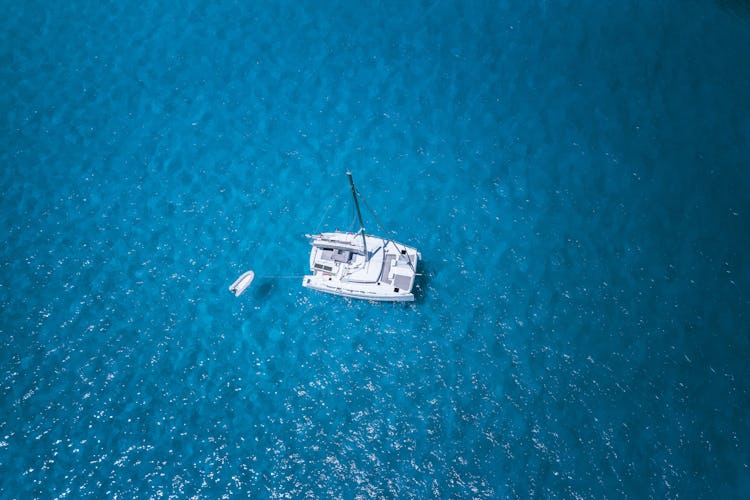
Skippered vs bareboat
A bareboat charter is a sailing boat rental that you sail by yourself, without a skipper or any crew members. You are in charge of everything, from navigation, sailing and mooring to cooking and cleaning. At least one member of your group must be an experienced sailor with a valid licence. Bareboat sailing is also the cheapest option. Bareboat charters offer the freedom to explore the sea wherever and whenever your heart desires. It’s a great way to have a truly unique holiday.
If comfort and relaxation are top priorities on your vacation, you might want to consider a skippered charter. You won’t need a license and your skipper will steer the boat, decide on the best route and keep you safe! Skippers are carefully chosen individuals that aren’t only known for their sailing skills and experience, but also for being very knowledgeable about the area and destinations you’ll be visiting. They often act as your personal local guide. On top of all that your skipper will share tips on how to become the best possible sailor. Skippered sailing charter is the best option for less experienced sailors.
Catamaran vs monohull: interiors and layouts
Catamarans have an eye-catching exterior due to their two-hull design, but are also very impressive on the inside. On the exterior they have a flybridge with a helm station, offering 360-degree views of the sea, a spacious main seating area, and an easily accessible sunbathing platform. Layouts are often open, with a well-equipped L-shaped galley connected to a dining area consisting of comfortable seating and a table. Behind the seating, there are usually glass doors that open to an aft cockpit where you can watch sunsets and sunrises. Below deck, you’ll find cabins with double beds and bathrooms. All in all, a catamaran’s biggest advantages are its open layout and awesome panoramic views you can enjoy from every part of the boat.
Here are your catamaran options:
- 3 cabin catamaran - ideal for three individuals or three couples. This cat comes with a kitchen, sitting area and a few restrooms.
- 4 cabin catamaran - this cat includes a sitting area, multifunctional kitchen, four bedrooms and a few restrooms.
- 5 cabin catamaran - this cat comes with four larger bedrooms and one smaller one. It has a bigger kitchen and a large sitting area with a nice deck where you can enjoy dinner under the stars.
- 6 cabin catamaran - this cat offers large bedrooms and a big deck.
- 7 cabin catamaran - king’s catamaran offering maximum comfort for you and your crew. Comes with a fully equipped kitchen and a large beautiful deck.
- 8 cabin catamaran - traveling in a large group, or part of a big family? We’ve got you covered with the largest catamaran in our fleet, this cat is the definition of comfort and is called a ‘house on water’ for a reason!
Monohull interior options:
- 1 cabin sailboat - ideal for couples and adrenalin lovers. This sailboat wasn’t built for long travels. It comes with one restroom and a small kitchen.
- 2 cabin sailboat - great for couples with children. Comes with a comfortable lounge area.
- 3 cabin sailboat - if you have two or more children, this is the perfect choice for you! Comes with two restrooms, a kitchen and a lounge area.
- 4 cabin sailboat - if you’re spending your holiday with friends and family, this is the right choice for you. It comes with a big sitting area, two restrooms and a big kitchen.
- 5 cabin sailboat - big kitchen, grand sitting area and three restrooms make this sailboat ideal for larger groups.
- 6 cabin sailboat - king of our sailboat fleet. If you’re looking for uncompromising comfort this is the sailboat for you!
Best catamaran and monohull destinations
Whether you’re a seasoned sailing purist who will never abandon your loyalty to monohulls, or a catamaran fan prioritising space and stability, all sailors can agree on one thing – there’s no such thing as a bad day on the water. Every experience is different from the last, and the opportunity for new adventures is infinite. There’s certainly no shortage of phenomenal places to sail to, but here are a few of our favourites:
- Mediterranean - the picturesque and idyllic landscape of the Mediterranean, with plenty of ports and favorable winds, attracts sailors all year round. Famous destinations are the Balearic Islands, the Amalfi coast and the Ionian Islands.
- British Virgin Islands - known as the mecca for sailing, with its numerous islands that are rich in culture. Its weather conditions make it ideal for sailing all year around.
- Caribbean - warm winds, crystal clear water and the reflection of the moon on the midnight waves make the Caribbean a unique destination for sailing enthusiasts.
In conclusion
The choice of a monohull vs catamaran comes down to a personal preference and budget. If you’re traveling with a large party or you want an easy laid-back experience, catamarans are the way to go. If you’re looking for an adrenaline-rushed adventure, a monohull might suit you better.
Catamaran vs Monohull in Rough Seas: Which is Better?
Catamarans and monohulls have different designs that affect how they handle rough sea conditions. In fact, they have an advantage over each other when sailing in heavy seas. Let's try to compare each type of vessel based on their performance, design, and stability, to help you decide which can give you a safer and more comfortable journey on the open water.
Regarding speed, efficiency, and stability, a catamaran may be the better option for you. Because they have twin hulls, they are more comfortable to sail in rough seas. A monohull can become more advantageous in rough seas when sailing upwind since it can point higher into the wind and can handle strong winds easily.
Catamarans with two rudders also allow for better control and maneuverability in rough seas compared to monohulls, which only have one rudder. Let's look at more of the comparison between these two types of boats when sailing through big waves in the sea.
- When it comes to stability and comfort, catamarans can provide more stability. They are also less likely to cause seasickness and offer more living space and privacy.
- In terms of speed, catamarans are also faster than monohulls because they have a smaller displacement. Their structure also makes them less likely to capsize or sink.
- A monohull is advantageous when it comes to sailing upwind, and handling stronger winds. Their deep keel also provides them with increased stability and reduces drag, which can be an advantage in rough seas.

Catamarans Vs. Monohulls in Rough Seas
If you're planning to buy a boat, and you're deciding whether to go for a catamaran or a monohull, one of the many things you may need to consider is how they perform in rough seas. Rough seas can be challenging for any vessel, but some boats are better equipped to handle them than others. Below is a table summarizing how well these boats perform in rough seas:
A catamaran is a boat with two hulls connected by a deck. Because they have two hulls , catamarans are known for their speed, stability, and spaciousness. They are often used for cruising and chartering, as well as racing. They also have a wider beam than monohulls, which means they offer more living space and stability. They are less likely to heel or tilt to one side, are more buoyant, and have a shallow draft.
On the other hand, monohulls are the most common type of boat with only one hull. They are known for their simplicity, versatility, and affordability. Monohulls are often used for day sailing, racing, and cruising.
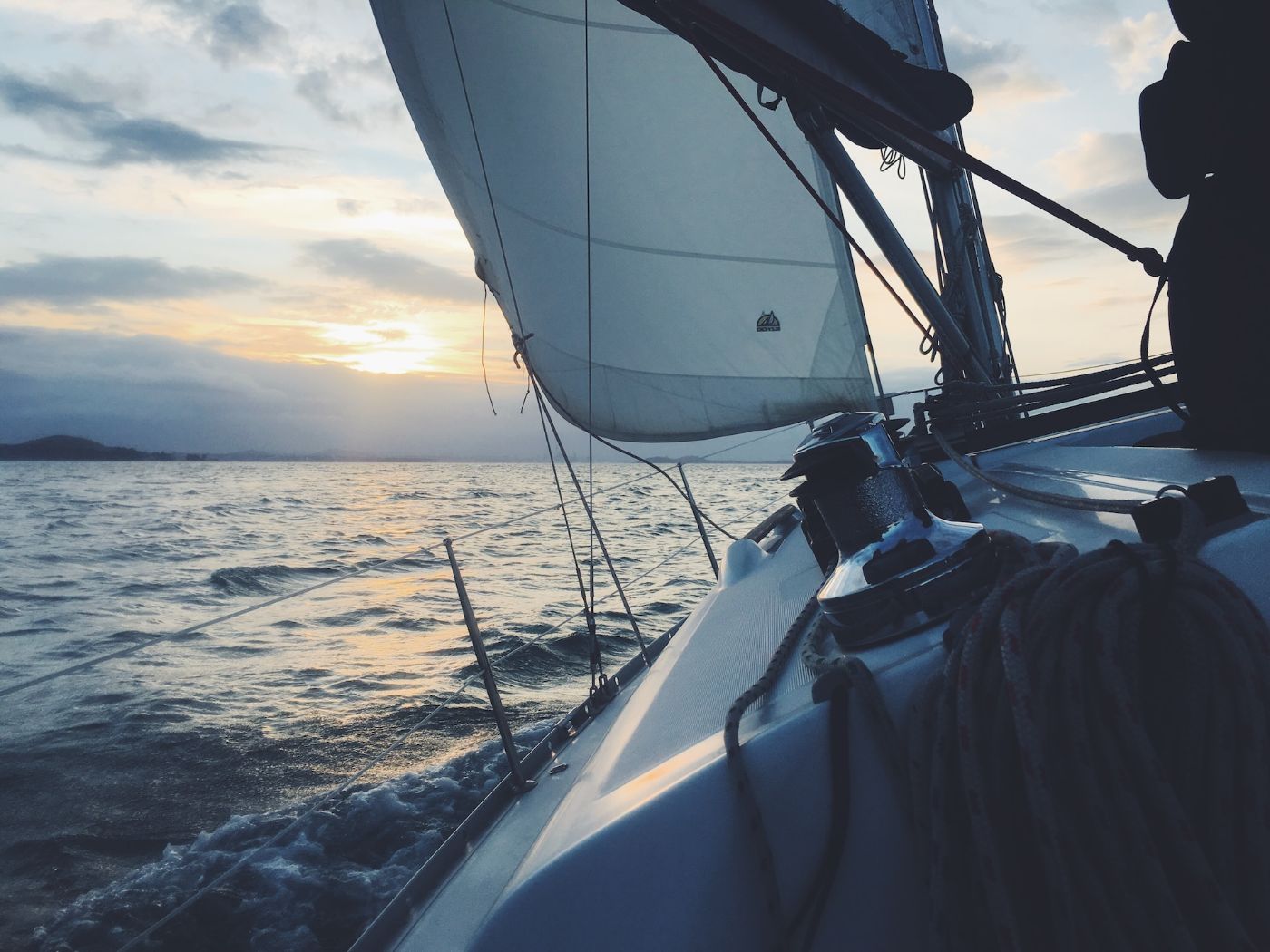
When it comes to rough seas, catamarans are generally more stable than monohulls in terms of roll stability. Monohulls, on the other hand, are better at handling heavy seas and high winds, but they can be more prone to rolling and pitching, and can significantly heel more than a catamaran.
If you are aiming for speed, efficiency, and stability, then a catamaran may be the better option for you. They are generally faster and more efficient due to their twin hulls, and their stability can make for a more comfortable ride in rough seas.
On the other hand, if you prioritize upwind sailing performance, sailing feels and responsiveness, and the traditional look and feel of a sailboat, then a monohull may be the better option for you. Monohulls sail closer to the wind and have a unique feel to them that some sailors prefer.
Detailed Comparison Between Catamaran And Monohull
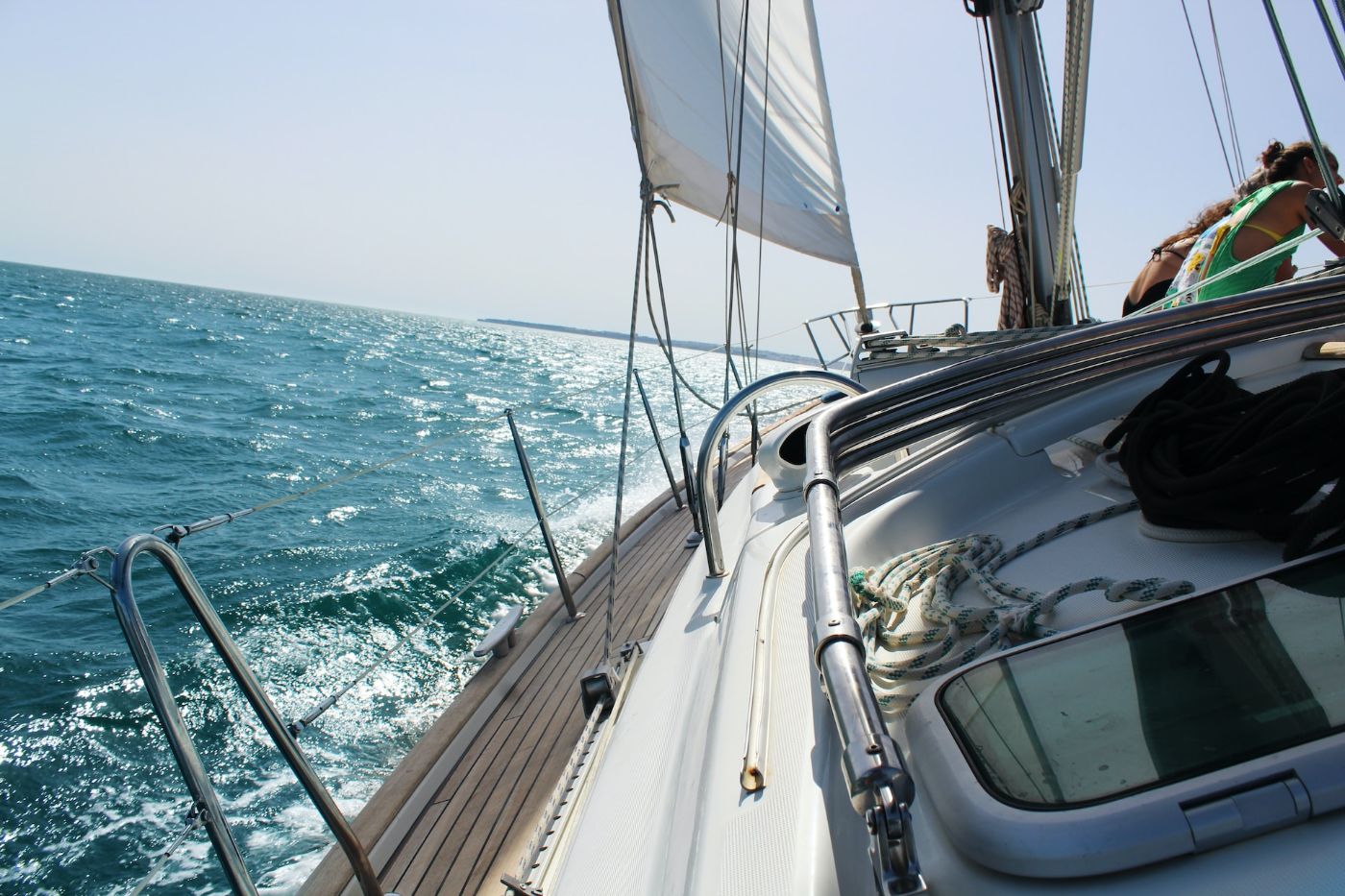
Catamarans provide better stability and comfort
Catamarans are more stable, less likely to cause seasickness and offer more living space and privacy. Below is a table summarizing why catamaran is more advantageous in this category:
In terms of motion in rough seas
Catamarans are more stable in rough seas because they have two hulls instead of one. This means that they are less likely to roll or heel, which can make for a more comfortable ride. Monohulls, on the other hand, tend to pitch and roll more in rough seas.
In terms of handling seasickness
If you are prone to seasickness, a catamaran may be a better choice for you. The stability of a catamaran means that it is less likely to cause seasickness than a monohull. Additionally, the living space on a catamaran is often spread out between the two hulls, which can help to reduce the feeling of confinement that can contribute to seasickness.
In terms of living space and privacy
Catamarans also tend to offer more living space and privacy than monohulls. Because the living space is spread out between the two hulls, each hull can function as a separate living space. This can be especially beneficial if you are traveling with a group of people and want to have some privacy.
Both boat types have specific advantages in performance and speed
A catamaran is generally faster and more stable than a monohull, but a monohull can be easier to handle in certain conditions.
In terms of navigating upwind
When sailing upwind, a monohull has the advantage over a catamaran due to its ability to point higher into the wind. This means that a monohull can sail closer to the wind than a catamaran, which will need to tack more often. However, a catamaran can make up for this disadvantage with its speed. A catamaran can sail faster than a monohull , which can help it to cover more distance in less time.
In terms of handling strong winds
In strong winds, a catamaran is generally more stable than a monohull due to its wider beam. This means that a catamaran is less likely to heel over, making it more comfortable for passengers. However, a monohull can be easier to handle in strong winds due to its ability to reef the sails. By reducing the sail area, a monohull can reduce the amount of wind it catches, making it easier to control.
Catamarans and monohulls have different designs and function
Catamarans offer more deck and cabin space, shallow draft, and increased buoyancy, while monohulls have a deeper draft, reduced drag, and increased stability.
In terms of the deck and cabin space
One of the advantages of catamarans over monohulls is their wider beam, which provides more deck space. This means more room to move around and increased stability, which is important in rough seas.
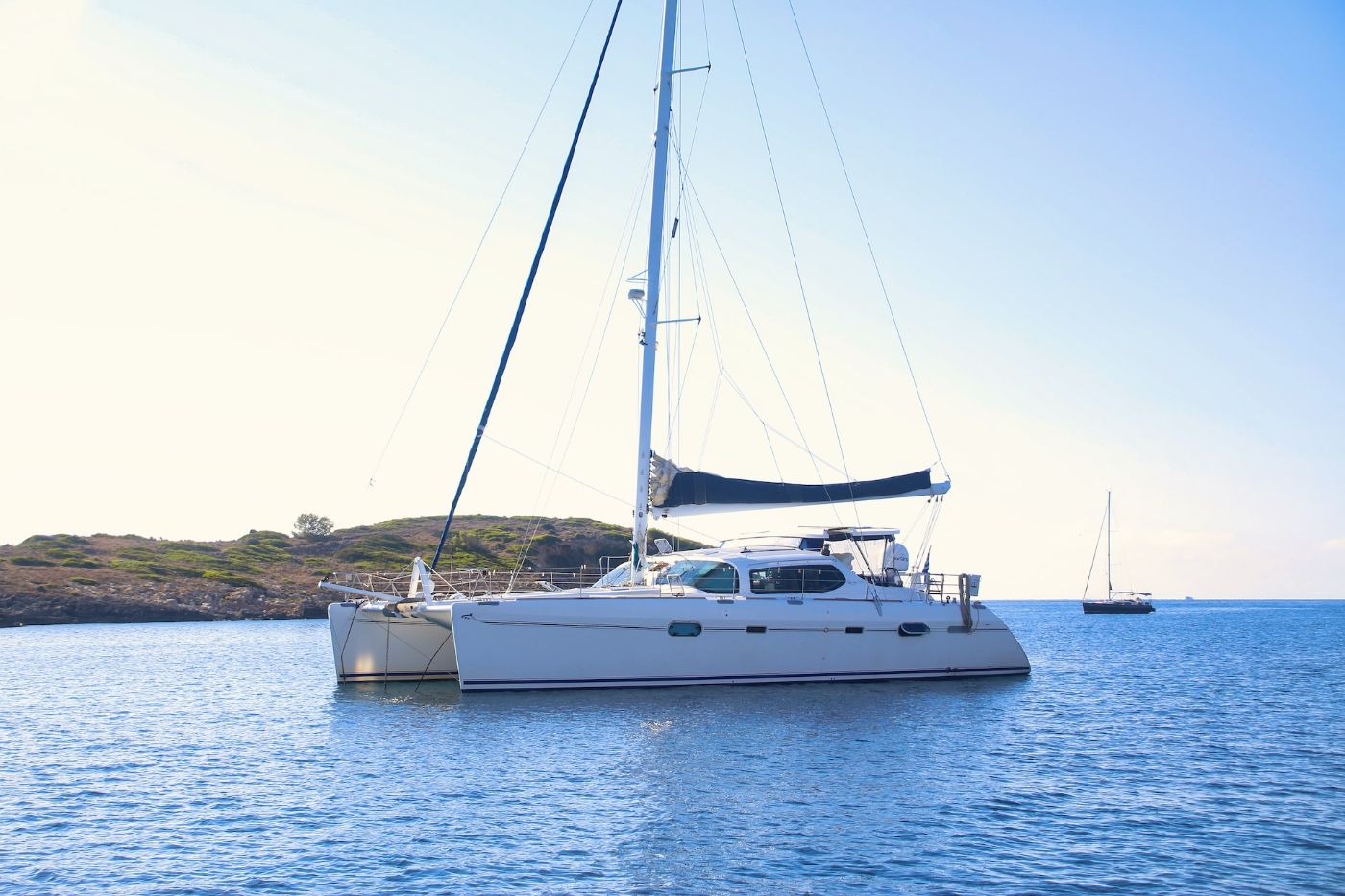
Additionally, catamarans usually have two hulls, which means more cabin space and privacy for the crew and passengers. On the other hand, monohulls have a single hull, which means less deck and cabin space. However, monohulls usually have a deeper draft, which allows them to sail closer to the wind and tack more efficiently.
In terms of draft and buoyancy
Catamarans have a shallow draft, which means they can sail in shallow waters and anchor closer to shore. This makes them ideal for exploring shallow coves and bays. Also, catamarans have two hulls, which provide increased buoyancy and stability in rough seas.
Monohulls, on the other hand, have a deeper draft, which makes them less suitable for shallow waters. However, their deep keel provides increased stability and reduces drag , which can be an advantage in rough seas.
Both boat types have unique safety considerations
Safety is a top priority when sailing in rough seas. Catamarans are generally more stable and easier to control, while monohulls have a greater risk of capsizing but are also more maneuverable in certain situations.
In terms of the risk of capsizing
One of the biggest safety concerns when sailing in rough seas is the risk of capsizing. Catamarans have two hulls, which make them more stable than monohulls. This means that they are less likely to capsize in rough seas. Catamarans are also technically unsinkable , meaning that they will not sink even if one hull is damaged or flooded.
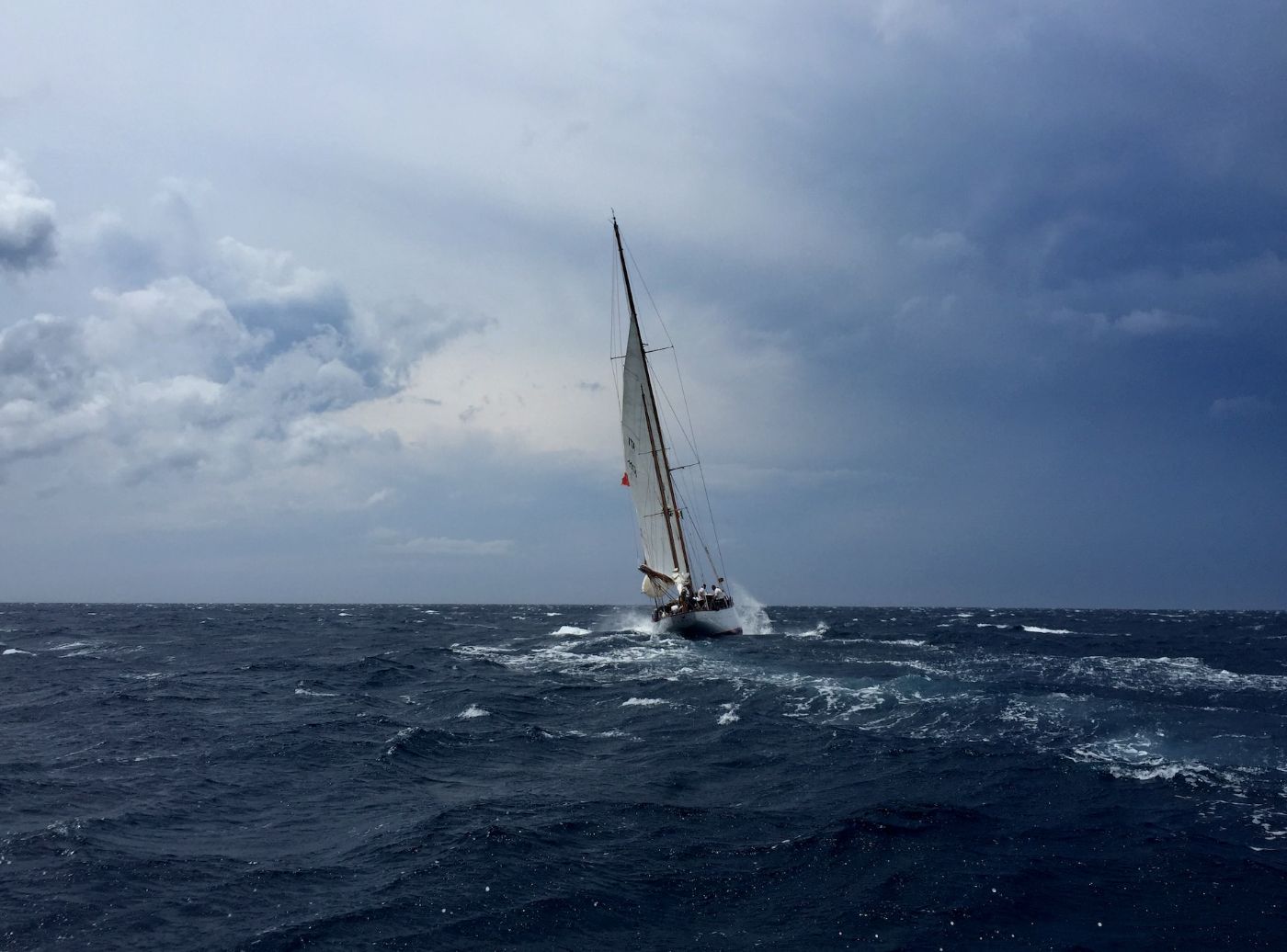
On the other hand, monohulls have a keel and ballast, which provide stability but also increase the risk of capsizing. If a monohull capsizes, it can be difficult to right the boat and prevent it from sinking.
In terms of navigational control
Catamarans have two rudders, which provide additional control and maneuverability in rough seas. This means that you can steer the boat more easily and avoid obstacles like rocks and other boats. Meanwhile, a monohull only has one rudder.
However, despite the number of rudders involved, the ability to control and maneuver the boat, whether a catamaran or a monohull, still depends on the design and construction of the boat, as well as the skill of the captain and crew in handling the boat.
Other practical considerations when choosing between catamaran and monohull
In terms of docking and anchorage.
Docking and anchorage can be easier with a catamaran due to the wider beam, which provides more stability. However, catamarans can be more difficult to maneuver in tight spaces due to their size. On the other hand, monohulls are generally easier to maneuver in tight spaces, but they may be less stable in rough seas.
For docking costs, catamarans tend to have higher docking rate costs due to their size and wider beam. Read this article to know more about the costs of docking a catamaran in different locations.
In terms of storage and equipment
Catamarans typically have more storage space than monohulls due to their wider beam and larger deck area. This means they can carry more gear and supplies, making them a good choice for longer voyages or liveaboard situations. They can accommodate larger equipment such as dinghies, kayaks, and paddleboards - making them a great choice for water sports enthusiasts who want to bring their gear along.
Monohulls, on the other hand, have less storage space due to their narrower beam and smaller deck area. This means they are better suited for shorter trips or day sailing, where less gear and supplies are needed. Monohulls may also be better suited for certain types of equipment, such as fishing gear or diving equipment, due to the layout of the boat.
In terms of crew accommodations
Catamarans tend to have more spacious accommodations than monohulls, which can be an advantage for longer trips or when traveling with a larger crew. However, monohulls may offer more privacy for individual crew members due to the separate cabins and tighter quarters.
Catamarans generally have more living space than monohulls so they can offer more room for sleeping, lounging, and cooking, which can be especially beneficial for larger crews or families. They also often have large, open salons and cockpits that allow for easy socializing and entertaining. This can be a great feature for crews who enjoy spending time together.
Monohulls, on the other hand, have less living space than catamarans due to their narrower beam. This means they may be better suited for smaller crews or shorter trips. They often have cabins located closer together, which can make it easier to communicate and work together as a crew, which is a plus for racing or cruising in crowded areas.
Choosing boat type based on personal preferences
In terms of aesthetics and personal taste.
One of the first things that come to mind when choosing between a catamaran and a monohull is aesthetics. Both types of boats have their unique look, and it is up to personal preference which one you find more appealing. Some people prefer the sleek and modern look of a catamaran, while others prefer the classic look of a monohull.
Another thing to consider is personal taste. If you are someone who prefers a more spacious and open boat, then a catamaran might be the right choice for you. On the other hand, if you prefer a more traditional sailing experience, then a monohull might be the better option.
In terms of suitability for families and couples
Basically, catamarans are known for their stability and spaciousness, making them a great choice for families with children or couples who want to have more space and privacy.
Monohulls, on the other hand, might not be as spacious as catamarans, but they offer a more traditional sailing experience. If you are a couple or a small family who wants to experience the thrill of sailing and doesn't mind being in close quarters, then a monohull might be the right choice for you.
Leave a comment
You may also like, cost of catamaran vs. monohull: which is more expensive.
The market for monohull sailboats is a lot bigger than that of catamarans, which is one of the reasons why they are so much cheaper.
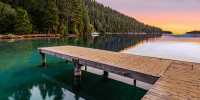
How Much Does It Cost to Dock a Catamaran? (7 Locations)
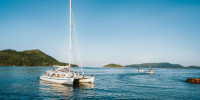
The Perfect Size Catamaran to Sail Around the World

17 Sailboat Types Explained: How To Recognize Them
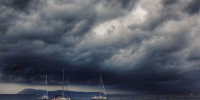
What Type of Hull Handles Rough Water the Best?
Own your first boat within a year on any budget.
A sailboat doesn't have to be expensive if you know what you're doing. If you want to learn how to make your sailing dream reality within a year, leave your email and I'll send you free updates . I don't like spam - I will only send helpful content.
Ready to Own Your First Boat?
Just tell us the best email address to send your tips to:

IMAGES
VIDEO
COMMENTS
A new cruising monohull starts around $200,000 to $250,000, while a new cruising catamaran starts at $350,000 and sometimes exceeds $500,000. Used catamarans and monohulls run between $10,000 and $200,000 or more. In this article, we'll cover the average costs of monohulls and catamarans, along with why these sailboats differ in price.
Catamarans don't coast well primarily because they don't have a deep keel to track. Relying on coasting to a dock at a shallow angle and then going into reverse and using prop walk to cozy up the stern won't work. It is better to come in at a sharper angle and then pivot the boat into position with the engines.
On average, catamarans are $50,000-$70,000 (19-66%) more expensive to buy than monohull sailboats when new. Second-hand, the difference is even larger, ranging from 62-220% more expensive. The annual cost is roughly 60% higher than that of monohulls. There are multiple reasons for these large price differences, which I'll go over in detail ...
The choice of catamaran vs monohull ultimately comes down to preference. What's critical for one buyer may mean little to another. If your partner refuses to set foot on a boat which heels, that's a deal-breaker for a monohull. ... Price point: Catamarans are more difficult to build and need more materials. This is directly reflected in the ...
7. Shallow Draft Equals Better Anchorages. Catamarans have significantly shallower drafts than monohulls, allowing for safer anchorages closer to shore. Most catamarans in the 40-ft to 50-ft range draw between 3-ft to 4.5-ft, so they can anchor in places that a monohulls can not even consider.
Catamaran vs Monohull Safety. Safety while out there on the water is one of the most critical things that any sailor should have in mind when choosing the type of boat to use. Catamarans. Catamarans shine on many aspects of safety. They're generally more stable and seem to have natural buoyancy since they don't have ballast and this makes them ...
Monohulls have a single hull, and catamarans have two hulls side-by-side. Catamarans are faster than monohulls of the same length and displacement, but monohulls are stronger and more spacious. Monohulls are also cheaper and easier to build than multi-hulls. In this article, we'll cover the differences between catamarans and monohulls, along ...
Speed. In the catamaran vs monohull speed debate, it might be more of a draw. Catamarans are typically 25-30% faster than a comparable monohull, but some argue that it comes at a price. When catamarans are sailing full speed you might experience a lot of slapping from the waves. Monohulls are designed to cut through the water.
When it comes to the cost of a sailing vessel, there are many factors to consider. Let's take a closer look at how monohulls vs. catamarans stack up. First off, monohulls are generally considered to be more affordable than catamarans, both in terms of the initial purchase price and ongoing maintenance costs.
Catamaran vs. monohull power. A monohull under auxiliary power may be faster than a catamaran in certain conditions, like powering against a strong wind. In other wind and wave conditions, the catamaran is often faster. Also, with an engines on each hull, the cat is often much more maneuverable in close quarters or at the marina.
If you buy new, you're looking at a starting price of about $250,000. For a brand new 40ft cat, you're looking at a starting price of about $400,000. Of course, you can buy a used, older catamaran, too. There's the Prout Snowgoose 37, the Lagoon 380, and the PDQ 36. Any of these can be purchased for under $90,000.
They are often more cost-effective in terms of initial purchase price and maintenance expenses. Monohulls also provide more options for docking in marinas with narrower slips. ... The safety of monohulls vs. catamarans is a topic that can vary depending on several factors. It is important to note that both types of vessels have their own safety ...
In this round we're covering PRICE & PERFORMANCE. The great debate continues in part 2 when we compare: CAT VS MONO - COMFORT & SAFETY. There really is no such thing as a perfect boat. We all agree that the best boat is the one you can afford, maintain and get out cruising in. If you have the cash to purchase a small monohull now, then don ...
Catamaran boats also feature shallower draft, smaller displacement, and less hull volume than monohull boats. Therefore, this boat is more spacious than a monohull boat. It should be what you're looking for if you're sailing with family or friends. On the other hand, monohull boats provide limited space, and most spaces are below the waterline.
Catamaran vs Monohull Safety. The mono gives lots of feedback about being overpowered long before it becomes a problem: heel angle and weather helm are the loudest. ... This article was written in the spring of 2022, just before the crazy increase in fuel prices. As of publication date, these numbers need to be adjusted higher by about 50-100%.
Catamaran vs Monohull. Last Updated on Thu, 29 Jun 2023 ... 100 years ago, could race against each other back to port and offer the freshest catch at the highest price. Just as in history, speed of a sailing yacht is important and gives a faster yacht more options. above The new, all infusion-built, Fountaine Pajot - Lavezzi 40, powering along ...
In the catamaran vs monohull price debate, the monohull gets the definite advantage. When chartering a catamaran, all costs are higher. The rental fee can be between 50-100% higher than for the same size monohull and marinas, and port fees can higher than for the same size monohull.
Which sailboat is best: Catamaran or Monohull? We have our friends Ruby Rose visiting and we're taking about sailings biggest debate: cat vs mono.MORE DEETS ...
If you are sailing in the British Virgin Islands, this probably won't matter much since most navigation is line of sight in relatively deep water.The anchorages are also less shallow. However, if you are planning a trip to the Exumas Bahamas, the shallower waters will make a difference.You will most certainly be able to access some anchorages in a catamaran that you would want to avoid in a ...
Catamarans may have slightly higher initial purchase prices and potentially require more regular maintenance due to their dual-hull structure. The additional systems and equipment onboard, such as twin engines and expanded living areas, can contribute to increased maintenance costs. ... Choosing between a monohull vs catamaran for motorboat ...
Catamaran vs monohull charter options A catamaran charter can be expensive. Prices vary depending on when and where you are chartering the catamaran, and also the age and model of the boat. There are two catamaran rental options: A sail catamaran, propelled by sails; A power catamaran, powered by an engine.
Maneuverability. Catamarans have great control when it comes to maneuvering in tight places. Since they have twin engines and rudders, you get a lot of control and can turn pretty much 360 degrees ...
Catamarans Vs. Monohulls in Rough Seas. If you're planning to buy a boat, and you're deciding whether to go for a catamaran or a monohull, one of the many things you may need to consider is how they perform in rough seas. Rough seas can be challenging for any vessel, but some boats are better equipped to handle them than others. ...